
- •Contents
- •1. Overview of the Immune System
- •2. Cells of the Immune System
- •4. Lymphocyte Recirculation and Homing
- •5. The First Response to Antigen
- •12. Acquired Immunodeficiency Syndrome
- •14. Transplantation Immunology
- •1. General Microbiology
- •2. Medically Important Bacteria
- •4. Medically Important Viruses
- •5. Medically Important Fungi
- •8. Comparative Microbiology
- •Index
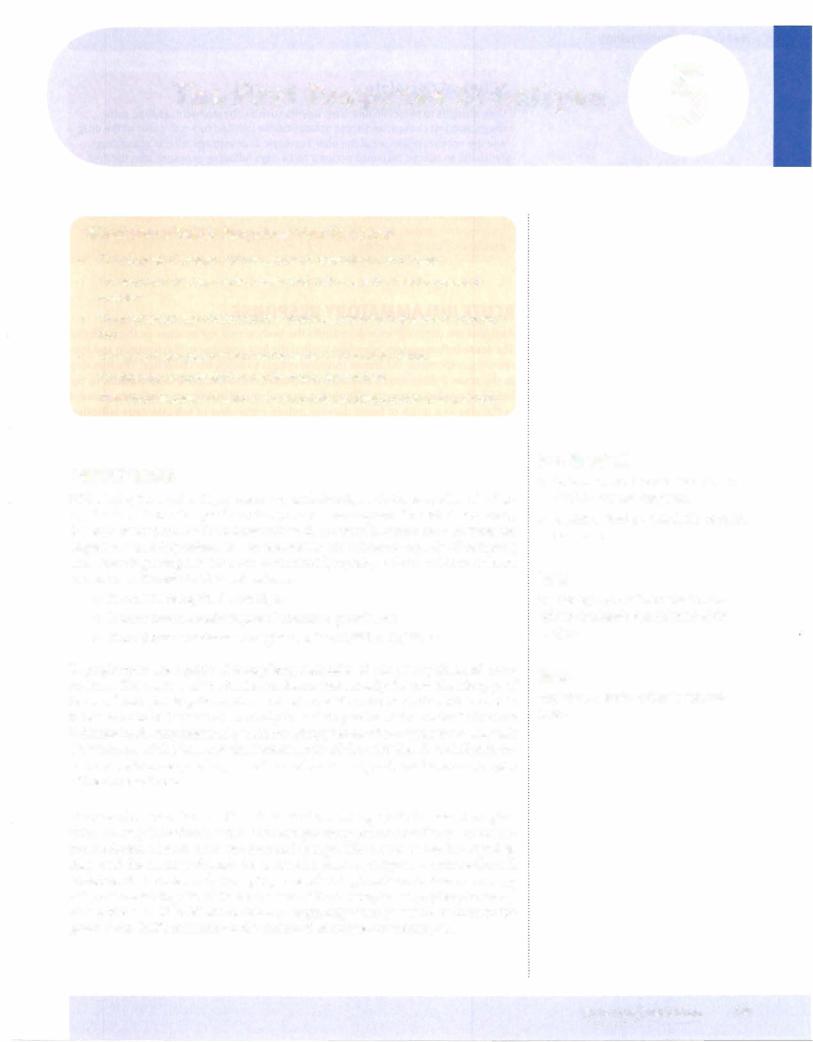
The First Response to Antigen |
5 |
What the USMLE Requires You To Know
•The meaning of antigen, epitope, antigenic determinant, and hapten
•The sequence of inflammatory events and their role in the initial response to invasion
•The mechanism and chemoattractive molecules involved in phagocyte extravasa tion
•The steps of phagocytosis and mechanisms of intracellular killing
•The meaning of opsonization and the molecules involved
•The clinical sequelae of defects in chemotaxis and phagocytosis (LAD and CGD)
DEFINITIONS
Historically, the word antigen was meant to designate a substance capable ofinduc ing the formation of a specific antibody: an antibody-generating substance. Today the word is used almost interchangeably with the word immunogen--an immune response-generating substanc to encompass any substance capable of activating and generating a response from any committed lymphocyte. For a molecule to be an immunogen, it needs to fit 3 basic criteria:
•It must be recognized as foreign.
•It must have a certain degree ofchemicalcomplexity.
•It must have a molecularweight of at least 5,000 to 10,000 Kd.
B lymphocytes are capable of recognizing molecules of almost any chemical com position. The portion of the foreign molecule that actually fits into the idiotype of the B-cell receptor is quite small: 5 to 6 amino acids in the case ofa protein or 4 to 5 hexose units in the case of a carbohydrate. This portion ofthe molecule that has 3-dimensional complementarity with the idiotype is called the epitope or antigenic determinant of the immunogen. Because most of the microbes that challenge the immune system are quite large, most naturally occurring antigens have many copies ofthe same epitopes.
The size ofa molecule is a critical factor in its immunogenicity because B lympho cytes can only be activated when their antigen receptors are crosslinked by the ac commodation of more than one identical epitope. This serves as the first signal to then send the message through the signal transduction complex to activate the cell. Molecules that possess only one epitope are calledhaptens because they can occupy only one combining site ofthe double-armed B-cell receptor. T lymphocytes recog nize peptides of 10 to 20 amino acids in length only when presented to them in the groove ofan MHC molecule on the surface ofan antigen-presenting cell.
In a Nutshell
•An immunogen is a substance that can elicit an immune response.
•It must be foreign, chemically complex, and large.
Note
The idiotype of a cell receptor fits the epitope (antigenic determinant) ofthe antigen.
Note
Haptens are single antigenic determi nants.
MEDICAL 39
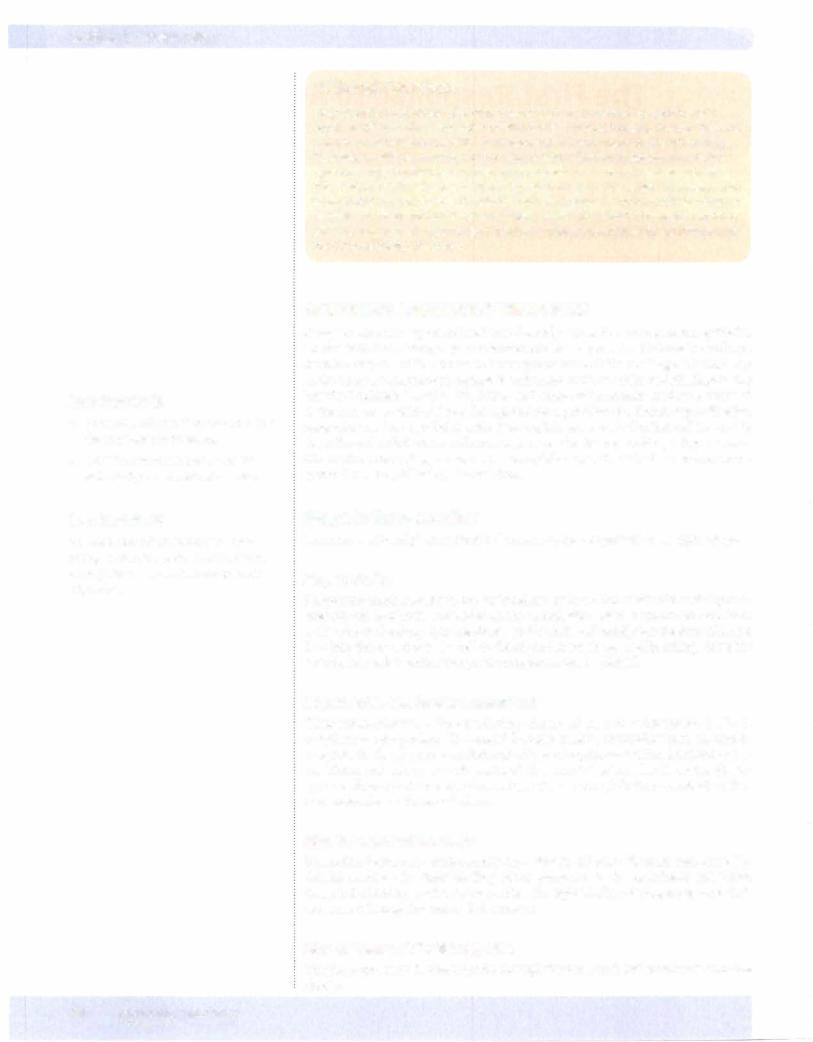
Section I • Immunology
Clinical Correlate
Drug allergies to penicillin and other agents such as streptomycin, aspirin, sulfa drugs, succinyl choline, and some opiates can be induced by small doses ofthe drug and are not consequences ofthe pharmacologic or physiologic effects ofthe drugs. Typically, an allergic response occurs 7 to 14 days following exposure, and the first symptoms may be mild. Subsequent drug exposures can result in severe and life threatening anaphylaxis (see Chapter 13). Most drugs are low molecularweight com pounds that are not capable of inducing immune responses by themselves-they act as haptens. Inside the body, however, these agents can become conjugated to body proteins (the carrier), and the hapten-carrier conjugate serves as the immunogen for the ensuing allergic response.
In a Nutshell
•The acute inflammatory response is a first response to invasion.
•Cytokines increase expression of selectin-type adhesion molecules.
In a Nutshell
Extravasation of phagocytes involves rolling, activation by chemoattractants, arrest/adhesion, and transendothelial migration.
ACUTE INFLAMMATORY RESPONSE
Antigens are normally introduced into the body across the mucosa or the epithelia. The acute inflammatoryresponse is often the first response to this invasion and rep resents a response of the innate immune system to block the challenge. The first step in the acute inflammatory response is activation of the vascular endothelium in the breached epithelial barrier. Cytokines and other inflammatory mediators released in the area as a result of tissue damage induce expression of selectin-type adhesion molecules on the endothelial cells. Neutrophils are usually the first cell to bind to the inflamed endothelium and extravasate into the tissues, peaking within 6 hours. Monocytes, macrophages, and even eosinophils may arrive 5 to 6 hours later in re sponse to neutrophil-released mediators.
Steps in Extravasation
The extravasation of phagocytes into the area requires 4 sequential, overlapping steps:
Step 1: Rolling
Phagocytes attach loosely to the endothelium by low-affinity, selectin-carbohydrate interactions. E-selectin molecules on the endothelium bind to mucin-like adhesion molecules on the phagocyte membrane and bind the cellbriefly,butthe force of blood flow into the area causes the cell to detach and reattach repeatedly, rolling along the endothelial surface until stronger binding forces can be elicited.
Step 2: Activation bychemoattractants
Chemokines released in the area during inflammation, such as interleukin 8 (IL-8), complement split product CSa, and N-formyl peptides produced by bacteria bind to receptors on the phagocyte surface and trigger a G-protein-mediated activating sig nal. This signal induces a conformational change in integrin molecules in the phago cyte membrane that increases their affinity for immunoglobulin-superfamily adhe sion molecules on the endothelium.
Step 3:Arrestand adhesion
Interaction between integrins and Ig-superfamily cellular adhesion molecules (Ig CAMs) mediates the tight binding of the phagocyte to the endothelial cell. These integrin-IgCAM interactions also mediate the tight binding of phagocytes and their movement through the extracellular matrix.
Step 4: Transendothelial migration
The phagocyte extends pseudopodia through the vessel wall and extravasates into the tissues.
40 M EDICAL


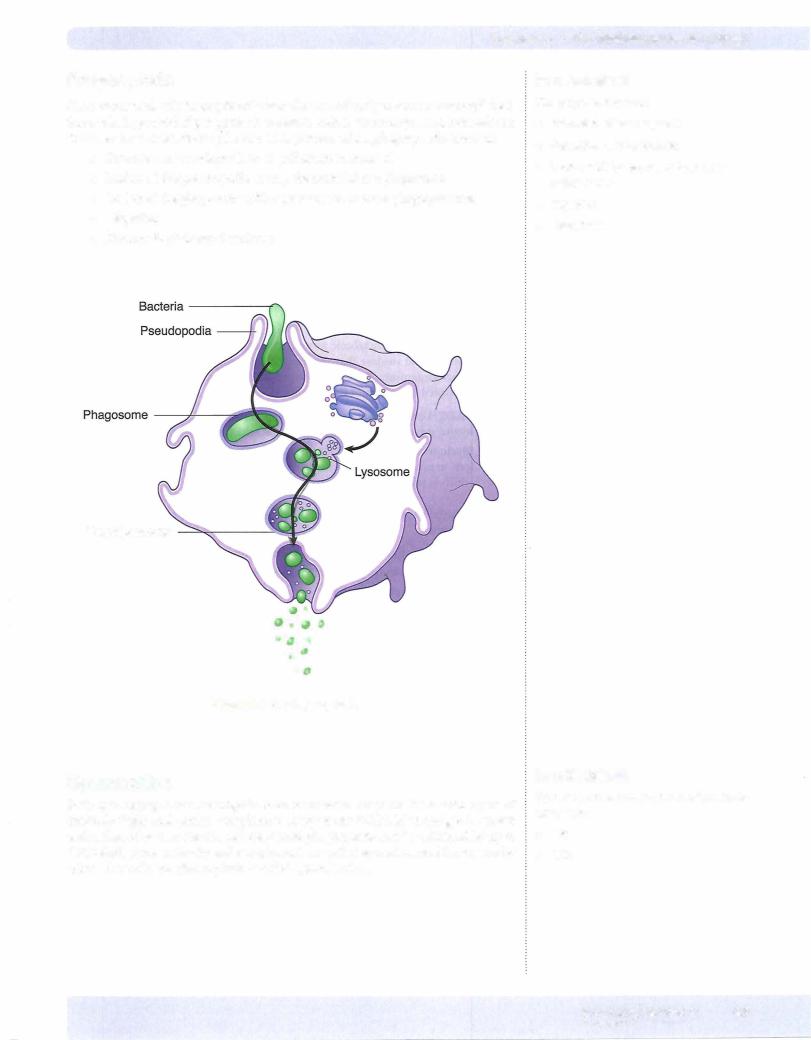
Chapter 5 • The First Response to Antigen
Phagocytosis
Once chemotaxis ofphagocytic cells into the area of antigen entry is accomplished, these cells ingest and digest particulate debris, such as microorganisms, host cellular debris, and activated clotting factors. This process, called phagocytosis, involves:
•Extension ofpseudopodia to engulfattached material
•Fusion ofthe pseudopodia to trap the material in a phagosome
•Fusion ofthe phagosome with a lysosome to create a phagolysosome
•Digestion
•Exocytosis of digested contents
Phagolysosome
oo 0'0°0 0 ooa 'b
0 000
oQ
Figure 1-5-3. Phagocytosis
In a Nutshell
Phagocytosis involves:
•Extension of pseudopodia
•Formation of phagosome
•Fusion with lysosome to form pha golysosome
•Digestion
•Exocytosis
Opsonization
Both macrophages and neutrophils have membrane receptors for certain types of antibody (IgG) and certain complement components (C3b). Ifan antigen is coated witheither ofthese materials, adherence andphagocytosis maybe enhancedbyup to 4,000-fold. Thus, antibody and complement are called opsonins, and the means by which they enhance phagocytosis is called opsonization.
In a Nutshell
Opsonization is enhancement of phagocy tosis with:
•lgG
•C3b
MEDICAL 43
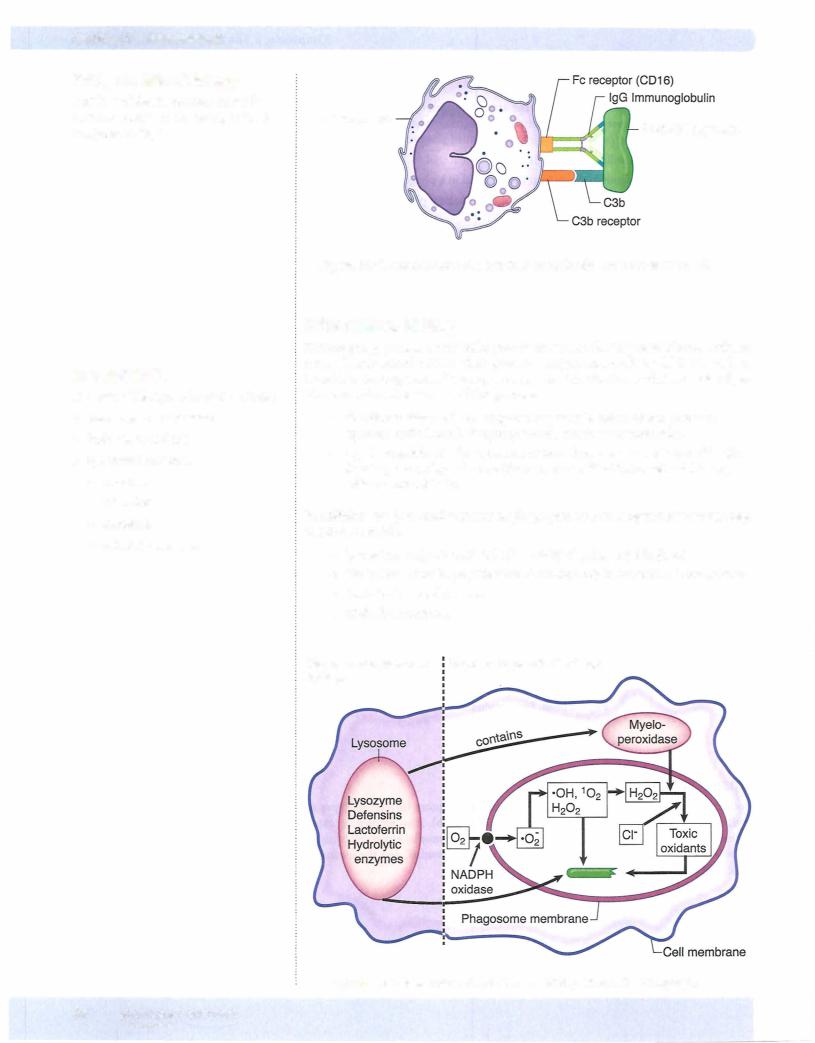
Section I • Immunology
Bridge to Microbiology
Protein A ofStaphylococcus aureus im
pedes opsonization by binding to the Fe |
Macrophage |
Bacterial organism |
component of lgG. |
|
|
In a Nutshell
Intracellular killing mechanisms include:
•Toxic oxygen metabolites
•Toxic halide radicals
•Lysosomal contents:
-Lysozyme
-Defensins
-Lactoferrin
-Hydrolytic enzymes
Figure 1-5-4. Opsonization of Bacteria with Antibody and Complement C3b
Intracellular Killing
During phagocytosis, a metabolic process known as the respiratory burst activates a membrane-bound oxidase that generates oxygen metabolites, which are toxic to ingested microorganisms.Twooxygen-dependent mechanisms of intracellular diges tion are activated as a result of this process.
•NADPH oxidase reduces oxygen to superoxide anion, which generates hydroxyl radical and hydrogen peroxide, which are microbicidal.
•Myeloperoxidase in the lysosomes acts on hydrogen peroxide and chloride ions to produce hypochlorite (the active ingredient in household bleach), which is microbicidal.
In addition, the lysosomal contents of phagocytes contain oxygen-independent deg radative materials:
•Lysozyme--digests bacterial cell walls by cleaving peptidoglycan
•DefensinS""ircular--{;peptides that form channels in bacterial cell membranes
•Lactoferrin---helatesc iron
•Hydrolytic enzymes
Oxygen-Independent Oxygen-Dependent Killing
Killing
Figure 1-5-5. Metabolic Stimulation and Killing Within the Phagocyte
44 MEDICAL
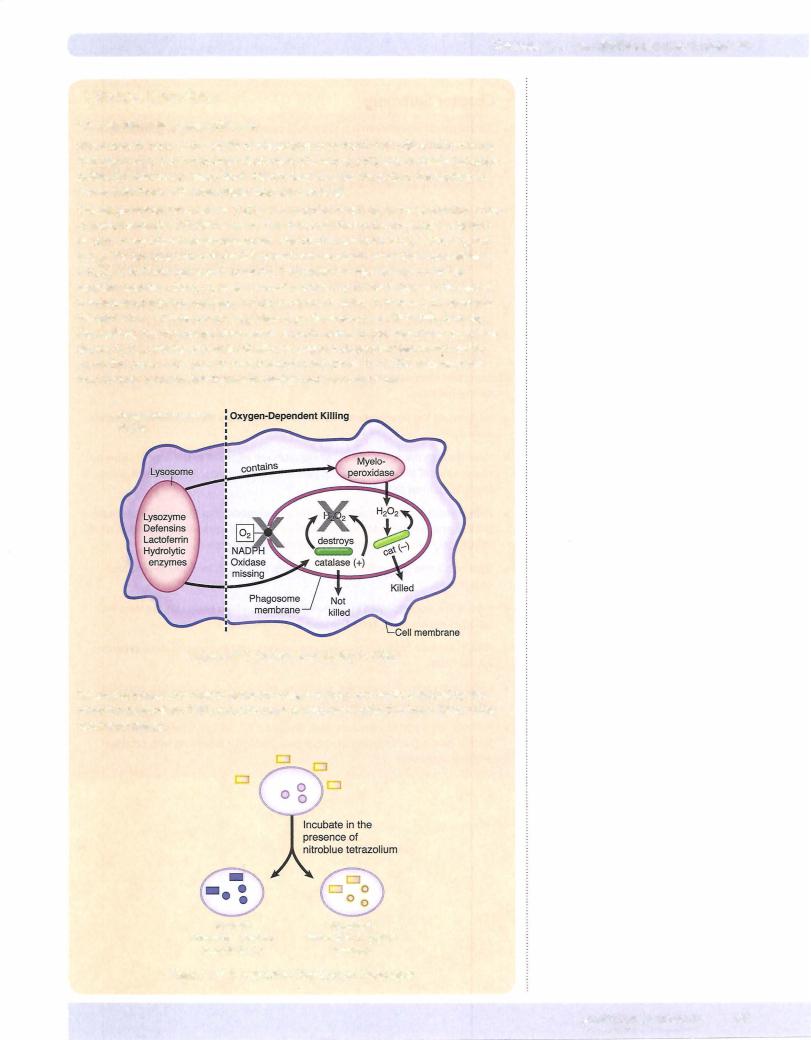
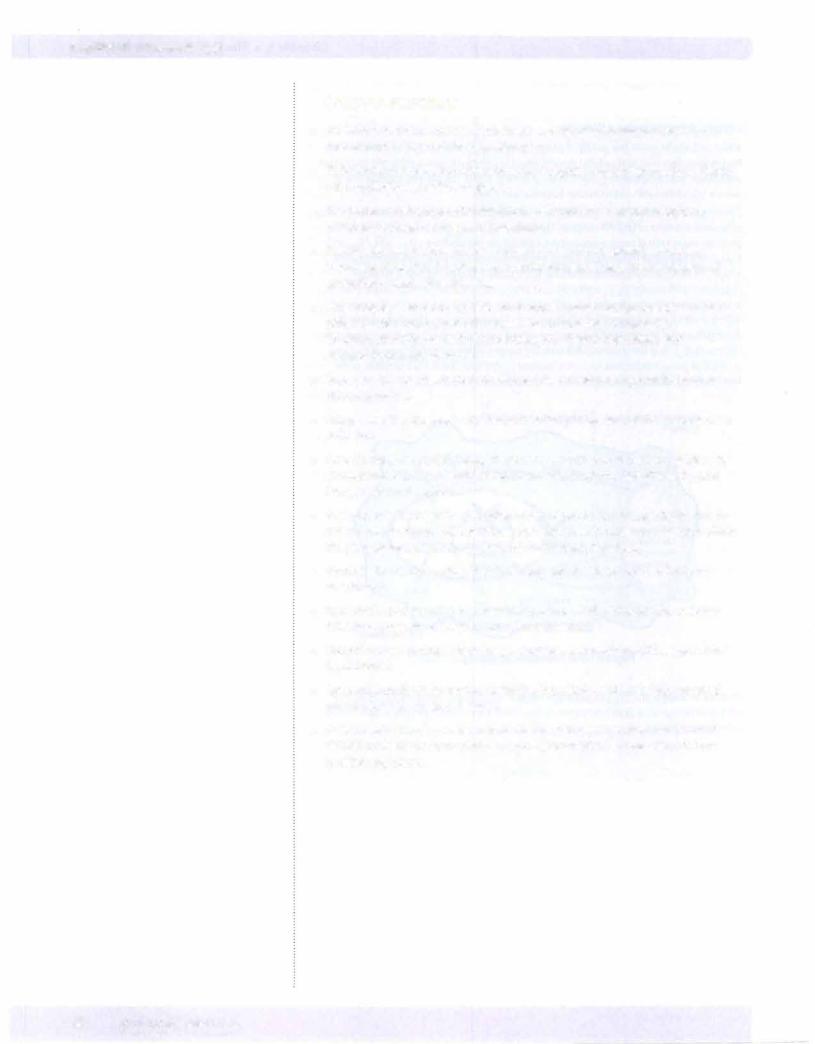
Section I • Immunology
Chapter Summary
• An antigen or immunogen is a substance capable of activating or generating a response from any committed lymphocyte.
• To be immunogenic, a substance must be recognized as foreign and have chemi cal complexity and sufficient size.
• The portion of an antigen that fits into the idiotype of an antigen receptor is called the epitope or antigenic determinant.
• Haptens are single antigenic determinants that can only generate immune responses ifthey are linked to larger carrier proteins. This is the mechanism of elicitation of many drug allergies.
• After antigen is introduced across an anatomic barrier, phagocytes (first neutro phils and then monocytes) will extravasate into the area of injury by
1) rolling, 2) activation with chemoattractants, 3) arrest/adhesion, and
4) transendothelial migration.
•Important chemoattractants include IL-8, CSa, leukotriene B4, and N-formyl me thionyl peptides.
•lntegrins on the phagocyte membrane bind to lg-CAMs on endothelia to mediate adhesion.
•Once through the endothelium, phagocytes are attracted to the area of injury by chemokines ofthe IL-8 family, complement split products, leukotriene B4, and formyl methionyl peptides.
•Phagocytosis involves: the formation of pseudopodia that trap particulate mate rial in a phagosome; addition of lysosomes to cause intracellular digestion within the phagolysosome; and exocytosis ofthe digested materials.
•Opsonization is the coating of particles with lgG or C3b (or both) to enhance engulfment.
•Ingestion is accompanied by a respiratory burst, which generates the toxic me tabolites necessary to destroy intracellular materials.
•NADPH oxidase produces toxic oxygen radicals, and myeloperoxidase generates hypochlorite.
•Lysosomal contents (lysozyme, defensins, lactoferrin, and hydrolytic enzymes) are also toxic to ingested material.
•Patients with chronic granulomatous disease (CGD; an inherited deficiency of NADPH oxidase) are susceptible to chronic, recurrent infections with catalase positive organisms.
46 M EDICAL
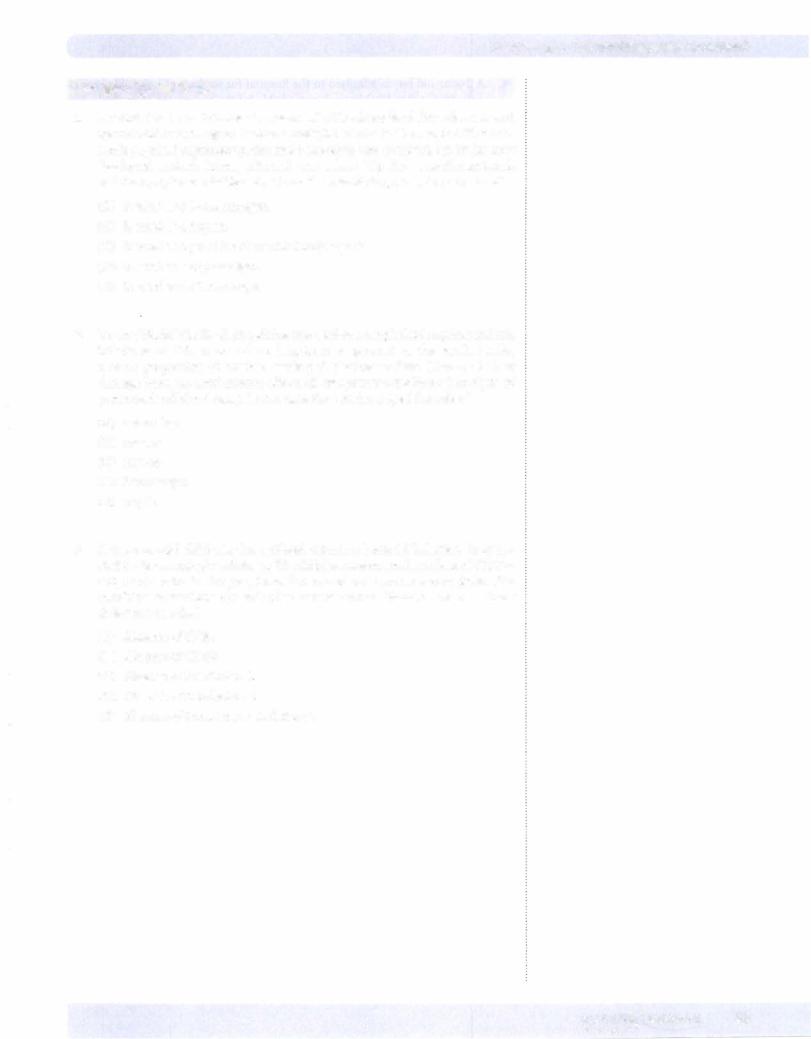
Chapter 5 • The First Response to Antigen
Review Questions
1. A rabbit hunter in Arkansas is diagnosed with ulceroglandular tularemia and treated with streptomycin. Within a week, he returns to the hospital. The tula remic papule, lymphadenopathy, andbacteremia have resolved,but he has now developed a raised, itching skin rash and a fever. The drug was discontinued, and the symptoms subsided. What was the role ofstreptomycin in this case?
(A)It acted as a B-cell mitogen
(B)It acted as a hapten
(C)It acted as a provider ofcostimulatory signals
(D)It acted as a superantigen
(E)It acted as an immunogen
2.DuringWorldWar II, when quinine was used as a prophylactic against malaria infections in U.S. personnel on long-term assignment to the South Pacific, a small proportion of soldiers developed blackwater fever (chronic kidney damage from the autoimmune effects of complement-mediated hemolysis of quininized red blood cells). In this case, the quinine played the role of
(A)autoantigen
(B)carrier
(C)hapten
(D)immunogen
(E)reagin
3.A two-year-old child who has suffered recurrent bacterial infections is evalu atedfor immunologic deficiency. The childhas age-normal numbers ofCD19+ and CD3+ cells in the peripheral blood and an extreme neutrophilia. The nitroblue tetrazolium dye reduction test is normal. What is the most likely defect in this child?
(A)Absence ofCCR4
(B)Absence ofCD18
(C)Absence ofinterleukin-1
(D)Absence ofinterleukin-4
(E)Absence oftumor necrosis factor-a
MEDICAL 47
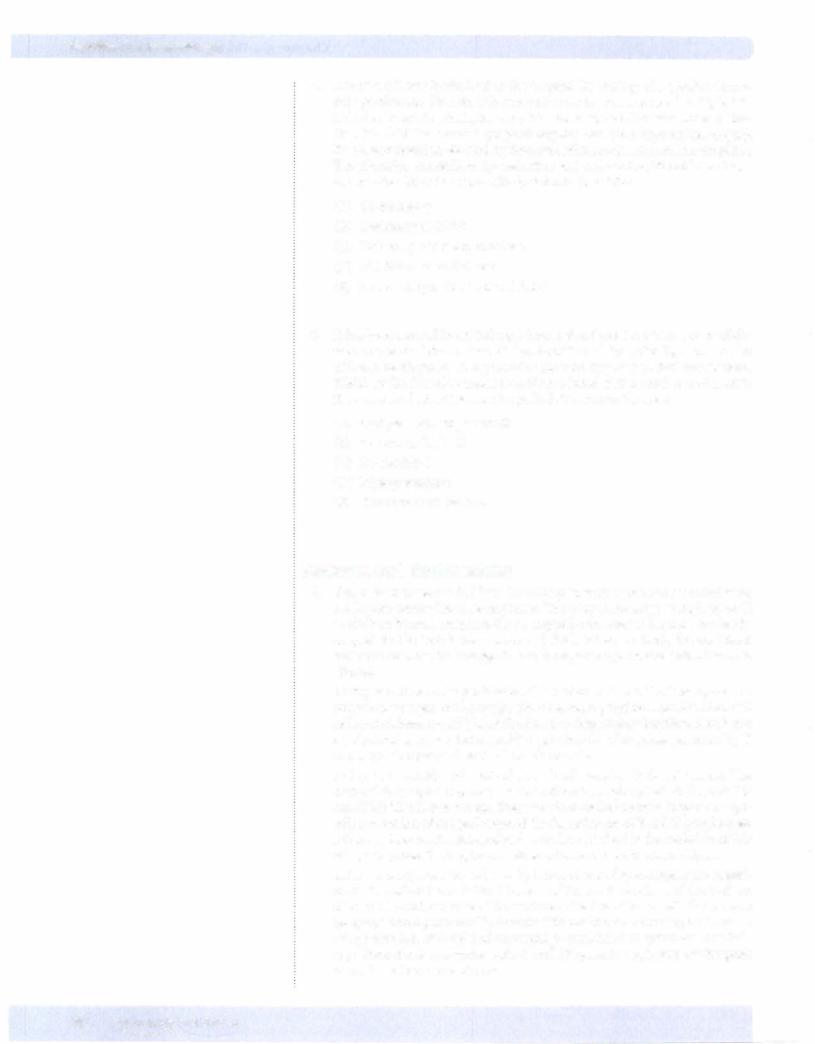
Section I • Immunology
4.A 2-year-old boy is admitted to the hospital for workup of a possible imnm nologic disorder. His history is remarkable for the occurrence of multiple skin infections involving Staphylococcus, Pseudomonas, and Candida. On examina tion the child has cervical lymphadenopathy and mild hepatosplenomegaly. Blood tests reveal an elevated erythrocyte sedimentation rate and neutrophilia. The nitroblue tetrazolium dye reduction test and neutrophil oxidative index are negative. What is the most likelydefect in this child?
(A)C3 deficiency
(B)Deficiency of CD18
(C) Deficiency ofmyeloperoxidase
(D)NADPH oxidase deficiency
(E)Phagocyte granule structural defect
5.It has been learned in animal experiments that there are advantages to elicit ing nonspecific inflammation at the site of inoculation of antigen toward the ultimate development of a protective immune response to that immunogen. Which of the following substances, if introduced with a vaccine, would serve the purpose ofattracting a neutrophilic infiltrate into the area?
(A)Complement component 3b
(B)Immunoglobulin G
(C) Interleukin-8
(D)Myeloperoxidase
(E)Tumor necrosis factor-a
Answers and Explanations
1.The correct answer is B. Many drug allergies, such as the one described here, are hapten-carrier immune responses. The drug is not large enough by itself to elicit an immune response (it is a hapten), but when it becomes covalently coupled to the body's own proteins (which act as carriers), the combined molecule becomes immunogenic, and a response against one's own tissues is elicited.
Acting as a B-cell mitogen (choice A) is not correct. B-cell mitogens, such as pokeweed mitogen and lipopolysaccharide, cause polyclonal proliferation of B cells and elaboration of IgM antibodies. The drug allergy described here is not a polyclonal response, but a specific anti-altered-self response generated by T and B lymphocytes·and production of antibodies.
Acting as a provider of costimulatory signals (choice C) is not correct. The costimulatory signals required to activate B and T lymphocytes include CD28/B7 andCD40/CD40Linteractions.Theseare additional interactions (beyondthe spe cific recognition of antigen) required for the activation of B and T lymphocytes. Although these costimulatory signals would be involved in the evolution of this allergic response, the streptomycin does not serve as a costimulatorysignal.
Acting as a superantigen (choice D) is not correct. Superantigens are materi als that crosslink the variable B domain of the T-cell receptor and the a-chain of class II MHC molecules. They induce activation of all T cells that express receptors with a particular V domain. The resulting T-cell mitogenesis causes overproduction of T-cell and macrophage cytokines and system-wide pathol ogy. Toxic shock syndrome toxin-I and Streptococcus pyogenes erythrogenic exotoxins act as superantigens.
48 MEDICAL
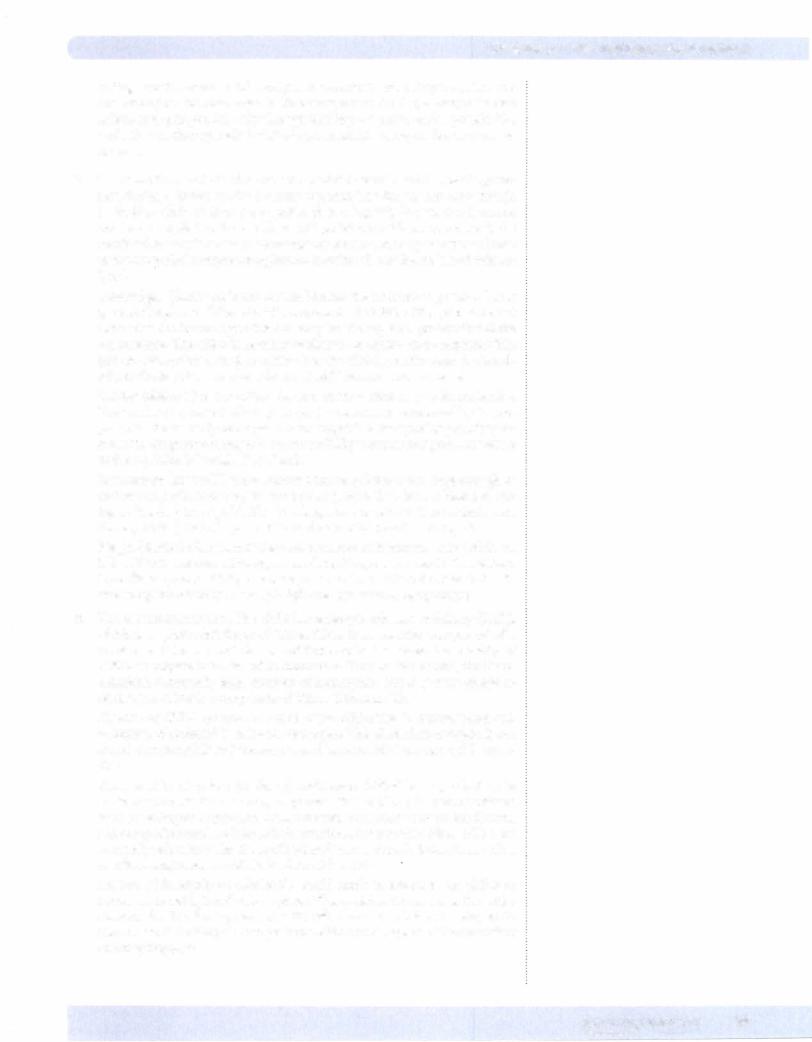
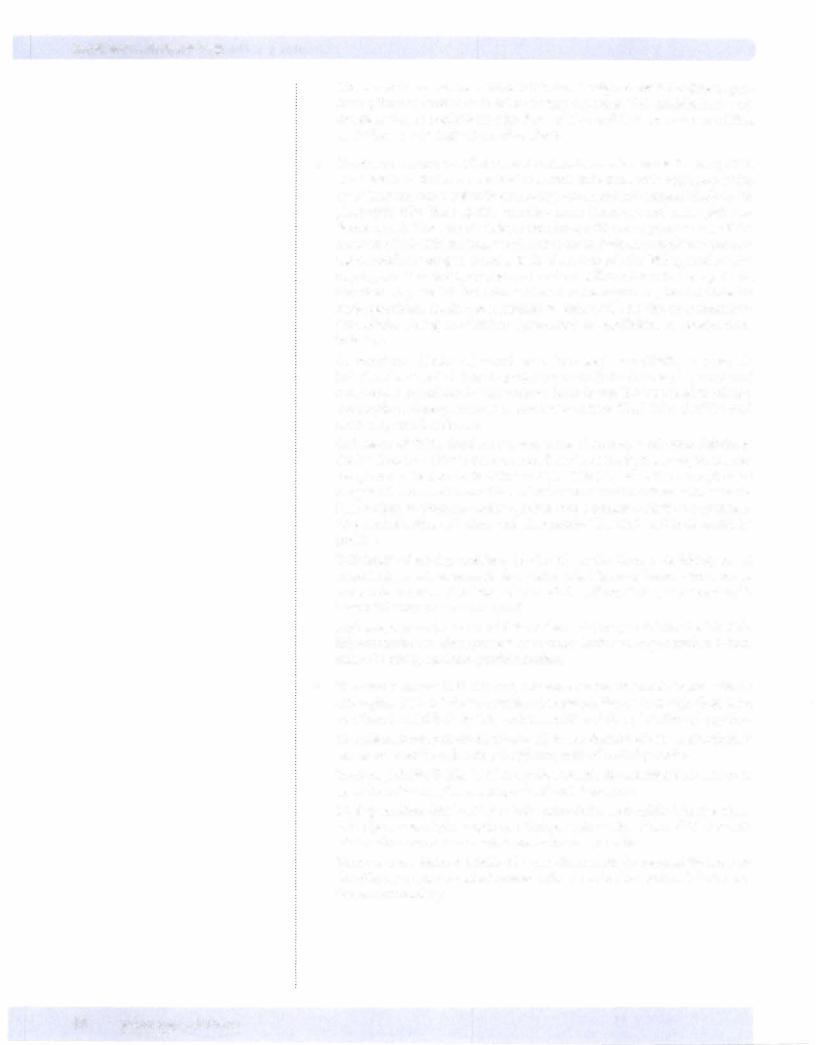
Section I • Immunology
Absence of tumor necrosis factor-ex (choice E) might cause difficulties in pro ducing the acute and chronic inflammatory responses. This cytokine has many functions that are redundant with those of IL-1 and IL-6, so such a condition might have no clinically observable effects.
4.Thecorrect answeris D.This child has chronic granulomatous disease (CGD). The history indicates he has had recurrent infections with catalase-positive organisms and has a defect in generating oxygen radicals intracellularly in his phagocytic cells (the negative nitroblue tetrazolium test and neutrophil oxi dative index). This genetic defect arises from a failure to produce one of the subunits of NADPH oxidase, which makes the individual incapable of produc ing intracellular oxygen radicals. Redundant intracellular killingmechanisms (myeloperoxidase and lysosomal contents) are still functional in these patients, but when they are infected with catalase-positive organisms, the substrate for myeloperoxidase (hydrogen peroxide) is destroyed, and the only remaining intracellular killing mechanism (lysosomes) is insufficient to protect from infection.
C3 deficiency (choice A) would cause increased susceptibility to pyogenic
infections because C3b is an important opsonin that enhances phagocytosis of extracellular organisms.Alle21:racellular.. bacteriawould be included in this list, not simply catalase-positive ones, as mentionedhere. The NBT and NOI would not be negative in this case.
Deficiency of CD18 (choice B) is the cause of leukocyte adhesion deficiency (LAD). Because CD18 is the common P chain of the P2 integrins, its absence compromises leukocyte function antigen (LFA)-1, as well as complement receptors 3 and 4. Patients with LAD suffer recurrent infections with extracel lular pathogens (not just catalase-positive ones) because of defective opsoniza tion, mobilization, adhesion, and chemotaxis. The NBT and NOI would be positive.
Deficiency of myeloperoxidase (choice C) results from a deficiency of an important granule enzyme in phagocytic cells. However, because there are so many redundant mechanisms of intracellular killing,these patients generally have mild symptoms or none at all.
A phagocyte granule structural defect (choice E) is responsible for the Chediak Higashi syndrome. These patients have chemotactic and degranulation defects, lack NK activity, and have partial albinism.
5.The correct answer is C. The only substance on the list that is chemotactic for neutrophils is IL-8. Other neutrophil chemotactic factors that might have been mentioned would include C5a, leukotriene B4, and formyl methionyl peptides.
Complement component 3b (choice A) is not chemotactic for neutrophils. It acts as an opsonin, enhancing the phagocytosis of coated particles.
Immunoglobulin G (choice B) is not chemotactic for neutrophils. It acts as an opsonin, enhancing the phagocytosis of coated particles.
Myeloperoxidase (choice D) is not chemotactic for neutrophils. It is an enzyme in the lysosomes of phagocytic cells that generates toxic halide radicals intracel lularly when exposed to its substrate, hydrogen peroxide.
Tumor necrosis factor-ex (choice E) is not chemotactic for neutrophils. It is pro ducedbymacrophages and is involved with the production ofchronic inflamma tion and cytotoxicity.
50 MEDICAL

The Processing and |
6 |
Presentation of Antigen |
What the USMLE Requires You To Know
• How the grooves ofclass I and II MHC are loaded with peptides
•The 3 signals required forT-cell activation (fCR binding, costimulatory molecules, and cytokines)
•How superantigens act
•The subclasses ofT helper (fH) cells, their functions, and regulation
MHC molecules are designed to bind small peptides and present them to T cells. The class I molecule is synthesized in the endoplasmic reticulum of the cell and proteins are loaded there by an endogenous pathway. Proteins synthesized in the cell cytosol areroutinelydegraded in proteasomes, and the peptidesfrom these proteins are trans ported through a peptide transporter, known as the TAP complex, into the endoplas mic reticulum, where they have the opportunity to bind to freshly synthesized MHC class I proteins. These are then transported to the cell membrane where they may be presented to CDS+ T lymphocytes (see Chapter 8).
In a Nutshell
•MHC I molecule is loaded with pep tides via the endogenous pathway.
•CD8+ T cells recognize MHC I/peptide.
MEDICAL 51
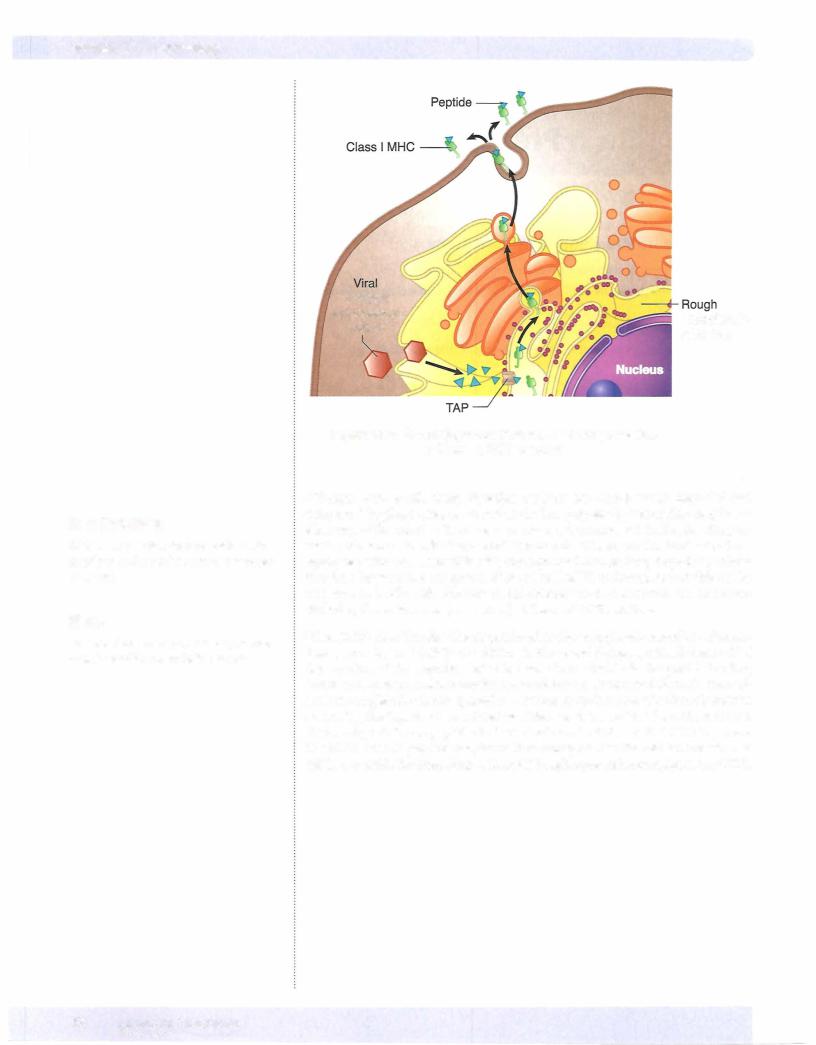
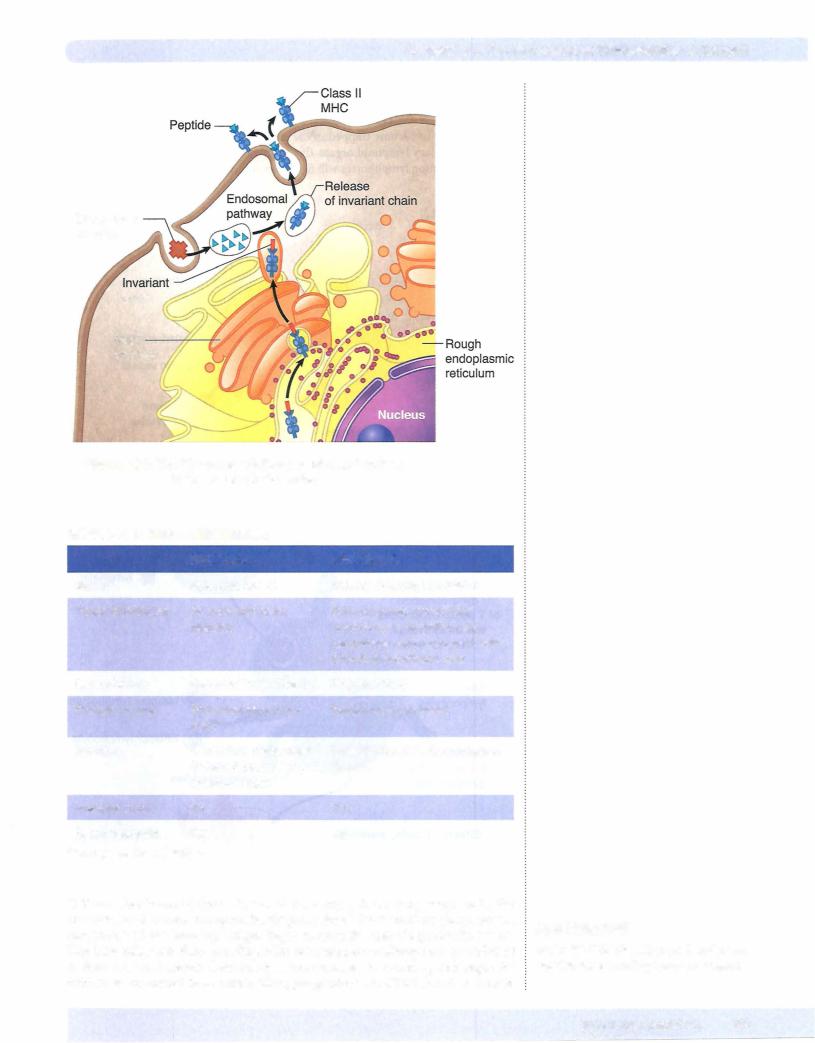
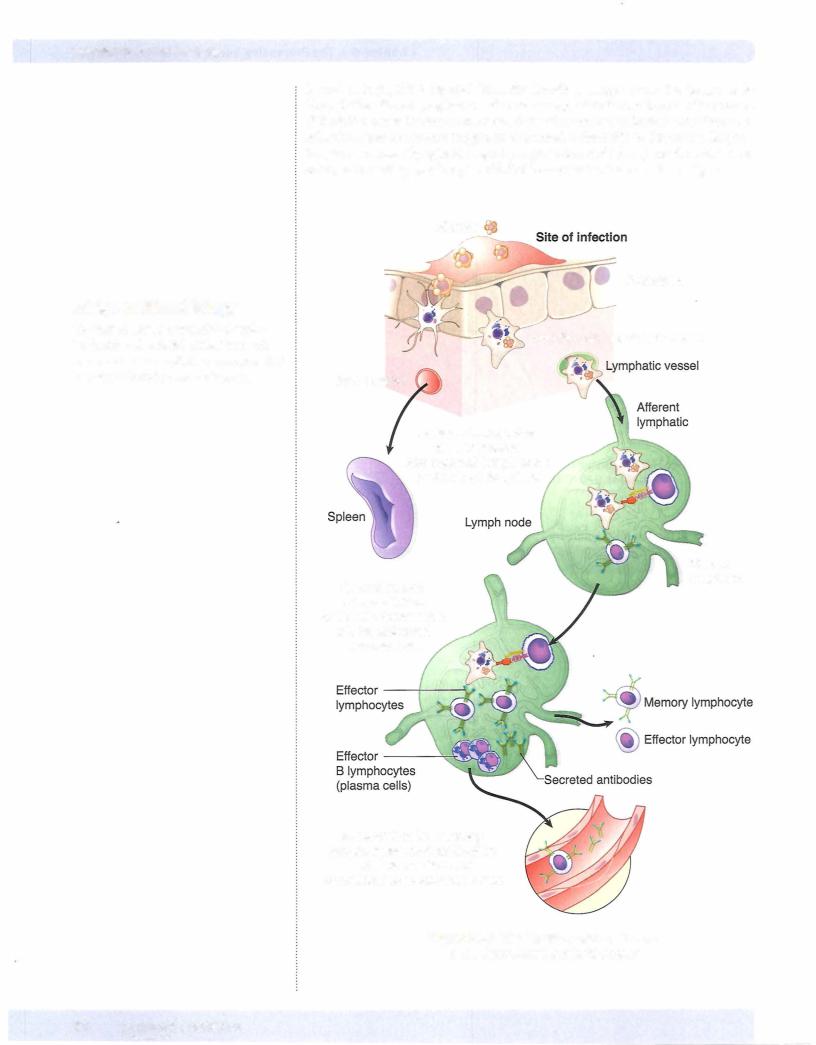
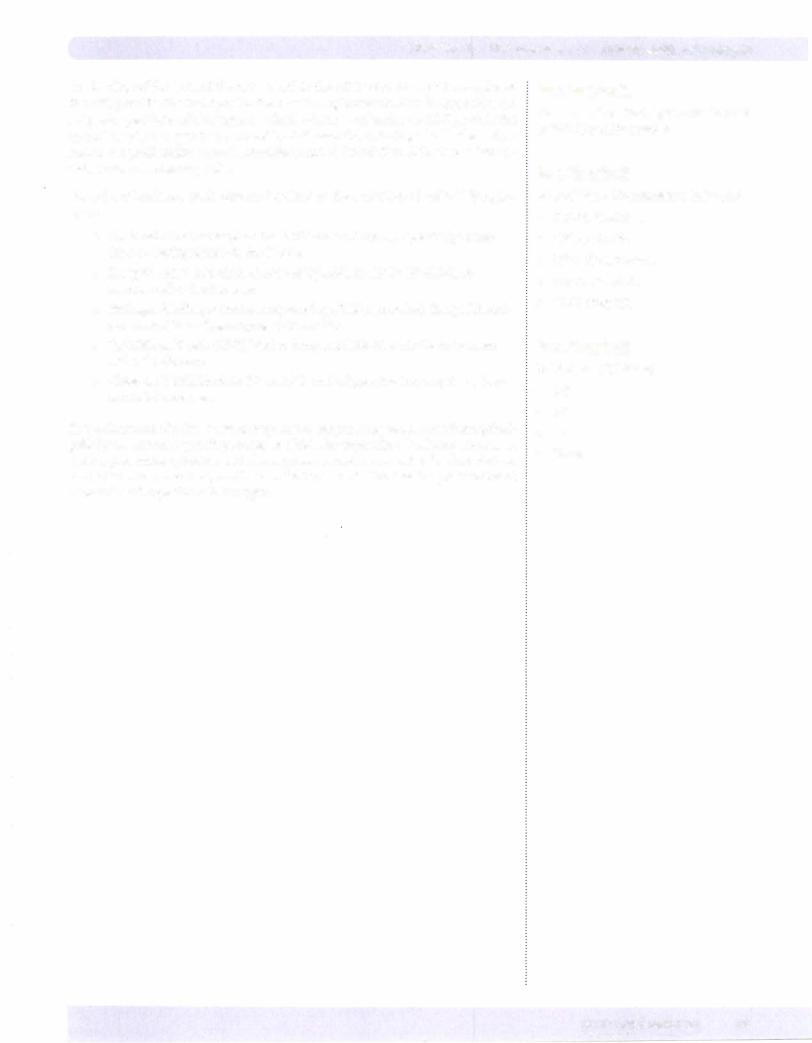
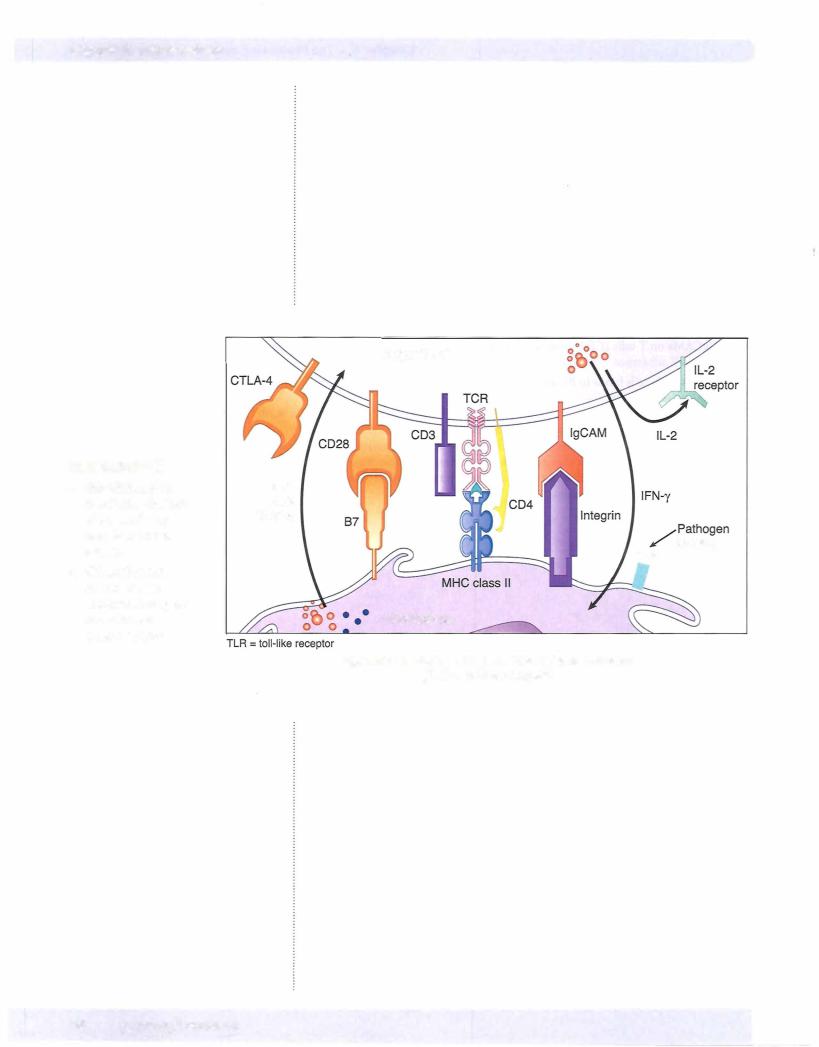
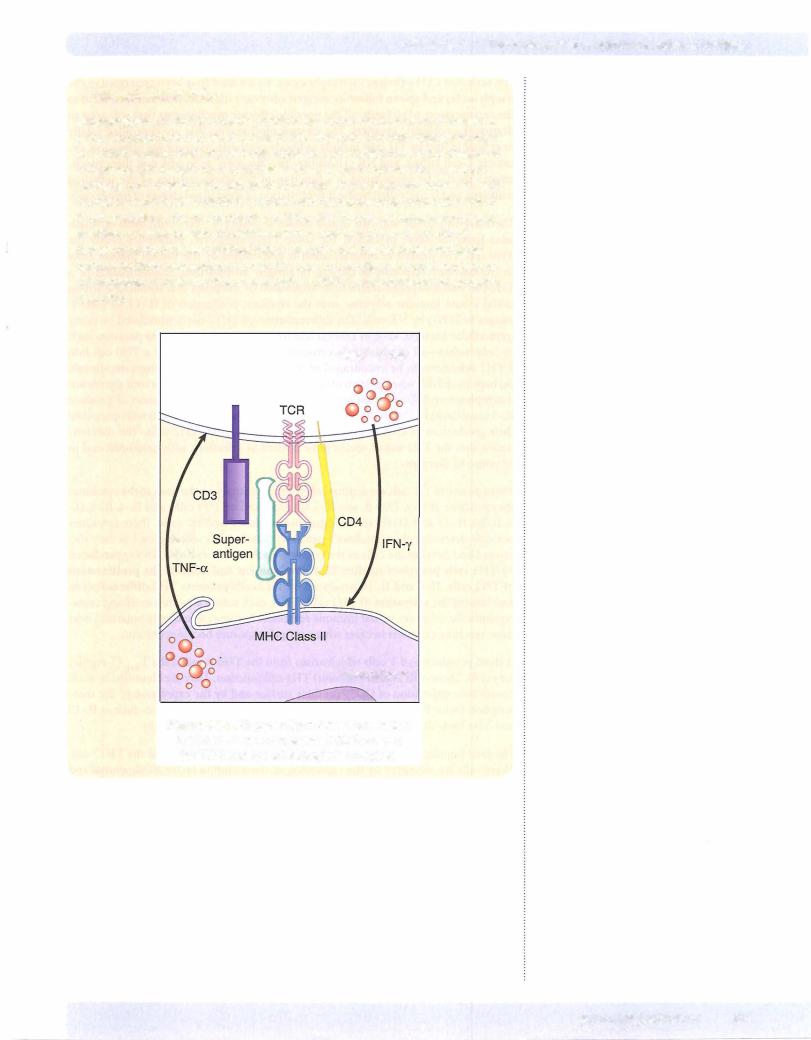
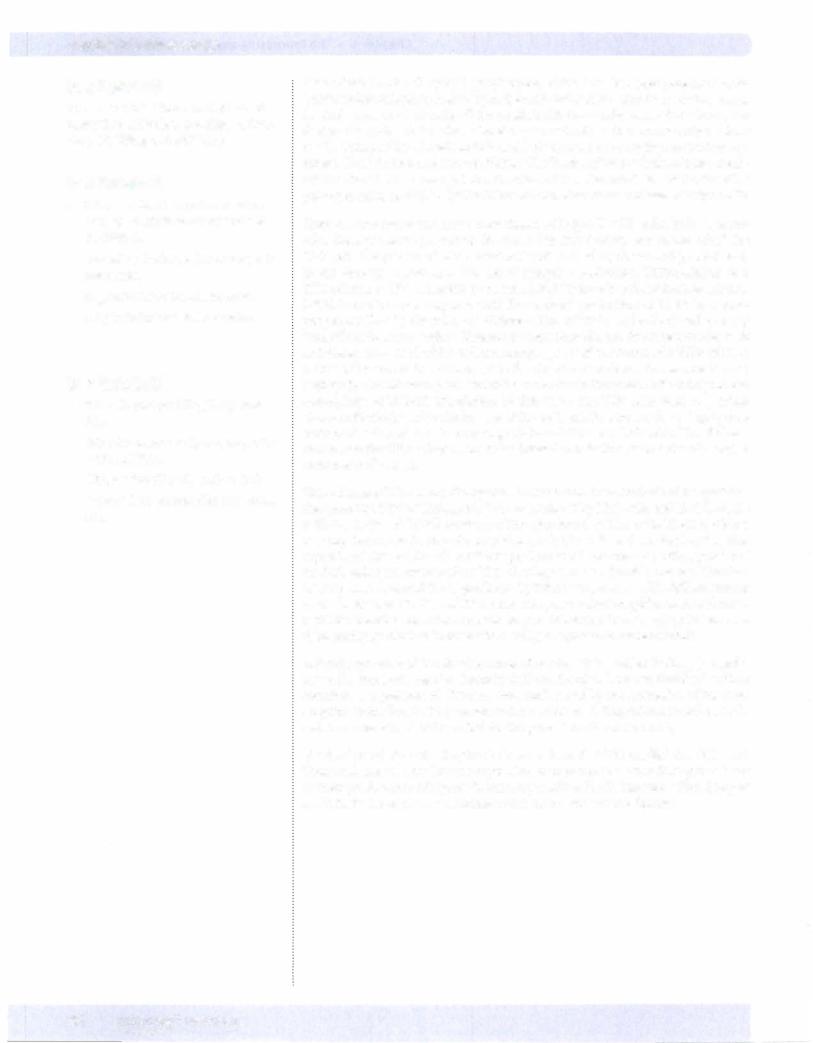
Section I • Immunology
In a Nutshell
TH cells control effector mechanisms of immunity (antibody, macrophage activa tion, CTL killing, and NK killing).
In a Nutshell
•THl cells arise from precursor when a strong innate immune response is stimulated.
•TH2 cells arise in the absence of such responses.
•TReg cells inhibit THl cell function.
•TH17 cells increase inflammation.
In a Nutshell
•TH1 cells produce IFN-y, TNF- . and IL-2.
•TH2 cells produce IL-4, IL-5, IL-6, IL-10, IL-13 and TGF .
•IFN-y produced by TH1 inhibits TH2.
•IL-4 and IL-10 produced byTH2 inhibit TH1.
The activated CD4+ (helper) T lymphocytes, which have thus been generated in the lymph nodes and spleen following antigen administration, are now readyto serve as the orchestrators ofvirtually all the possible effector mechanisms that will arise to destroy the antigenic invaders. The effector mechanisms that are controlled totally or at least in part by TH cells include antibody synthesis, macrophage activation, cy totoxic T-cell killing, a d NK cell killing. The "decision" as to which ofthese mech anisms should be encouraged is a function of the characteristics of the invading pathogen and is controlled bythe differentiation ofspecialized classes ofhelper cells.
There are two major and two minor classes of helper T (TH) cells, both of which arise from the same precursor, the naive TH lymphocyte, sometimes called the THO cell. The pattern of differentiation is determined by the stimuli present early in the immune response, at the site of antigen introduction. Differentiation of a THO cell into a THI cell seems to be stimulated by microbes that stimulate a strong initial innate immune response with the resultant production of IL-I2 by macro phages or IFN-yby NK cells. The differentiation ofTHI cells is stimulated by many intracellular bacteria, such as Listeria and mycobacteria, and by some parasites such as Leishmania--all of which infect macrophages. Differentiation of a THO cell into a TH2 cell seems to be encouraged in the absence of such innate immune stimuli, perhaps by default when persistent antigen remains in the system without significant macrophage or NK-cell stimulation. In this way, naive THO cells seem to produce IL-4 constitutively, and in the absence ofILI2 stimulation, these cells willupregulate their production of IL-4 to encourage differentiation into TH2 cells. The differen tiation into the TH2 subset seems to be favored in infections with helminths and in response to allergens.
These classes ofTH cells aredistinguishedalmost entirelyonthebasis ofthe cytokines they produce. IFN-y, TNF- , and IL-2 are produced by THI cells, and IL-4, IL-5, IL- 6, IL-10, IL-13 and TGF are the cytokines produced by TH2 cells. These cytokines not only determine the stimulatory pathways that the cells willemploy, but they also expand and develop the cells ofthe respective subset. For example, IFN-yproduced by THI cells promotes further THI development and inhibits the proliferation ofTH2 cells. IL-4 and IL-I0 produced by TH2 cells promote TH2 differentiation and inhibit the activation ofTHI cells. Thus, each subset amplifies itself and cross regulates the other set so thatimmune responses become increasinglypolarized over time, reaching extremes in cases where antigen exposure becomes chronic.
A third population ofT cells which arises from the THO is called the T |
|
(T regula |
|
tory cell). These cells regulate (inhibit) THI cell function. They are |
identi |
ed by their |
|
|
Rei |
|
|
constitutive expression of CD25 on their surface and by the expression of the tran scription factor FoxP3. They secrete inflammation inhibiting cytokines such as IL-10 and have been shown to be critical for the prevention ofautoimmunity.
The final population of TH cells which arises from the THO is called the THI7 cell. These cells are identified by the expression of transcription factor RORgammat and by their production ofthe proinflammatory cytokine IL- I7. They are believed to play a role in the tissue damage associated with some autoimmune diseases.
58 MEDICAL
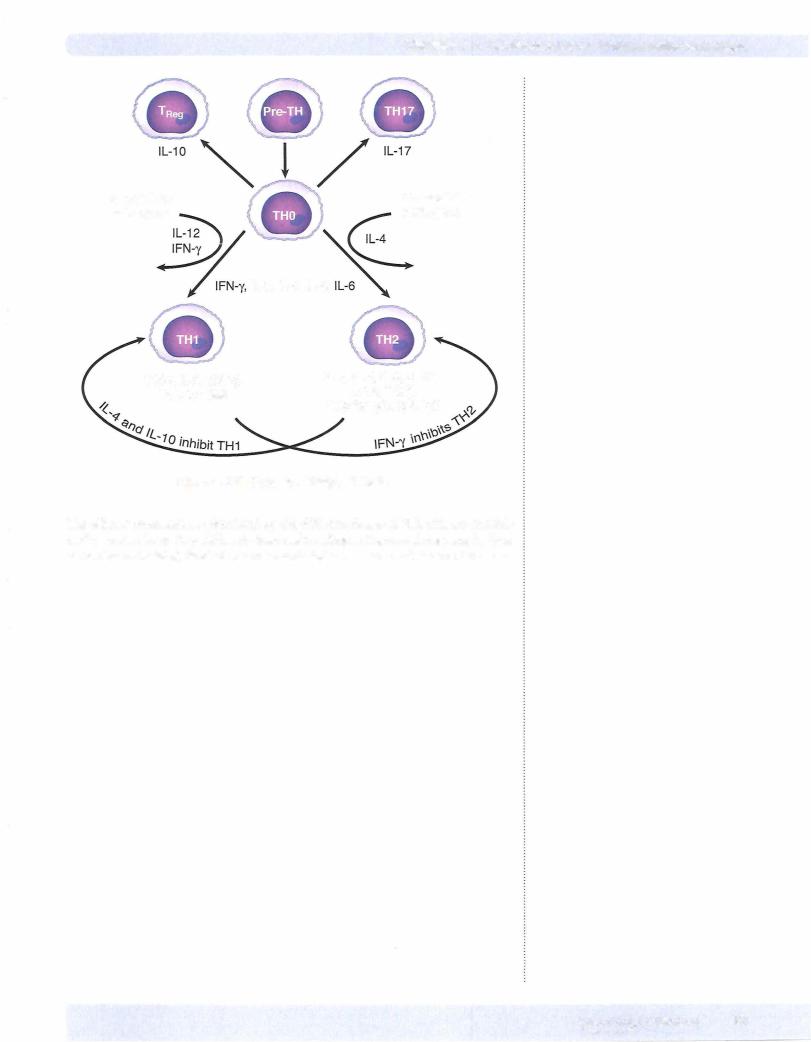
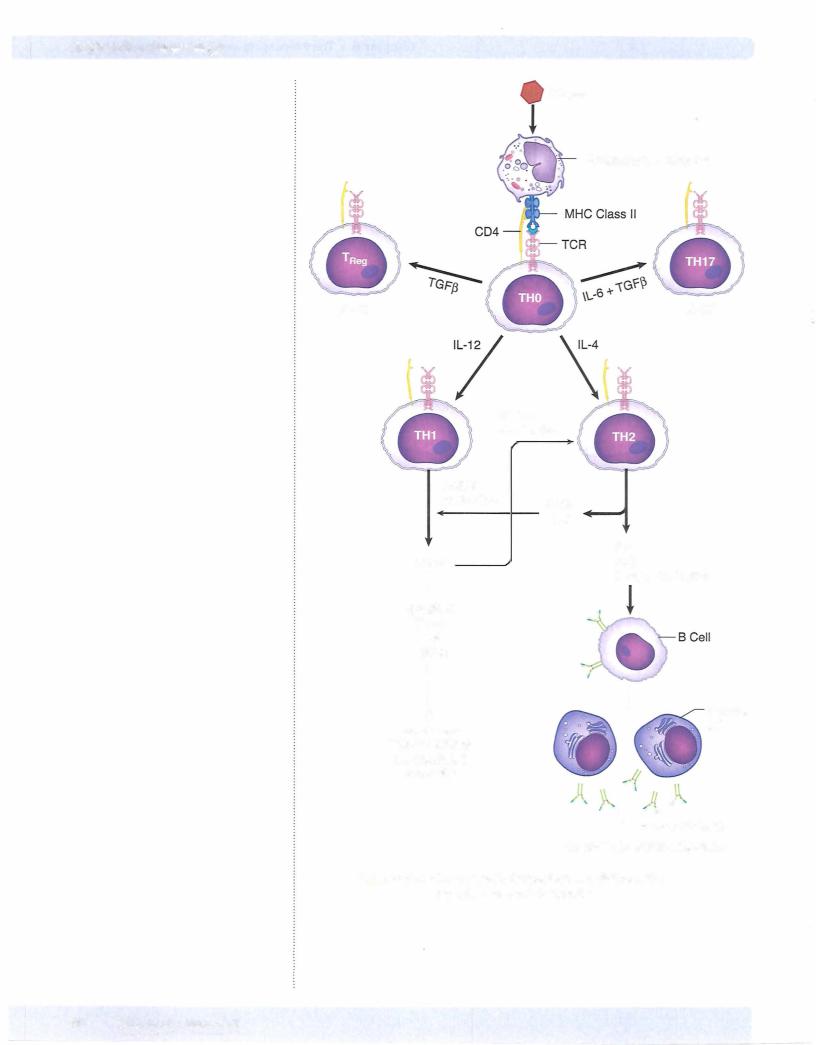
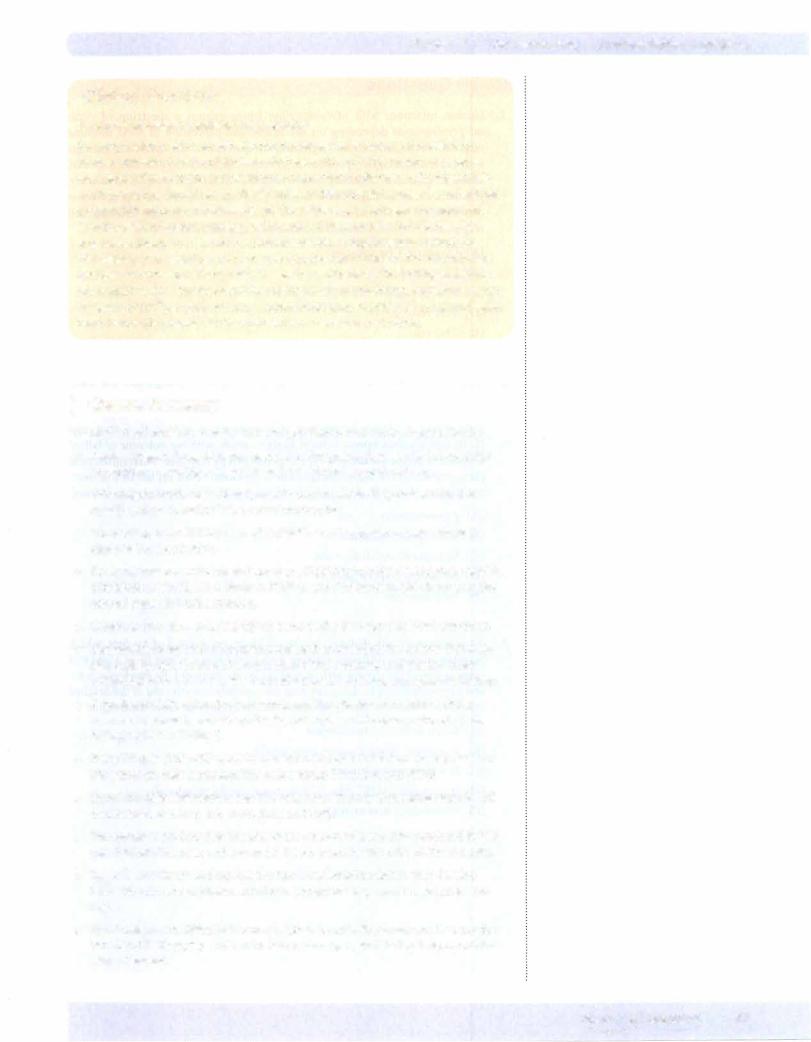
Chapter 6 • The Processing and Presentation of Antigen
Clinical Correlate
Tuberculoid Versus Lepromatous Leprosy
The progression of disease with Mycobacterium /eprae in humans is a well-docu mented example ofthe crucial balance between TH1 and TH2 subsets. Leprosy is not a single clinical entity, but presents as a spectrum of diseases, with tuberculoid and lepromatous forms being at the far poles. In tuberculoid leprosy, the patient has a strongTH1 response, which eradicates the intracellular pathogens by granuloma formation. There is some damage to skin and peripheral nerves, but the disease progresses slowly, if at all, and the patient survives. In lepromatous leprosy, the TH2 response is turned on, and because ofreciprocal inhibition, the cell-mediated response is depressed. These patients develop antibodies to the pathogen that are not protective, and the mycobacteria multiply inside macrophages, sometimes reach ing levels of 1010 per gram oftissue. Hypergammaglobulinemia may occur, and these cases frequently progress to disseminated and disfiguring infections.
Chapter Summary
•MHC Class I molecules are loaded with peptides via the endogenous pathway.
•Partially digested peptides are loaded into the groove of class II MHC molecules on antigen-presenting cells by the endosomal (exogenous) pathway.
•APCs migrate to the secondary lymphoid organs, where they present this pro cessed antigen to recirculating naive lymphocytes.
•The binding of the TCR to the peptide/MHC class II complex provides the first signal in T-cell activation.
•Costimulatory molecule interactions (e.g., CD28 binds to B7, CD4 binds to MHC II, CDS bindsto MHC I, LFA-1 bindsto ICAM-1, and CD2 bindsto LFA-3) serve as the second signal in T-cell activation.
• Cytokines (IL-2, IL-1, IL-6, and TNF-a) serve as the final signal in T-cell activation.
•Superantigens are viral or bacterial proteins that cross-link the variable domain ofa T-cell receptorto an a chain of a class II MHC molecule and thereby cause polyclonal activation ofT cells, overproduction of cytokines, and systemic toxicity.
•Activated TH cells act as the orchestrators of the effector mechanisms of the immune response (antibody synthesis, macrophage activation, cytotoxic T cell killing, and NK cell killing).
•Naive TH cells (THO) differentiate into TH1 cells when IL-12 from macrophages or
IFN-yfrom NK cells is present. TH1 cells secrete IFN-y, IL-2, and TNF- .
•Naive THO cells differentiate into TH2 cells when there is extracellular attack. TH2 cells secrete IL-4, IL-5, IL-6, IL-10, IL-13 and TGF .
•The cytokines produced by TH subsets are cross-regulatory: IFN-y produced by TH1
cells inhibits TH2 cells, and IL-4 and IL-10 produced byTH2 cells inhibitTH1 cells.
•TReg cells are co25+ and express the FoxP3 transcription factor.They develop from THO cells and are believed to be important in the prevention of autoimmu· nity.
•TH17 cells are identified by the transcription factor RORgammat and their produc tion of IL-17. They play a role in the tissue damage associated with some autoim mune diseases.
MEDICAL 61
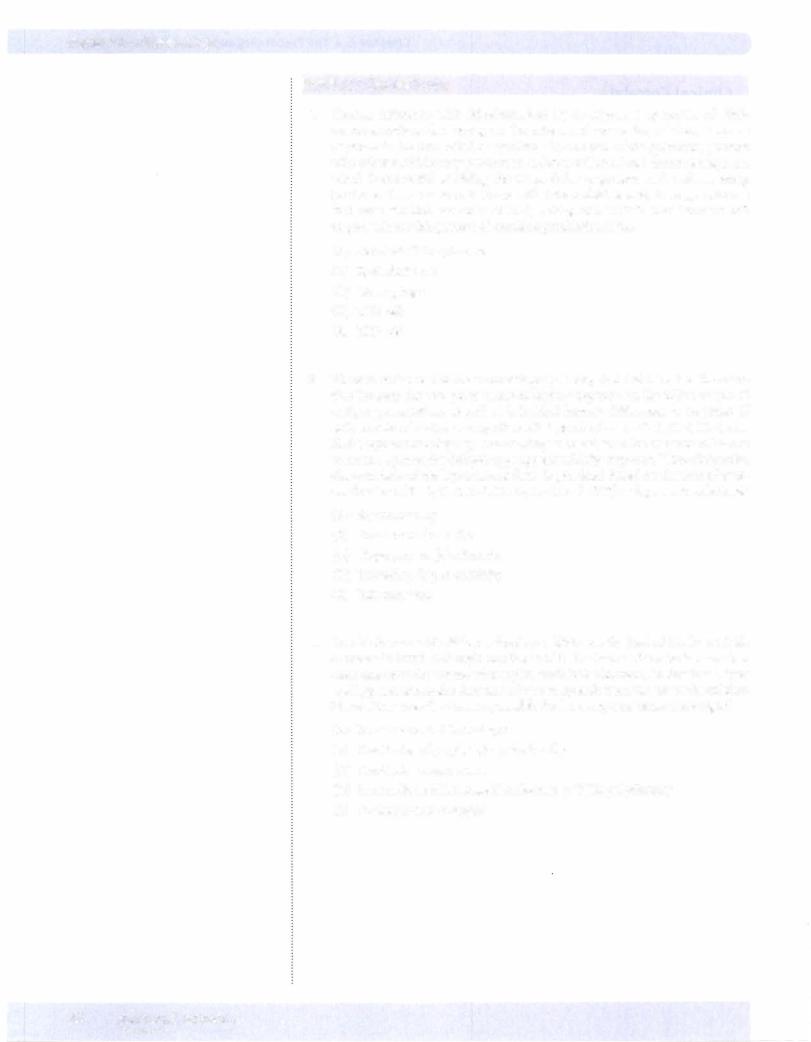
Section I • Immunology
Review Questions
1.Human infections with Mycobacterium leprae express a spectrum of clini cal presentations depending on the extent and expression of their immune response to the intracellular organism. On one end of the spectrum, patients with tuberculoid leprosy produce an effective cell-mediated immune response, which is successful at killing the intracellular organisms and, unfortunately, produces tissue damage. Patients with tuberculoid leprosy have granulomas that have elevated amounts of IL-2, IFN-y, and TNF- . The immune cell responsible for this pattern of cytokine production is the
(A)Cytotoxic T lymphocyte
(B)Epithelioid cell
(C)Macrophage
(D) THl cell
(E)TH2 cell
2.There is evidence that the immunologic pathway that distinguishes the selec tion between the two polar forms of leprosy depends on the initial means of antigen presentation, as well as individual human differences in response. If early events of antigen recognition elicit production of IL-4, IL-5, IL-6, and IL-10, lepromatous leprosy is more likely to result,with the outcome offailure to mount aprotective delayed-type hypersensitivity response. What differential characteristic of the lepromatous form is predicted based on the fact of over production ofIL-4, IL-5, IL-6, IL-10, IL-13 and TGF in lepromatous lesions?
(A)Autoimmunity
(B)Granuloma formation
(C) Hypergammaglobulinemia
(D) Immediate hypersensitivity
(E)Inflammation
3.An elderly man with diabetes develops a blister on the heel of his foot, which becomes infected. Although nursing staff in the home where he is a resident clean and treat the wound with topical antibiotic ointment, he develops a fever and hypotension, and a desquamating rash spreads from the site ofthe original blister. How does the toxin responsible for his symptoms cause these signs?
(A)It acts as an IL-1 homologue
(B)It activates B lymphocytes polyclonally
(C)It activates complement
(D)It cross-links MHC class II molecules to TCRs polyclonally
(E)It stimulates neutrophils
62 MEDICAL
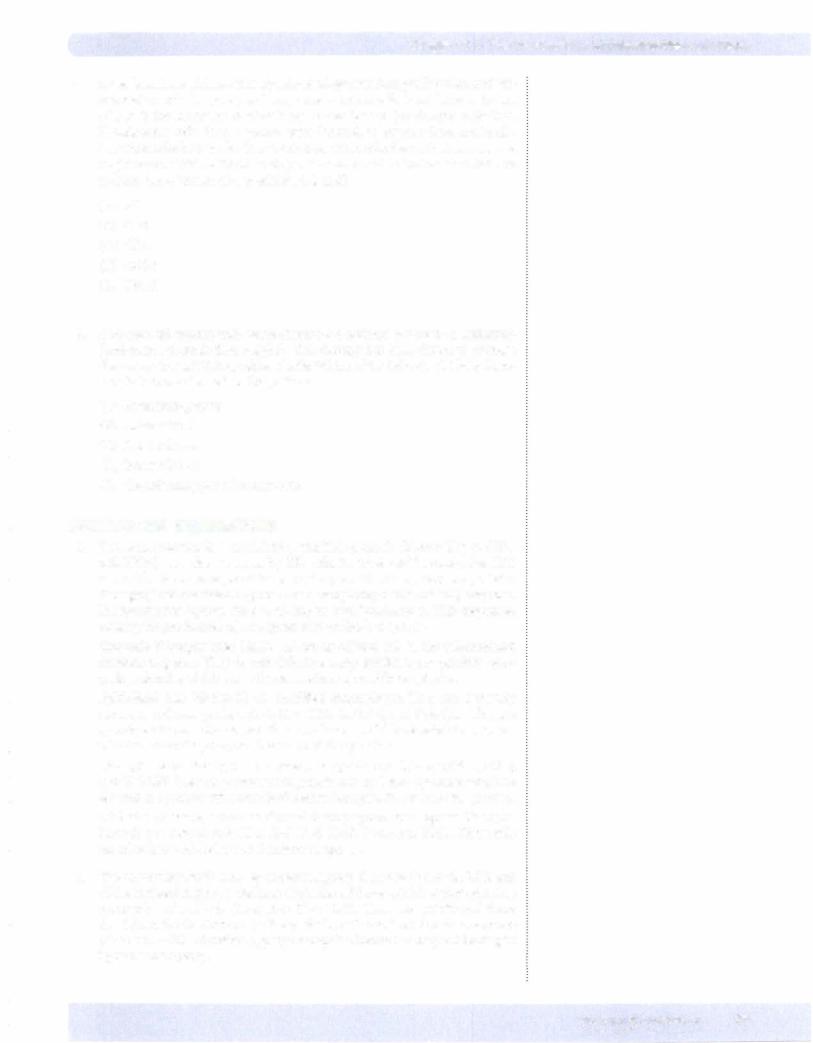
Chapter 6 • The Processing and Presentation of Antigen
4.It has been learned in several experimental systems that proliferation and dif ferentiation ofT lymphocytes in response to tumor cells is low because tumor cells lack the necessary costimulatory molecules for lymphocyte activation. If melanoma cells from a patient were induced to express these costimula tory molecules by transfection, production ofan effective antitumor response mightoccur.Whichofthe following molecules would be the best candidate for transfection oftumor cells to achieve this end?
(A)B7
(B)CD2
(C)CD4
(D)CD28
(E)LFA-I
5.A SO-year-old woman with severe rheumatoid arthritis is started on intliximab (anti-tumor necrosis factor-alpha). This therapy has been shown to increase the production ofCD25-positive T cells.Which ofthe following is likely, there fore, to become elevated in this patient?
(A)Interferon-gamma
(B)Interleukin-I
(C)Interleukin-2
(D)Interleukin-IO
(E)Transforming growth factor-beta
Answers and Explanations
1.The correct answer is D. IL-2, IFN-y, and TNF-P are allelaborated bythe THI cell. TNF-P can also be made by NK cells. In tuberculoid leprosy, the THI arm ofthe immune response is most active, resulting in a protective (but also damaging) cell-mediated response and a dampening ofthe antibody response. In lepromatous leprosy, the patient has an overabundance of TH2 responses, causing the production ofa nonprotective antibody response.
Cytotoxic T lymphocytes (choice A) are an effector cell in the cell-mediated immune response. They do not elaborate many cytokines but produce cyto toxic molecules, which cause the destruction ofspecific target cells.
Epithelioid cells (choice B) are modified macrophages. They are extremely secretory and may produce IL-1, IL-6, TNF-a, IFN-y, and GM-CSE They are prominent in granulomas, and their cytokines would be elevated in a patient with tuberculoid leprosy, but that was not the question.
Macrophages (choice C), once activated, mayproduce IL-1, IL-6, TNF-a, IFN-y, and GM-CSE They are prominent in granulomas, and their cytokines would be elevatedin apatientwithtuberculoidleprosy, butagain,thatwasnotthequestion.
TH2 cells (choice E) would be elevated during lepromatous leprosy. The cyto kines they secrete include IL-4, IL-5, IL-6, IL-10, IL-13 and TGFp. These cells are stimulators ofthe humeral immune response.
2.Thecorrectanswer is C. Inlepromatousleprosy, the activation oftheTH2 arm
ofthe immune response results in elicitation ofthose cytokines that stimulate production of antibody (IL-4, IL-5, IL-6, IL-10, IL-13 and TGF ) and those thatinhibitthe development ofthe protective cell-mediated immune response (IL-4 and IL-10). Therefore, hypergammaglobulinemia is a frequent finding in lepromatous leprosy.
MEDICAL 63

Section I • Immunology
Autoimmunity (choice A) may develop after infectious processes, but there is no evidence thatstimulation ofTH2 cells,byitself, causes autoimmune disease.
Granuloma formation (choice B) would be decreased after exposure to these cytokines. Granulomas are an expression of the delayed-type hypersensitivity response, which is a function of THl cells. IL-10 and IL-4 would depress the THl response.
Immediate hypersensitivity (choice D) requires sensitized mast cells and IgE antibodies. Although this result could occur in persons predisposed to atopic allergy, it is not the most likelyresult ofstimulation with TH2 cytokines.
Inflammation (choice E) is primarily mediated by substances released during tissue injury (leukotrienes, histamine, etc.) and the cytokines ofactivated mac rophages (IL-1, IL-6, and TNF-a). It is not enhanced by TH2 cytokines.
3.The correct answer is D. This patient is showing signs of toxic shock syn drome, caused by infection of the blister with Staphylococcus aureus and the resultant elaboration ofthe exotoxin TSST-1. This toxin acts as a superantigen, cross-linking the variable p region of the TCR to the a chain of the class II MHC molecule. This binds TH cells and APC together without the specificity ofantigen recognition, and so clonal proliferation ofT cells and production of IFN-y leads to activation of macrophages. As a result, the macrophages over produce the cytokines IL-1, IL-6, and TNF-a, which are toxic at high levels.
It acts as an IL-1 homologue (choiceA) is not true. IL-1 is produced bymacro phages as a result ofT-cell activation, but TSST-1 does not itselfact as an IL-1 homologue.
It activates B lymphocytes polyclonally (choice B) is not true. TSST-1 acts on TH cells to stimulate macrophage cytokines. It does not have a direct effect on B-cell proliferation.
It activates complement (choice C) is not correct. TSST-1 does not have an effect on complement.
It stimulates neutrophils (choice E) is not correct. Although neutrophils are stimulated during Staphylococcus aureus infection and produce IL-1, which causes fever, the mechanism ofaction ofTSST-1 and other superantigens is not through neutrophil activation.
4.The correct answer is A. The B7 molecule on antigen-presenting cells binds to the CD28 molecule on T lymphocytes and serves as a costimulatory signal for their activation. Ifthe tumor cells could be induced to express this costimula tory molecule, theywouldprovide the important activating signal to theT cells.
CD2 (choice B) is the molecule on T lymphocytes that binds to LFA-3 on antigen-presenting cells. If the tumor cell were induced to express CD2, it would bind to the complementary structure on macrophages and not activate the T cells.
CD4 (choice C) isthemolecule on T lymphocytes that stabilizesthe interaction of MHC class II and the TCR. Ifthe tumor cell were induced to express CD4, itwould not increase the tumor-specific response.
CD28 (choice D) is the molecule on T cells that binds to B7. Ifthe tumor cell were induced to express CD28, it would bind to the complementary structure on macrophages and not activate the T cells.
LFA-1 (choice E) is the molecule on T cells that binds ICAM-1 on the antigen presenting cells. Ifthe tumor cells were induced to express LFA-1, itwouldbind to the complementary structure on macrophages and not activate the T cells.
64 MEDICAL
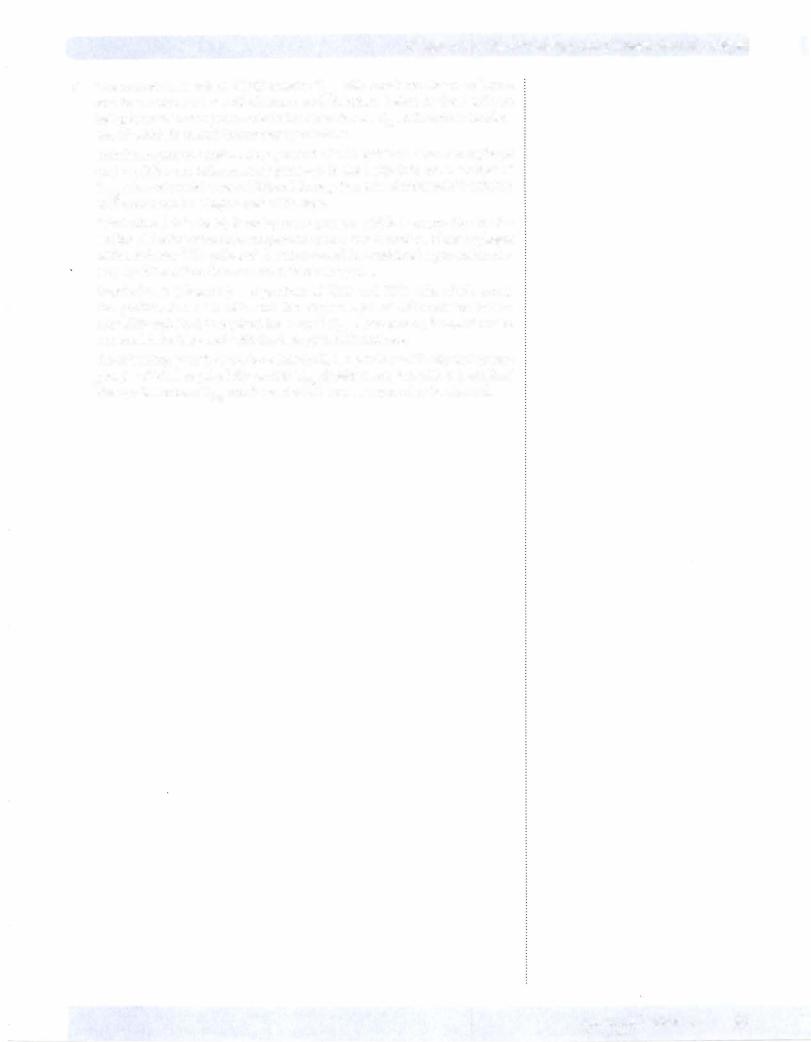
Chapter 6 • The Processing and Presentation ofAntigen
5.The correct answer is D. CD25-positive TRe cells have been shown to have a
role in maintenance of self-tolerance, and tlierefore, defects in these cells are being blamed in many cases ofautoimmune disease. TReg cells secrete interleu kin-10 which is an anti-inflammatory cytokine.
Interferon-gamma (choiceA) is aproduct ofTHl which activates macrophages and amplifies pro-inflammatory pathways in the body. It is not a product of TRe cells andwould cause additional damage in a case ofrheumatoid arthritis, so i would not be a logical goal oftherapy.
Interleukin-1 (choice B) is endogenous pyrogen which is responsible for the setting ofthe hypothalamic temperature point. It is a product ofmacrophages whichactivates THl cells, and therefore would be considered a pro-inflamma tory cytokine rather than an anti-inflammatory one.
Interleukin-2 (choice C) is a product of THO and THl cells which causes the proliferation of T cells and the effector cells of cell-mediated immu nity. Although IL-2 is required for natural TRe development, it would not be expected to be increasedwith the therapy menfioned here.
Transforming growth factor-beta (choice E) is a product ofT cells and macro _rhages which is required for natural TRe development, but with this artificial therapy to increase TReg numbers, it wocld not be expected to be elevated.
MEDICAL 65

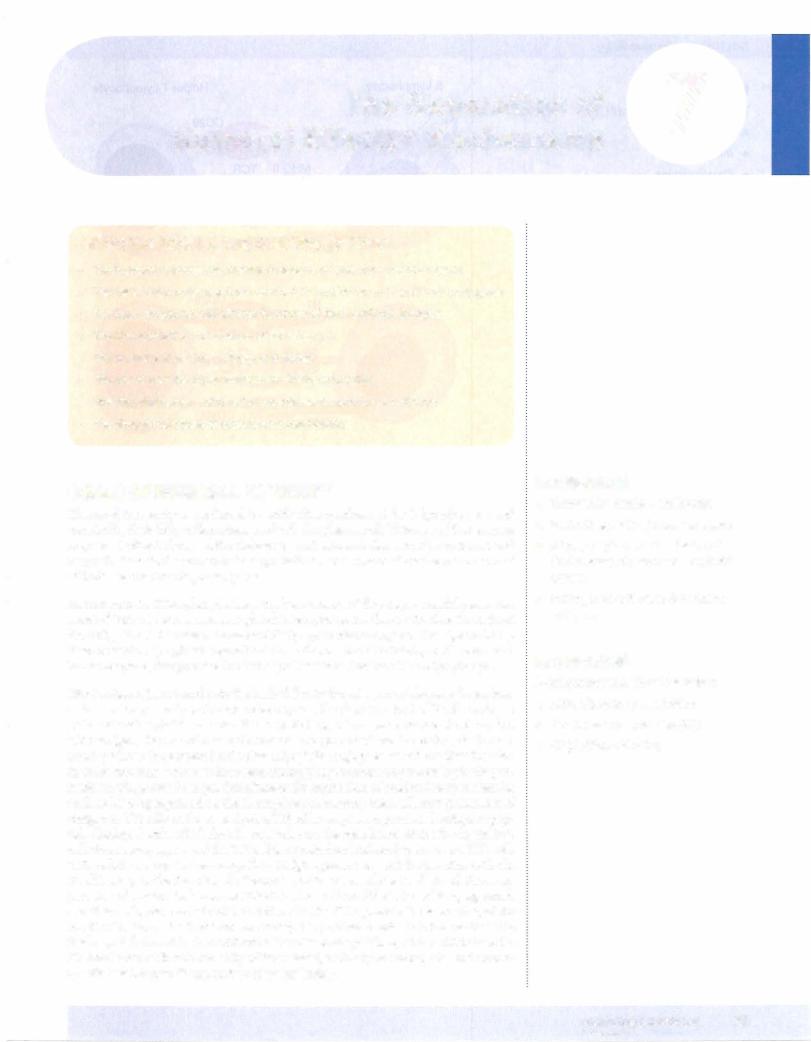
The Generation of |
7 |
Humoral Effector Mechanisms |
What the USMLE Requires You To Know
•The humoral responses to thymus-independent and -dependent antigens
•The cell surface molecules that contribute to production ofTand B-cell conjugates
•The basic structures and effector functions of the 5 antibody isotypes
•The characteristics and function of secretory lgA
•The meaning ofvalence, affinity, and avidity
•The role of somatic hypermutation in affinity maturation
•How the alternative and classical complement cascades are initiated
•The biologic functions of complement components
GOALS OF HUMORAL IMMUNITY
Humoral immunity is mediated by antibodies synthesized by B lymphocytes and secretedbytheirfullydifferentiated endcell, theplasmacell. This arm oftheimmune response is directedtowardthe defense against extracellular microbes or toxins and mayculminate in theextracellular degradation ofsuch materials orthe enhancement oftheir destruction via phagocytosis.
As mature naive B lymphocytes leavethebone marrowfollowing successful rearrange ment oftheir membrane immunoglobulin receptor genes, they recirculate throughout thebody, attractedtofollicularareas ofthelymphnodes and spleen. Ifantigenentering these secondarylymphoid organs binds to and cross-links the idiotypes ofthese mem brane receptors, this provides the first signal for the activation ofthe B lymphocyte.
Most antigens introduced into the body fall into the category ofthymus-dependent antigens. Response to such molecules requires the direct contact ofB cells with TH cells and their cytokines. After the cross-linking of receptors on the B-cell surface with antigen, the material is endocytosed and processed via the endocytic (exoge nous) pathwayto generateMHC class II/peptide conjugates, which are then inserted inthe membrane,just aswehaveseenduringphagocytosis andprocessinginthepro fessional phagocyte lineages. Simultaneously, expression ofcostimulatory molecules such as B7 is upregulated on the B lymphocyte, making them effective presenters of antigen to TH cells in thearea. Once a TH cell recognizes a processed antigenic pep tide displayed with MHC class II molecules on the membrane ofthe B cell, the two cells form a conjugate, andthe TH cellis activated andinducedtobecome a TH2 cell. TH2 cells in conjugates rearrange their Golgi apparatus toward thejunctionwiththe
B cellleadingto the directional release ofcytokinestowardthe B cell. In addition, ex pression ofa molecule known as CD40L on the surface ofthe TH2 cell is upregulated, and this molecule interacts with CD40 on the B cell to provide the second signal for B-cell activation. The B cells are encouraged to proliferate after this interaction. The final signaldeliveredbythe TH2 cell is the release ofcytokines, whichwill induce the differentiation ofB cells into fully differentiated, antibody-secreting cells and memo rycells (see Chapter 9) and induce class switching.
In a Nutshell
•Humoral immunity = antibodies
•Defends against extracellular agents
•B lymphocytes are attracted to fol licular areas of secondary lymphoid organs.
•Pathogens are thymus-dependent antigens.
In a Nutshell
B-cell contact with TH cells requires:
•MHC II/peptide presentation
•Costimulatory molecules (B7)
•CD40/CD40L binding
MEDI CAL 67

Section I • Immunology
In a Nutshell
TH2 cytokines induce B-cell:
•Differentiation
•Memory
•Class switching
68 MEDICAL
B Lymphocyte |
Helper T Lymphocyte |
Activated B cell
Proliferating B cells
Figure 1-7-1 . The Formation of T- and B-Cell Conjugates
T cells recognize peptides bound to MHC molecules. Therefore, antigens that pos sess no peptide structure cannot be recognized by T cells. These antigens are called thymus-independent antigens and include lipopolysaccharide from the cell enve lope ofgram-negative bacteria and polysaccharide capsular antigens. These antigens maydirectlystimulate B cells to causeproliferation and secretion ofantibody, orthey
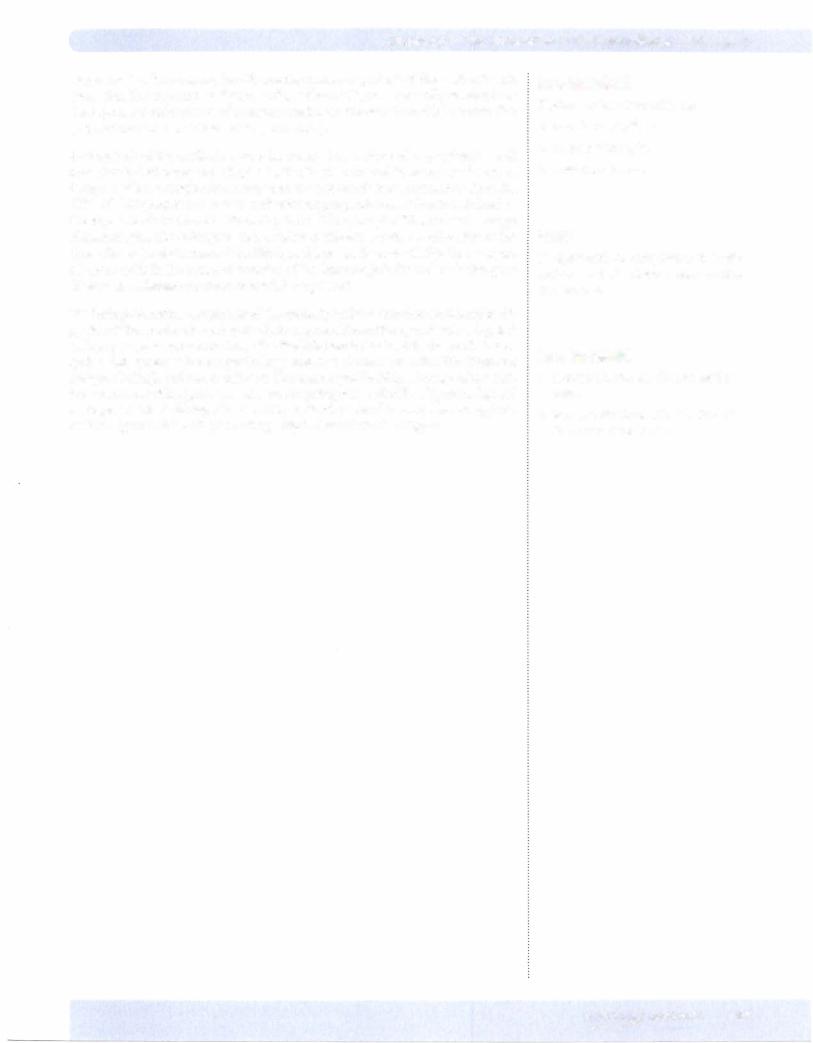
Chapter 7 • The Generation of Humoral Effector Mechanisms
mayact as B-cell mitogens, directly causing mitosis regardless ofthe cell's antigenic specificity. The response to thymus-independent antigens is generally weaker than the response to other classes ofantigens, resultingin the secretion oflgM antibodies only and the absence ofimmunologic memory.
Although all of the antibody molecules secreted by a clone of B lymphocytes will have identical idiotypes (see Chapter 2), the B cell is induced to make new classes, or isotypes, of irnmunoglobulin in response to cytokine-directed instruction from the TH2 cell. The progression ofnew antibodyisotypes produced by B cells is defined by the sequence ofconstant domain coding in theB-lymphocyte DNA, and each isotype ofimmunoglobulin is designed with a different effector function in mind. Just as the three-dimensional structure ofthe idiotype defines antigen specificity, the sequence of amino acids in the constant domains ofthe immunoglobulin molecule (isotype) dictates the effector functions thatwill be expressed.
The biologic function ofsegments ofthe antibody molecule was first elucidated by di gestionofthesemoleculeswithproteolytic enzymes. Ifan antibodymolecule is digested with papain, cleavage occurs above the disulfide bonds that hold the heavy chains to gether. This generates three separate fragments, two ofwhich are called Fab (fragment antigen binding), and one is called Fe (fragment crystallizable). Cleavage ofthe anti body molecule with pepsin generates one large fragment called F(ab ')2 and a digested Fe fragment. The bridging ofantigens by antibody molecules is required for aggluti nation ofparticulate antigens or the precipitation ofsoluble antigens.
In a Nutshell
Thymus-independent antigens:
•contain no peptides.
•stimulate only lgM.
•create no memory.
Note
Mitogens activate many clones of B cells and are used clinically to assess lympho cyte function.
In a Nutshell
•lsotype switching is directed by TH2 cells.
•lsotypes dictate effector function of the antibody molecule.
M EDICAL 69
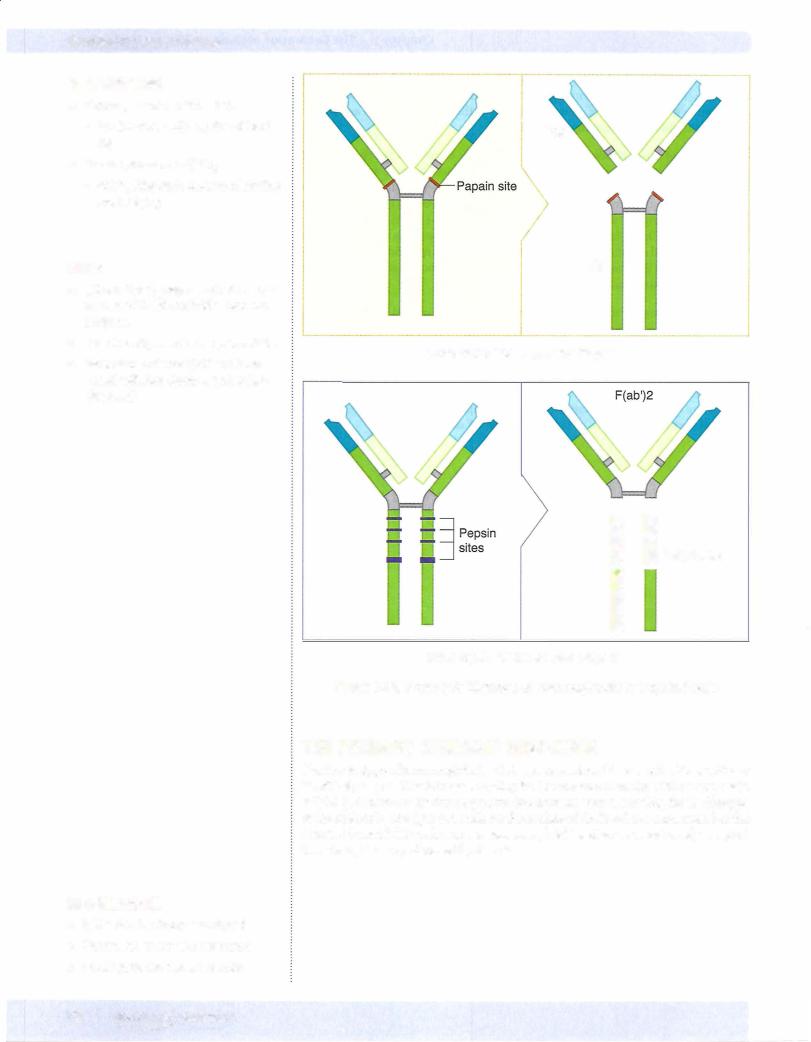
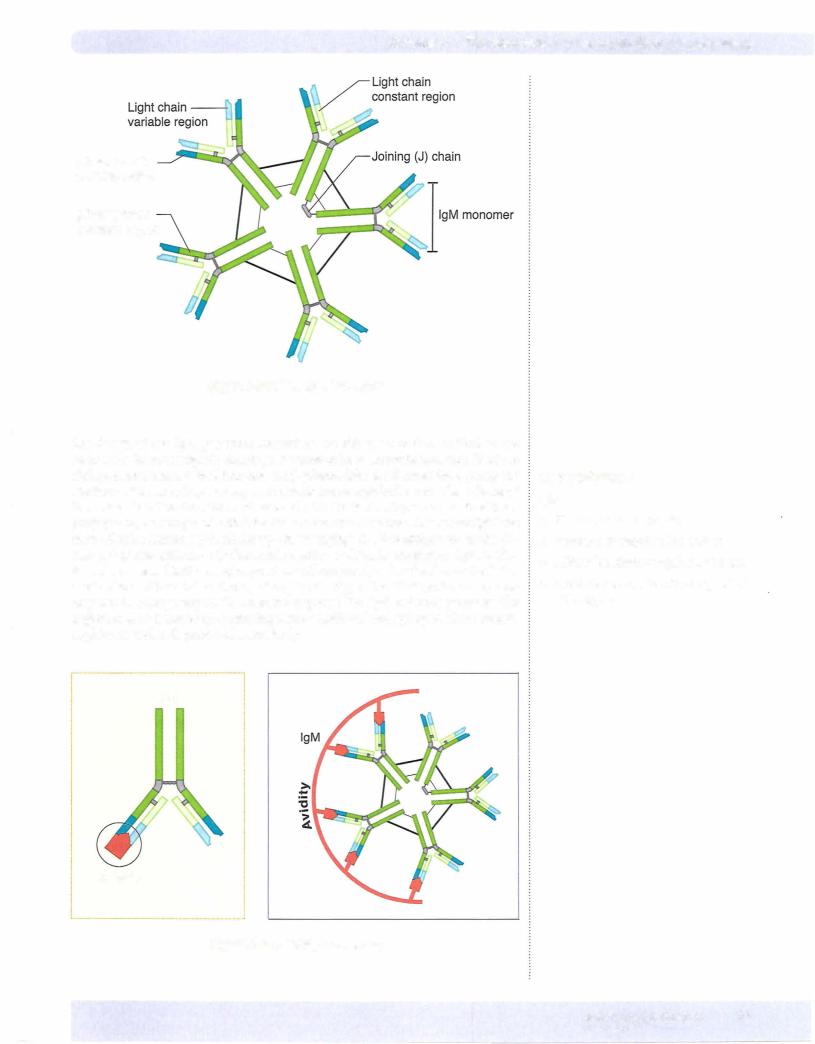
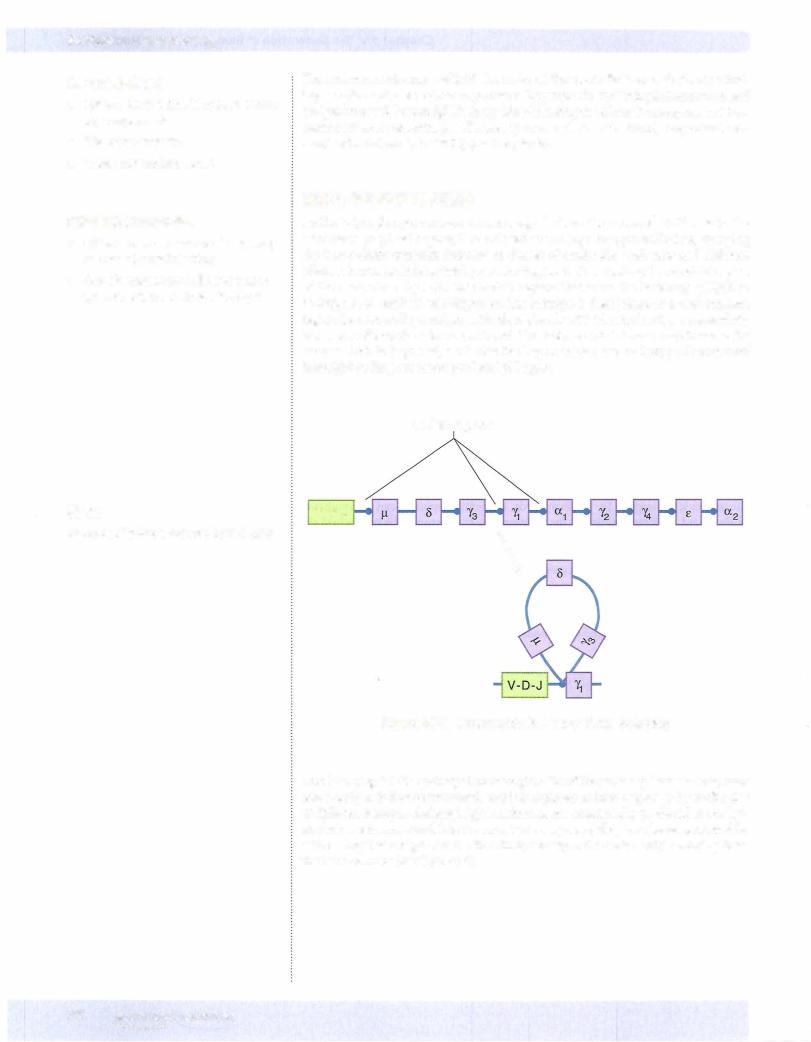
Section I • Immunology
In a Nutshell
•lgM is most effective isotype at activat ing complement.
•It is not an opsonin.
•It does not mediate ADCC.
Clinical Correlate
•lgM is used as a measure of a primary response (acute infection).
•Convalescent serum will have mostly lgG with subthreshold levels of lgM.
Themultimeric structure ofigM also makes it the most effective antibodyatactivat ing complement, a set ofserum proteases important in mediating inflammation and antigen removal. Serum IgM is incapable ofbinding to cellular Fe receptors and thus cannot act as an opsonin (see Chapter 5) or a mediator ofantibody-dependent cell mediated cytotoxicity (ADCC) (see Chapter 8).
ISOTYPE SWITCHING
As the B lymphocyte receives cytokine signals from the activated TH2 cells in the secondary lymphoid organs, it is induced to undergo isotype switching, changing the heavy-chain constant domains to classes of antibodies with new and different effector functions. It does this byrearranging the DNA encoding the constant region of the heavy chain by activating switch regions that cause the intervening DNA to be looped out, excised, and degraded. The idiotype is then joined to a new constant region domain coding, and an antibody molecule with identical antigenic specificity but a new effector function is produced. This isotype switch is one-way: Because the excised DNA is degraded, a cell that has begun to produce an isotype downstream from IgM coding can never produce IgM again.
Switch regions
Note
lsotype switching is induced by TH2 cells.
V-D-J
\
Figure 1-7-5. lmmunoglobulin Heavy Chain Switching
This is why IgM isthe principal immunoglobulin ofthe primary immune response when antigen is first encountered, and it is replaced in later responses by antibodies ofdifferent isotypes. Although IgM antibodies are occasionally produced at lowlev els during secondary and later immunologic responses, they are always produced by cells seeing that antigen for the first time; namely, naive cells newly emerging from the bone marrow (see Chapter 9).
72 MEDICAL
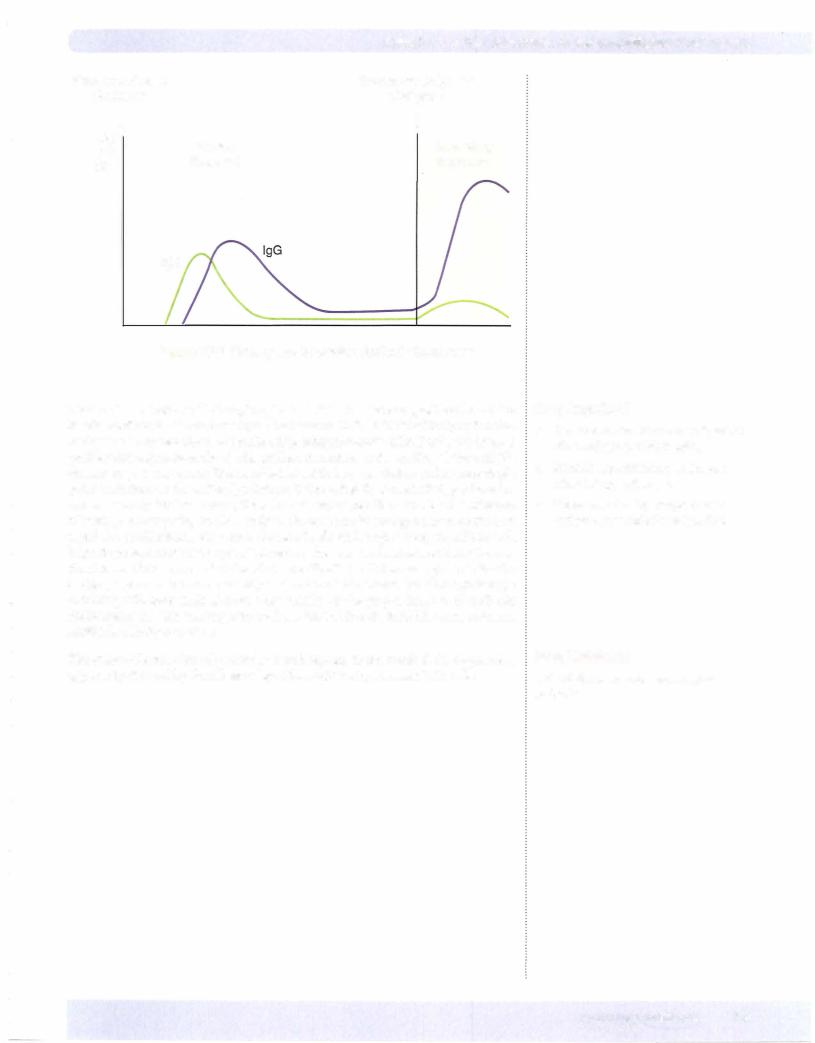
Chapter 7 • The Generation of Humoral Effector Mechanisms
Primary antigenic |
|
Secondary antigenic |
|
challenge |
|
challenge |
|
Log |
|
l |
|
Ab l |
Primary |
Secondary |
|
Titer |
response |
|
response |
|
|
|
|
lgM
Figure 1-7-6. Primary and Secondary Antibody Responses
During the activation of B lymphocytes by TH2 cells, intense proliferation of the B cellsresults in the formation ofgerminal centers in thefollicles ofthe lymph nodes and spleen. Theseareclonesofproliferating, antigen-specific cells. Duringthe intense proliferative response ofthe B cell, random mutations in the coding of the variable domain region may occur. This is called somatic hypermutation and creates single point mutations in the antibody idiotype. Ifthese slightly altered idiotypes have in creased affinity for the antigen, then the cell expressing them willbe at a selective advantage in competing to bind antigen. Because binding antigen serves as the first signal for proliferation, over time, clones of cells with higher receptor affinity will begin to predominate in the germinalcenter. This clonalselectionresults in the pre dominance ofclones capable ofproducing antibodies with increasing affinity for the antigen, a process known as affinity maturation. This means that although isotype switching willnecessarily decrease the avidity of the preponderance of antibody molecules as the immune response evolves, this willbe substituted by an increase in antibody affinity over time.
The choice of activation ofparticular switch regions in the B-cell DNA sequence is apparently dictated by the release ofspecific cytokines by activated TH2 cells.
In a Nutshell
•Germinal centers are clones of prolifer ating antigen-specific B cells.
•Somatic hypermutation may cause minor idiotype changes.
•Clonal selection by competition for antigen causes affinity maturation.
In a Nutshell
TH2 cytokines dictate switch region activation.
MEDICAL 73
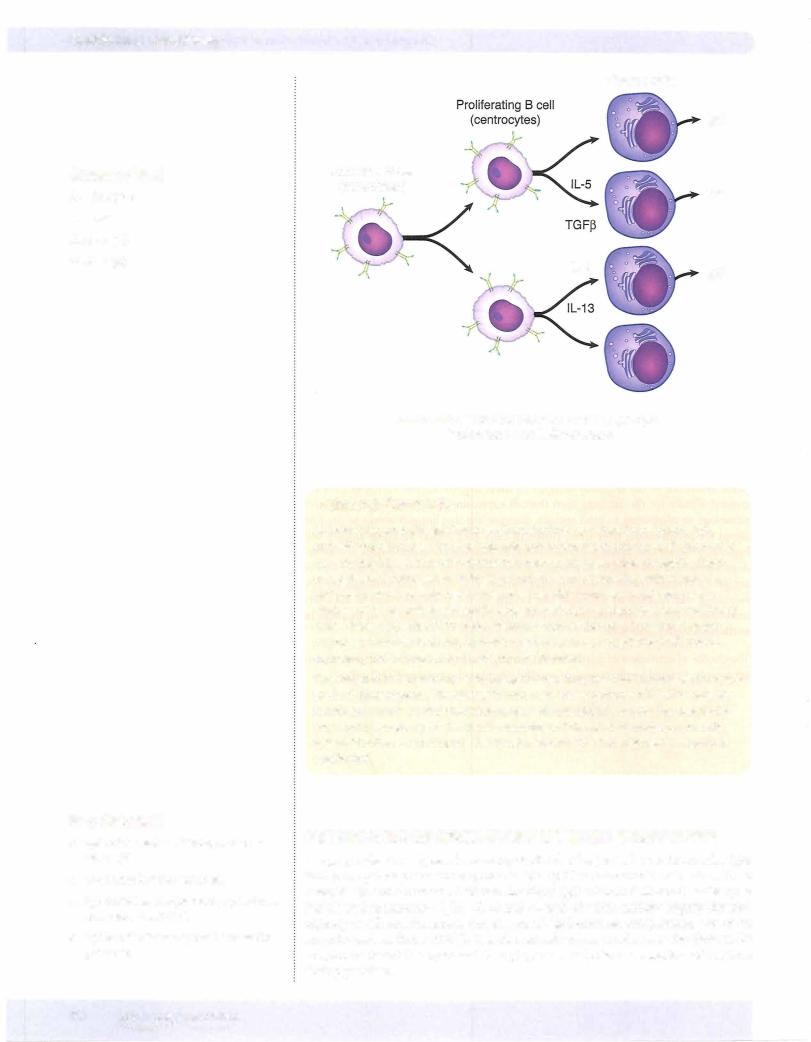
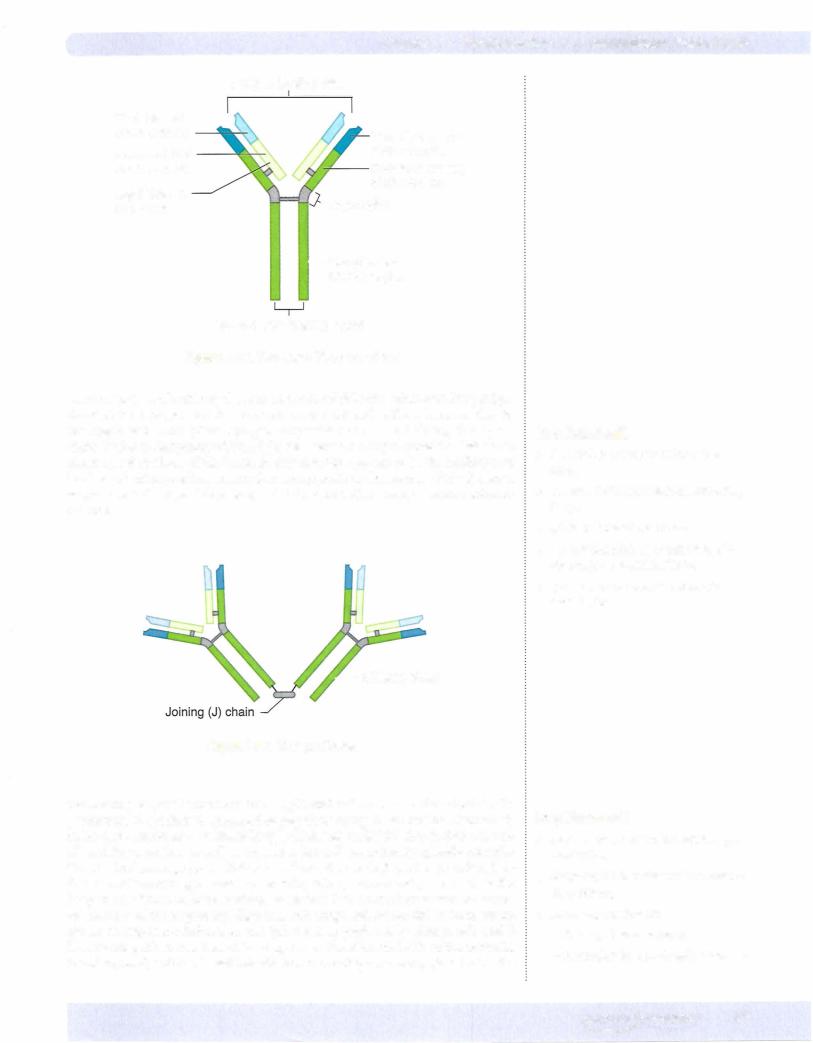
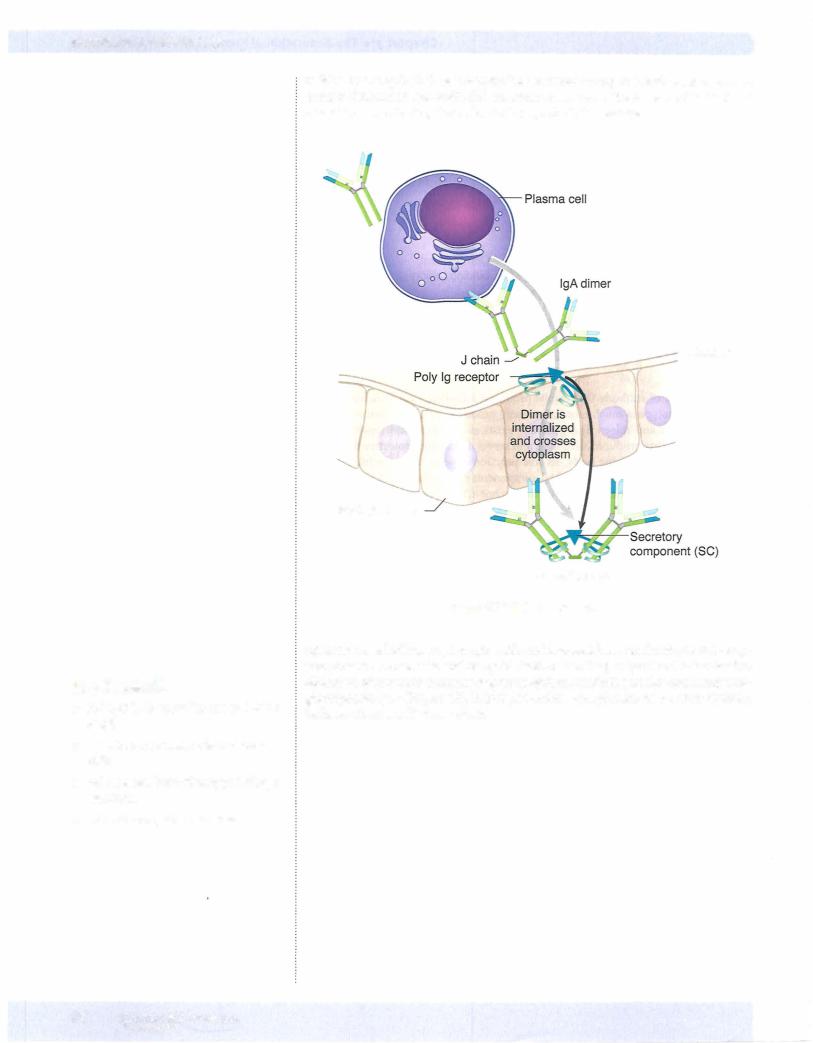
Section I • Immunology
In a Nutshell
•IL-4 and IL-13 cause isotype switching to lgE
•lgE is bound to mast cells and baso phils.
•lgE mediates immediate type I allergic reactions.
•lgE protects against parasites.
residue ofthe epithelial-cell receptor. The secretory component thus serves an im portant function in transepithelial transport, and once in the lumen ofthe tract, has a function in protecting the molecule from proteolytic cleavage.
Mucosa
Epithelial cells
Secretory lgA
Figure 1-7-10. Secretory lgA
IgEis the so-called homocytotropic antibodybecause itbinds to directlyto Fe£recep tors present on mast cells and basophils (without binding antigen) and is involved in elicitation ofprotective immune responses against helminth parasites and many aller gic responses (see Chapter 13). It does not activate complement or act as an opsonin. Its heavychain is called an £ chain.
76 MEDICAL
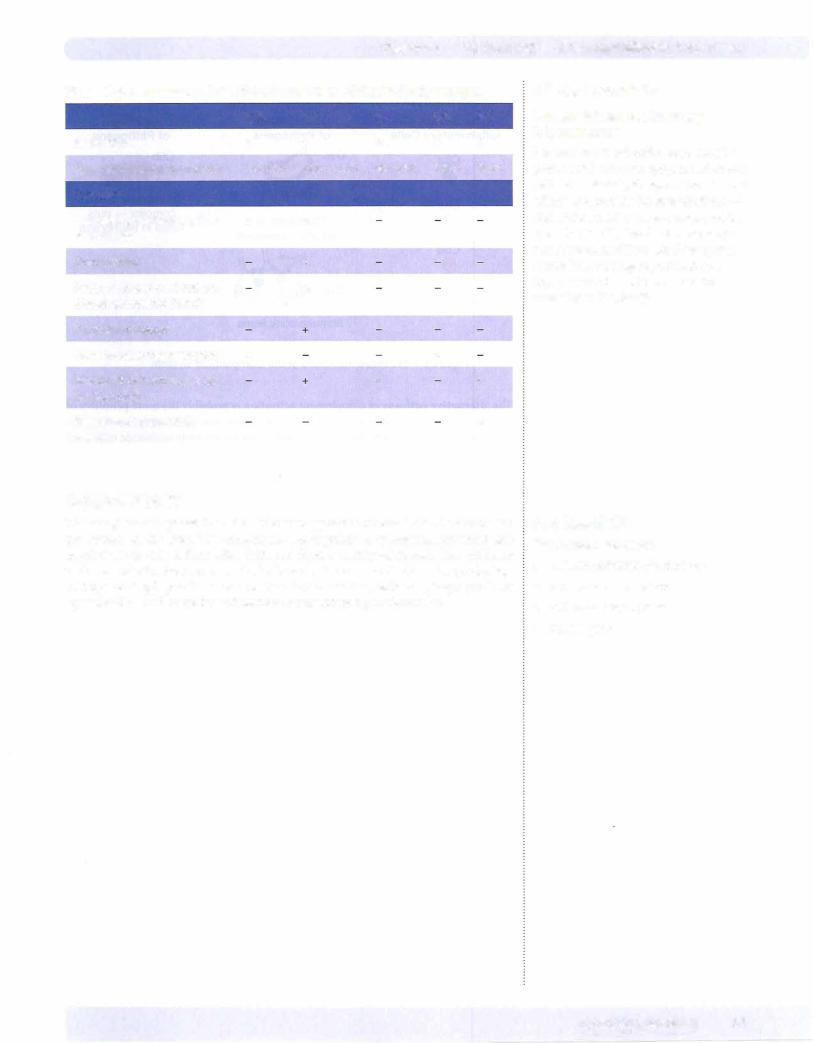

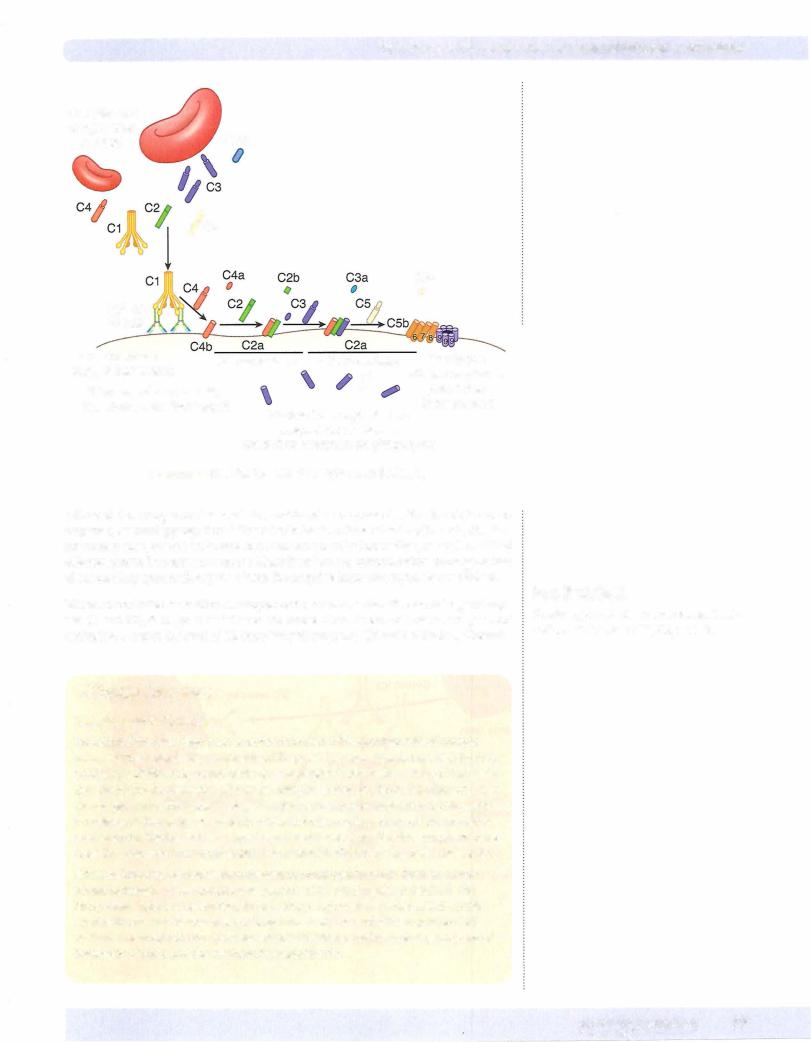
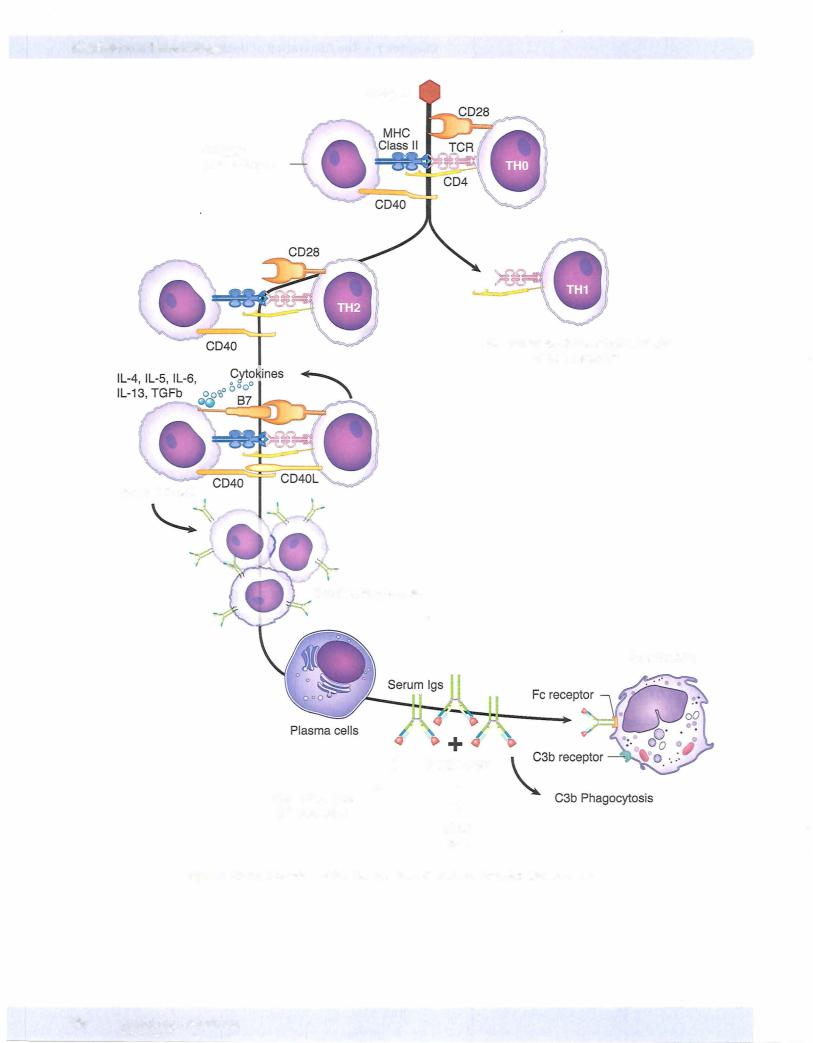
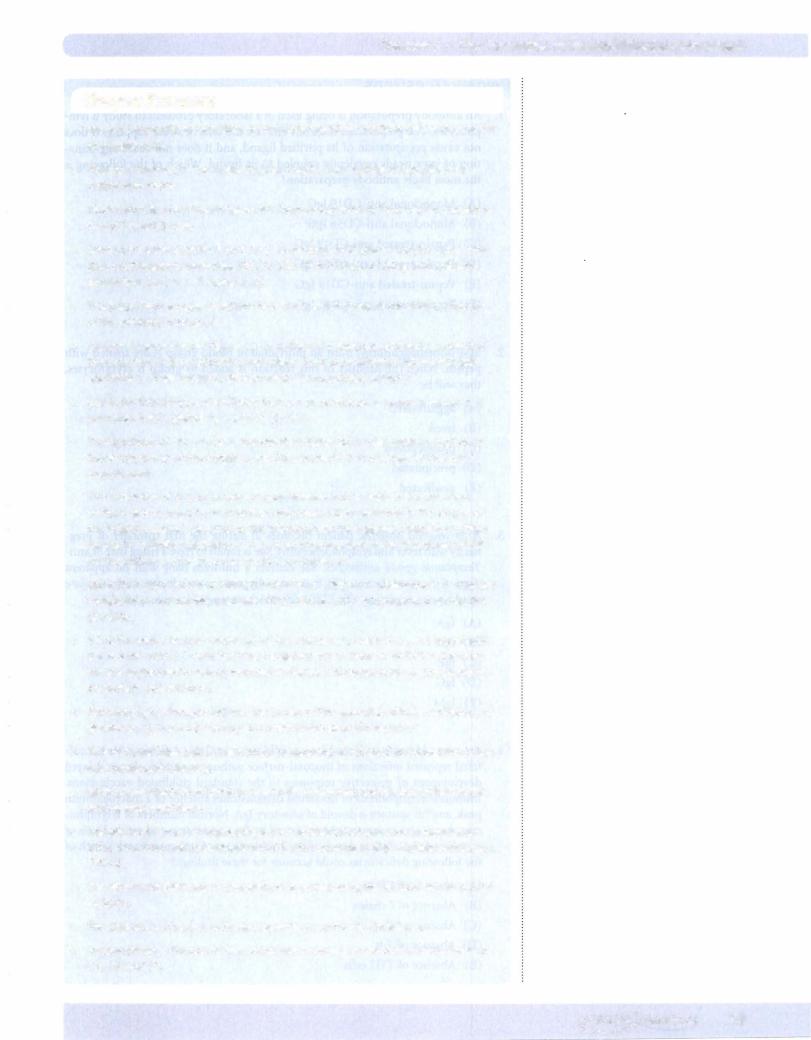
Chapter 7 • The Generation of Humoral Effector Mechanisms
ChapterSummary
•Humoral immunity is mediated by antibodies synthesized by B cells and secreted by plasma cells.
•Humoral immunity is the major defense mechanism against extracellular mi crobes and toxins.
•Most naturally occurring antigens are thymus-dependent: They require collabora tion ofTH and B cells.
•Contact between specific B and TH cells involves MHC class II/peptide presenta tion, costimulatory molecules (B7/CD28), CD40/CD40L binding, and cytokine production (IL-2, IL-4, IL-S,and IL-6).
•TH2 cells direct isotype switching by B cells, which changes the effector function ofthe antibody produced.
•Thymus-independent antigens, such as bacterial lipopolysaccharide, cross-link the receptors of B lymphocytes and cause them to proliferate and secrete lgM antibodies. These antigens do not create "immunologic memory."
• lgM is the first isotype ofantibody that can be produced. It exists in serum as a pentamer held together by a joining 0) chain.
•The functions of lgM are (as a monomer) receptor on B cells, antigen capture in the secondary lymphoid organs, and (as a pentamer) in plasma, activation of complement.
•TH2 activation of B lymphocytes causes intense proliferation in the germinal
centers, and somatic hypermutation may cause slight variation in the shape of the idiotype. Clonal selection ofthe idiotype with the highest affinity for antigen results in "affinitymaturation": a general improvement in the "goodness-of-fit" for the antigen as the immune response progresses.
•lgG is the major isotype produced after lgM. It exists in 4 subisotypes. It activates complement, opsonizes, mediates ADCC, and is actively transported across the placenta.
•lgA is the major isotype produced in the submucosa, colostrum, and breast milk. It is a dimer with a J chain holding it together. It functions in inhibiting the bind ing of substances to cells or mucosa[ surfaces. It does not activate complement or mediate opsonization.
•Secretory lgA is transported into the lumen ofthe gastrointestinal, respiratory, or genitourinary tracts by bindingto a polyimmunoglobulin receptor.
•This receptor (now called a secretory component) is retained for protection of lgA from proteolytic cleavage.
•lgE is the antibody that binds to mast cells and is responsible for antihelminthic and allergic responses.
•Complement is a set of interacting serum proteins that enhance inflammation
(C3a, C4a, CSa) and opsonization (C3b) and cause lysis of particulate substances (CSb-9).
•The alternative pathway of complement is activated by interaction with microbial surfaces.
•The classical pathway is activated by antigen-antibody complexes.
•Inappropriate activation ofthe complement cascade is controlled at the level of Cl, C3, and CS.
MEDICAL 81
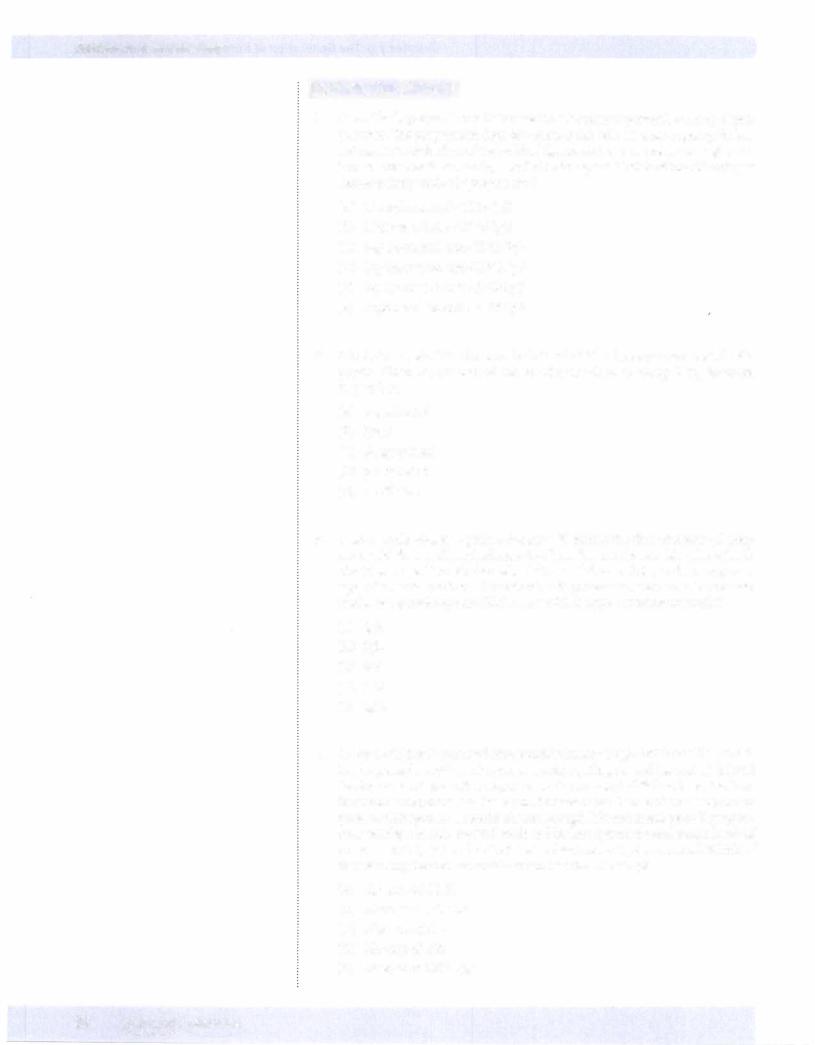
Section I • Immunology
Review Questions
1. An antibodypreparation is being used in a laboratoryprotocol to study B lym phocytes. The preparation does not activate the cells or cause capping. It does not cause precipitation of its purified ligand, and it does not cause agglutina tion of latex beads covalently coupled to its ligand. Which of the following is the most likely antibody preparation?
(A)Monoclonal anti-CD19 IgG
(B)Monoclonal anti-CD56 IgG
(C)Papain-treated anti-CD19 IgG
(D)Papain-treated anti-CD56 IgG
(E)Pepsin-treated anti-CD19 IgG
(F)Pepsin-treated anti-CD56 IgG
2.IgM isohemagglutinins from an individual of blood group A are treated with pepsin. When the product of this reaction is added to group B erythrocytes, they will be
(A)agglutinated
(B)lysed
(C)phagocytized
(D)precipitated
(E)unaffected
3.A 26-year-old obstetric patient becomes ill during the first trimester of preg nancywithfeverandlymphadenopathy. She isfound to have arisingtiterofanti antibodies. She delivers a full-term baby with no apparent signs ofinuteroinfection. The best testto diagnoseacuteinfectionintheneonate
would be a parasite-specific ELISA for which isotype ofimmunoglobulin?Toxoplasma gondii
(A)IgA
(B)IgD
(C)IgE
(D)IgG
(E)IgM
4.A 4-year-oldboyis evaluatedfor a possible immunologic deficiency. He has suf fered repeated infections of mucosal-surface pathogens and has shown delayed development of protective responses to the standard childhood vaccinations. Immunoelectrophoresis ofhis serum demonstrates absence ofa macroglobulin peak, and his sputum is devoid ofsecretoryIgA. Normal numbers ofB lympho cytesbearingmonomeric IgM are found byflow cytometry, and serumlevels of monomeric IgA,IgE,and each ofthe 4 subisotypes ofIgGare normal.Which of the following deficiencies could account forthesefindings?
(A)Absence ofCD40
(B)Absence ofJ chains
(C)Absence ofIL-4
(D)Absence ofTdt
(E)Absence ofTH2 cells
82 MEDICAL
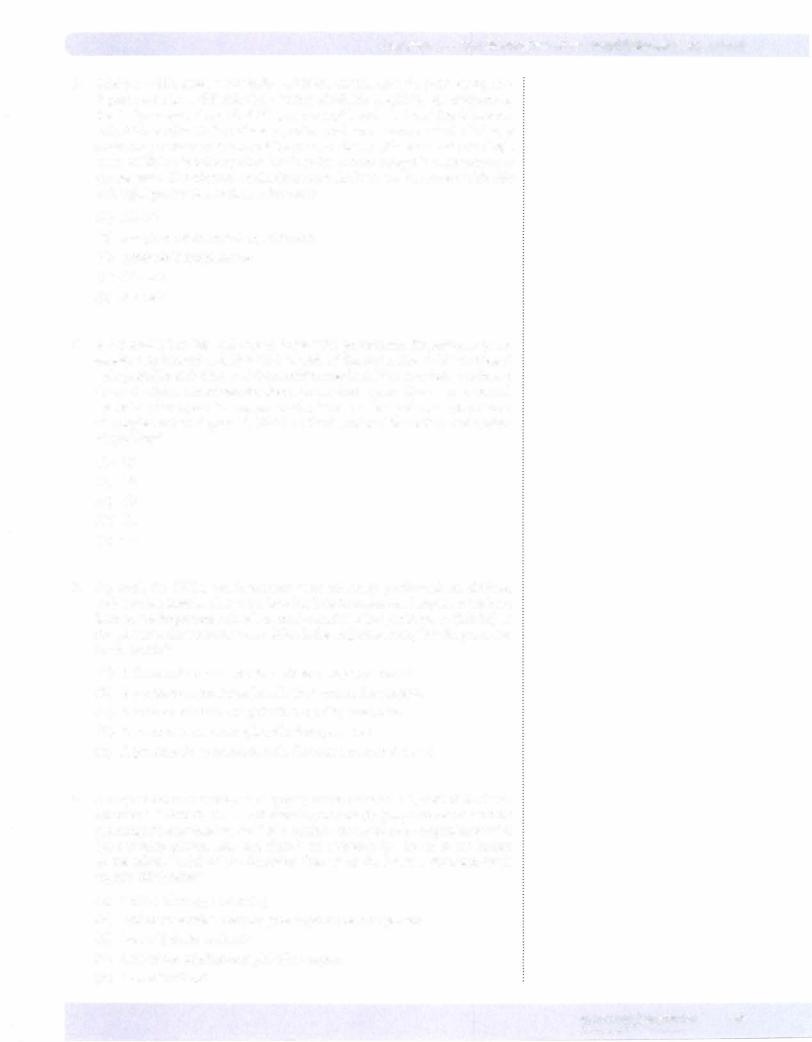
Chapter 7 • The Generation of Humoral Effector Mechanisms
5.A 56-year-oldhomeless, alcoholic, and febrile manisbrought to the emergency department after a difficult night during which his coughing kept everyone at the shelter awake. On arrival his pulse is rapid, and his breathing is labored with diffuse rales. Endotracheal aspirates produce a mucopurulent discharge containing numerous gram-positive cocci in chains. His serum contains high titers ofIgM antibodies specific for the polysaccharide capsule ofStreptococcus pneumoniae. The effector mechanism most likely to act in concert with this early IgM production to clear infection is
(A)ADCC
(B)complement-mediated opsonization
(C) cytotoxic T lymphocytes (D) LAK cells
(E)NK cells
6.A 3-year-old boy has had several bouts with pneumonia. Streptococcus pneu moniae was isolated and identified in each of the cases. The child was treated with penicillin each time, and the conditionresolved. He is nowbeing evaluated
fora potentialimmunologic deficiency. Serum electrophoresis shows age-normal valuesforallisotypes ofimmunoglobulin,but serumlevelsofsome components ofcomplement are depressed. Which ofthe followingdeficiencies could explain his problem?
(A)Cl
(B)C2
(C)C3
(D)C4
(E)CS
7.Up until the 1970s, tonsillectomies were routinely performed on children with swollen tonsils. This procedure has lost its widespread appeal as we have learned the important role of mucosal-associated lymphoid tissue (MALT) in the protective immune response. What is the major immunoglobulin produced by the MALT?
(A)A dimeric immunoglobulin with secretory component
(B)A monomeric immunoglobulin that crosses the placenta
(C) A monomeric immunoglobulin bound by mast cells
(D)A monomeric immunoglobulin that opsonizes
(E)A pentameric immunoglobulin that activates complement
8.A 64-year-old man undergoes surgeryto excise 18 inches ofbowel with adeno carcinoma.When the tissue and draining mesenteric lymph nodes are sent for pathologist's examination, the Peyer patches are noted to be hyperplastic with IgA-secreting plasma cells, but there is no secretory IgA found in the lumen of the colon. Which of the following changes in the bowel epithelium could explain this finding?
(A) Failure ofisotype switching
(B) Failure ofvariable domain gene-segment rearrangement
(C) Loss ofJ chain synthesis
(D) Loss ofthe polyimmunoglobulin receptor
(E)Loss ofTH2 cells
M EDICAL 83
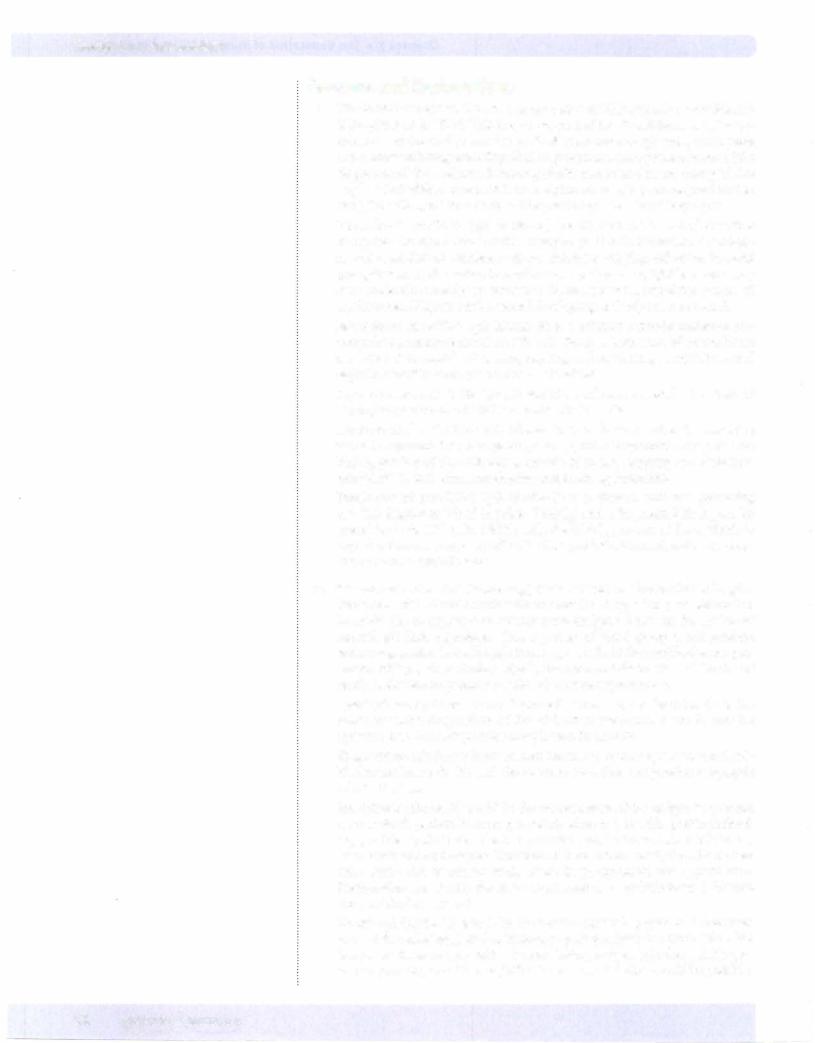
Section I • Immunology
Answers and Explanations
1.ThecorrectanswerisC.The cell surface markerwhich istypicallyusedtoidentify
B lymphocytes is CD19. This is a component of the B-cell/signal transduction complexand thuswillbe found on allB cells. Treatment ofIgGwithpapain yields twomonovalentantigenbinding (Fab) fragments and destroys the function ofthe Fe portion of the molecule. Immunoglobulin molecules that are disrupted this way lose their ability to cross-link the receptors on cells, to promote precipitation or agglutination, and to activate cells by providing a first stimulatory signal.
Monoclonal anti-CD19 IgG (choice A) is a divalent antibody molecule that recognizes the signal transduction complex on B cells. Monoclonal antibod ies can cross-link cell-surface receptors and cause capping, cell activation, and precipitation. Agglutination is usually accomplished using IgM because a very large molecule is needed to overcome the zeta potential (repulsive charge) of erythrocytes. If IgG is used, a second developing antibody must be added.
Monoclonal anti-CD56 IgG (choice B) is a divalent antibody molecule that recognizes a molecule found on NK cells. Because both arms of the molecule
are intact, it is capable of causing capping, cell activation, precipitation, and agglutination if a developing antiserum is added.
Papain-treated anti-CD56 IgG (choice D) would not be used for the study of B lymphocytes because CD56 is a marker for NK cells.
Pepsin-treated anti-CD19 IgG (choice E) is a divalent molecule possessing two Fab fragments joined together (F[ab']2), and a fragmented Fe region. The F(ab')2 portion of the antibody is capable of causing capping, cell activation, precipitation, and, with a developing antiserum, agglutination.
Pepsin-treated anti-CD56 IgG (choice F) is a divalent molecule possessing two Fab fragments joined together (F[ab']2) and a fragmented Fe region. Its specificity is for NK cells. Additionally, the F(ab')2 portion of the antibody is capable of causing capping, cell activation, precipitation, and, with a develop ing antiserum, agglutination.
2.Thecorrect answer isA. Isohemagglutinins are IgM antibodies that will agglu tinate the RBCs of individuals with another blood type. They are believed to
be made due to exposure to cross-reactive antigens found on the surface of normal gut flora organisms. Thus, a person of blood group A willproduce isohemagglutininsthat will agglutinate type B cells. Ifthese antibodies are pre treated with pepsin, a divalent F(ab')2 fragment and destruction of the Fe will result. A divalent fragment is capable ofcausing agglutination.
Lysed (choice B) is not correct because it would require the integrity of the complement-binding regions of the IgM, which are found in the Fe, and the question stem does not provide complement in the mix.
Phagocytized (choice C) is not correct because it would require an intact cell binding region in the Fe, and the question stem does not provide phagocytic cells in the mix.
Precipitated (choice D) would be the correct answer ifthe antigen in question were a soluble protein. Proteins precipitatewhen treatedwith specific antibod ies, particles agglutinate. The two particles used in laboratory medicine are latex beads and erythrocytes. Ifneither ofthese is mentioned, then the student can assume that treatment would result in precipitation, not agglutination. Precipitation has exactly the same requirements as agglutination: a divalent antigen-binding molecule.
Unaffected (choice E) would be the correct answer if papain had been used to treat the isohemagglutinins. Because papain produces two monovalent Fab fragments, these are incapable of cross-linking antigen (whether soluble pro tein or particle), so neither agglutination nor precipitation would be possible.
84 MEDICAL
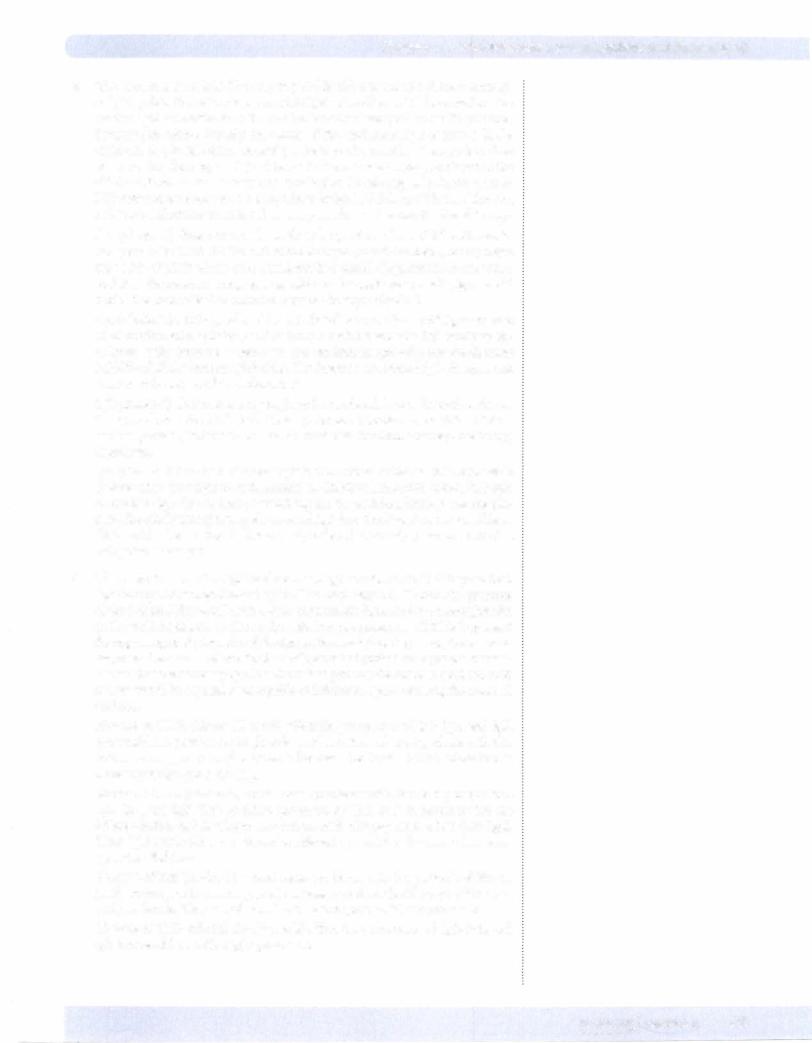
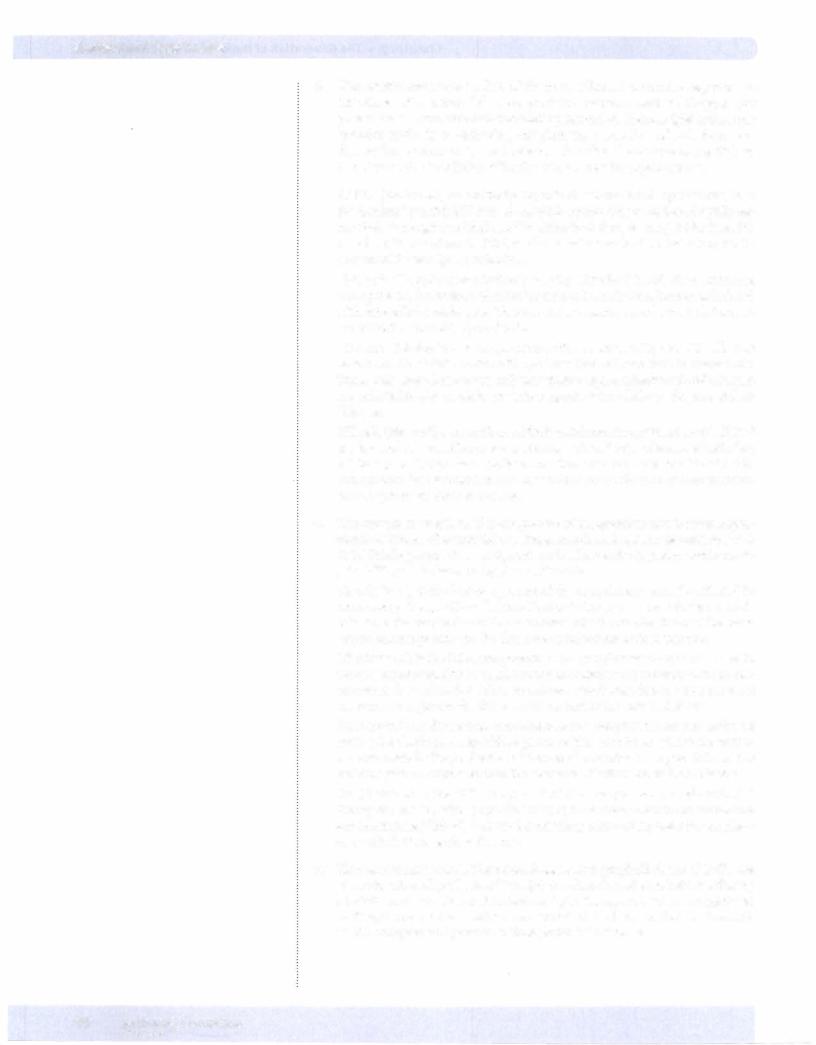
Section I • Immunology
5. The correct answer is B. One of the most effective protective responses to infections with extracellular, encapsulated bacteria, such as Streptococcus pneumoniae, is complement-mediated opsonization. Because IgM is the most effective antibody at activating complement, generation of C3b fragments during this process coats the bacteria and makes them more susceptible to ingestion and intracellular killing by cells of the phagocytic system.
ADCC (choice A), or antibody-dependent cell-mediated cytotoxicity, is a mechanism by which NK cells, neutrophils, macrophages, and eosinophils can use their Fe receptor to bind specific antibody and target an agent for lysis. No cells have Fe receptors for IgM, so this is not a mechanism that could act in concert with early IgM production.
Cytotoxic T lymphocytes (choice C) identify altered-self/MHC class I molecule conjugates on the surfaces ofcells that are malignantly transformed or infected with intracellular pathogens. They are not a protective mechanism that acts in concertwithanyantibody molecule.
LAK cells (choice D), or lymphokine-activated killer cells, are NK cells that have been stimulated in vitro with cytokines that enhance their killingactivity. These cells have a function in earlysurveillance against altered-selfcells,but are notbelieved to playa role in protection against extracellular pathogens, such as this one.
NK cells (choiceE) are members ofthe innate immune system and arebelieved to play a role in surveillance againsttumor cells and other altered-selfcells that fail to express MHC class I antigens on their surfaces. They would not act in concert with IgM production, and theywould notbe effective against an extra cellular pathogen, such as this one.
6. The correct answer is C. The component of complement that is most impor tant in clearance ofextracellularpathogens such as Streptococcus pneumoniae is C3b. This fragment acts as an opsonin and enhances the ingestion and intracel lular killing ofthe bacteria by phagocytic cells.
Cl (choice A) is the first component of the complement cascade activated in the classicpathway.Although it is critical to initiating those events that can cul minate in the production ofthe membrane attack complex, it is not the most important component for the clearance ofinfections such as this one.
C2 (choice B) is the third component of the complement cascade activated in the classicpathway.Althoughit is criticalto initiatingthose events thatcan cul minate in the production ofthe membrane attack complex, it is not the most important component for the clearance ofinfections such as this one.
C4 (choice D) is the second component of the complement cascade activated during the classic pathway. Although it is critical to initiating those events that can culminate in the production ofthe membrane attack complex, it is not the most important component for the clearance of infections such as this one.
CS (choice E) is the fifth component of the complement cascade activated during the classic pathwayand the first step in the formation ofthe membrane attack complex (CSb-9). It is not the most important component forthe clear ance ofinfections such as this one.
7. ThecorrectanswerisA. The mucosal-associated lymphoid tissues (MALT) are the major sites ofsynthesis of IgA. IgA is a dimeric molecule held together by a J chain similar to that used in IgM. As IgA is transported across the epithelial surface, it acquires the secretory component, which functions both in transepi thelial transport and protection from proteolytic cleavage.
86 MEDICAL
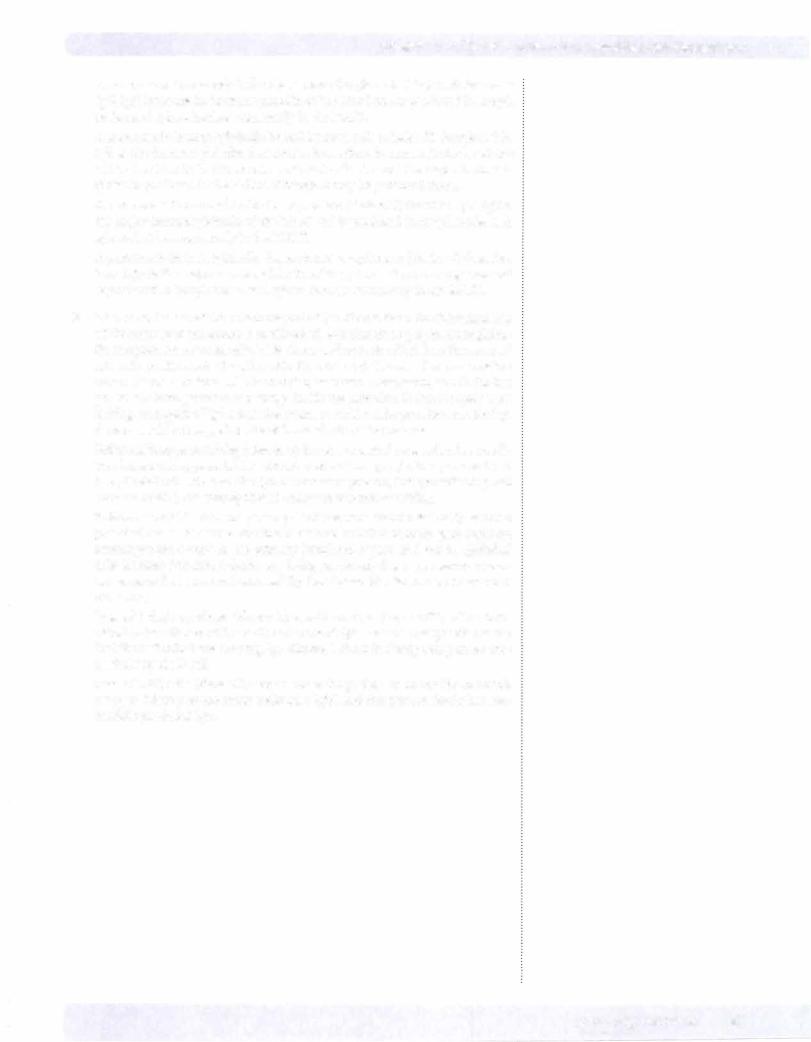
Chapter 7 • The Generation of Humoral Effector Mechanisms
A monomeric immunoglobulin that crosses the placenta (choice B) describes IgG. lgG is the major immunoglobulin ofthe blood and is produced in lymph nodes and spleen, but less commonly in the MALT.
A monomeric immunoglobulin bound by mast cells (choice C) describes IgE. IgE is the immunoglobulin that causes immediate hypersensitivity by virtue of its attraction to the Fe receptors of mast cells. It is not the major immuno globulin produced in the MALT, although it may be produced there.
A monomericimmunoglobulinthat opsonizes (choiceD) describes IgG. IgG is the major immunoglobulin ofthe blood and is produced in lymph nodes and spleen, but less commonly in the MALT.
A pentameric immunoglobulin that activates complement (choice E) describes
IgM. IgM is the major immunoglobulin ofthe primary immune response and is produced in lymph nodes and spleen, but less commonly in the MALT.
8. The correct answer is D. The transport oflgA dimers from the abluminal side ofthe mucosa to the lumen is mediated via attachment to polyimmunoglobu lin receptors on mucosal cells. This allowsendocytosis ofIgA into the mucosal cell and secretion onto the other side. Secretory IgA found in the lumen ofthe bowel retains a residue of this receptor, secretory component, which further protects it from proteolytic cleavage inside the intestine. If this receptor were lacking, transport ofIgA across the mucosa would not be possible, and the IgA dimers would be trapped on the abluminal side ofthe mucosa.
Failure ofisotype switching (choiceA) is not apotential cause ofsuch a condi tion because isotype switching occurs in secondary lymphoid organs and not in epithelial cells. Because the IgA dimers were present, isotype switching had been successful, but transepithelial transport was not occurring.
Failure of variable domain gene segment rearrangement (choice B) is not a potential cause of such a condition because variable domain gene-segment rearrangement occurs in the primary lymphoid organs and not in epithelial cells. Because immunoglobulin was being produced, these gene segment rear rangements had occurred successfully, but transepithelial transport was not occurring.
Loss of J chain synthesis (choice C) would result in the inability of an indi vidual tojoin dimers ofIgA and pentamers ofIgM. Because the question states that the individual was making IgA dimers, J chain is clearly being made suc cessfullyby the B cell.
Loss of TH2 cells (choice E) would cause the patient to be unable to switch isotypes. These persons could make only IgM, and this patient clearly has suc cessfully produced IgA.
MEDICAL 87

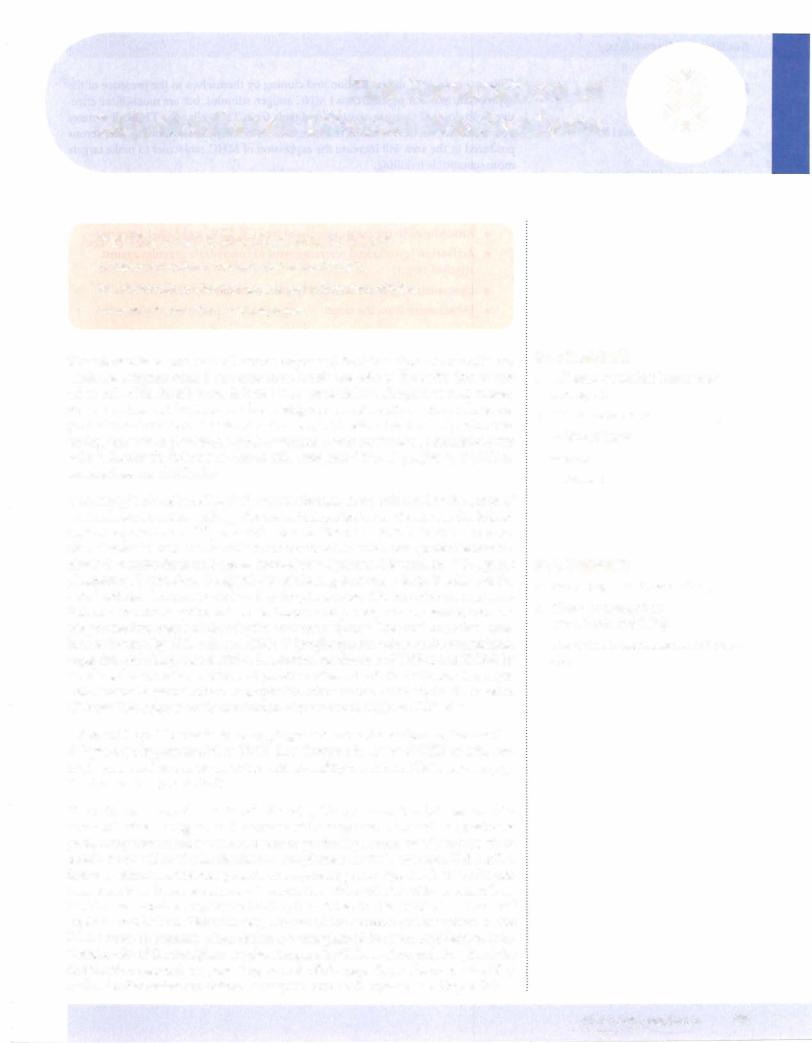
The Generation of |
8 |
Cell-Mediated Effector Mechanisms |
What the USMLE Requires You To Know
•The biologic function ofcell-mediated immunity (CMI)
•The effector cells of CMI, their targets, and mechanisms of killing
•The means ofregulation of CMI responses
The cell-mediated arm of the immune response (CMI) is designed to identify and eradicate antigenic stimuli that arise from inside the cells of the body. This occurs when cells ofthe host become infected with intracellular pathogens, such as viruses, some parasites and bacteria, or when malignant transformation causes cells to ex press aberrantsurfacemolecules. In suchcases, THI cells primed inthe lymph nodes andspleenserveto providethe cytokine stimuli to activatethethree potential effector cells to destroythe infected or altered cells: cytotoxic CDS+ T lymphocytes (CTLs), macrophages, and NK cells.
One example ofa cell-mediated effector mechanism that is enhanced bythe action of THI cells is macrophagekilling. This is acriticalprotective mechanism in the defense against organisms invading macrophages and attempting to live there (mycobacte ria, Leishmania) or in the casewhere phagocytosed microbes have protective mecha nisms that make them resistant to intracellular digestion (Listeria). In CMI against phagocytosed microbes, the specificity of the response arises from T cells, but the actual effector function is mediated by the phagocytes. This provides an important link between the adaptive and innate immune responses, and in essence, converts phagocytes into agents ofthe adaptive immune response. The most important cyto kine elaborated by THI cells and CDS+ T lymphocytes to enhance the microbicidal capabilities ofphagocytes is IFN-y. In addition, production ofTNF-a and TNF-13 by T cells enhances inflammation and provides other stimuli that activate phagocytic cells. Macrophages and other phagocytes kill microbes intracellularly (as discussed in Chapter 6) in contrast to the mechanism observed with CTLs and NK cells.
When THI cytokines activate macrophages and cause tissue damage, the result is delayed-type hypersensitivity (DTH) (see Chapter 13). Assay of DTH by skin test ing is often used as a measure ofthe patient's ability to mount a CMI response (e.g., Mantoux test, Lepromin test).
The CTL recognizes the cell it willultimately kill by interaction between its TCR and MHC class I antigens on the surface ofthe target cell. If the cell in question is performing normal functions and therefore producing normal "self" peptides, there should be no CD8+ T cells that have a complementary TCR structure. Ifthe cell is infectedwith an intracellular parasite or is expressing neoantigens reflective oftumor transformation, however, some small proportion ofthose CD8+ cells generatedfrom the thymus should be capable of binding their TCRs to this MHC class I/non-self peptide combination. Unfortunately, because of the extreme polymorphism of the HLA system in humans, when tissues are transplanted between nonidentical indi viduals, cells ofthe transplantare often targetedby CTLs as abnormal. In spite ofthe fact that theymayonlybe presentingnormal cellularpeptides, in these cases the HLA molecules themselves are different enough to turn on the system (see Chapter I4).
In a Nutshell
•CMI protects against intracellular pathogens.
•THl cells stimulate:
-Macrophages
-CTLs
-NK cells
In a Nutshell
•Macrophages kill intracellularly.
•Killing is enhanced by IFN-y, TNF-a, and TNF- .
•The DTH skin test measures THl func tion.
MEDICAL 89
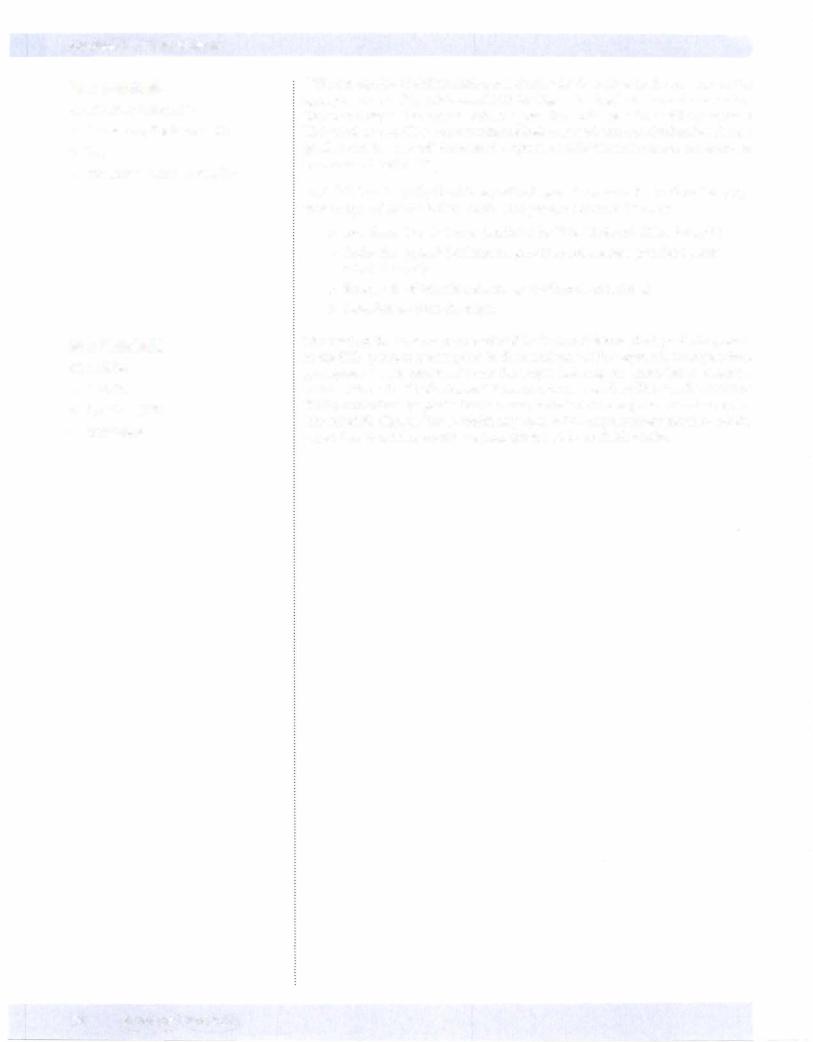
Section I • Immunology
In a Nutshell
CTL stimulation requires:
•Non-self peptide/class I MHC
•IL-2
•IFNs increase MHC expression
In a Nutshell
CTLs kill by:
•Perforins
•Cytokines (TNF)
•Granzymes
CTLs are capable of differentiation and cloning by themselves in the presence ofthe appropriate non-self peptide/class I MHC antigen stimulus, but are much more effec tive in so doing ifthey are assisted by signals from THI cells. The THl cell secretes IL-2which acts on CDS+ cells to enhance their differentiation andcloning. Interferons produced in the area willincrease the expression of MHC molecules to make targets more susceptible to killing.
CTLs killtheir target by the delivery oftoxic granule contents that induce the apop tosis oftJ;e cell to which they attach. This process occurs in 4 phases:
•Attachment to the target (mediated by TCR, CDS, and LFA-1 integrin)
•Activation (cytoskeletal rearrangement to concentrate granules against
attached target)
•Exocytosis of granule contents (perforin and granzymes)
•Detachment from the target
The death ofthe target may be mediated in distinct fashions. First, perforin present in the CTL granules creates pores in the membrane ofthe target cell through which granzymes (serine proteases) enter the target, inducing the activation of caspases, which activate the "death domain''. Second, cytokines such as IFN-ywith TNF-a or TNF-13 can induce apoptosis. Furthermore, activated CTLs express a membrane pro tein called Fas ligand (FasL), which may bind to its complementarystructure on the target, Fas. When this occurs, caspases are induced and death results.
90 MEDICAL
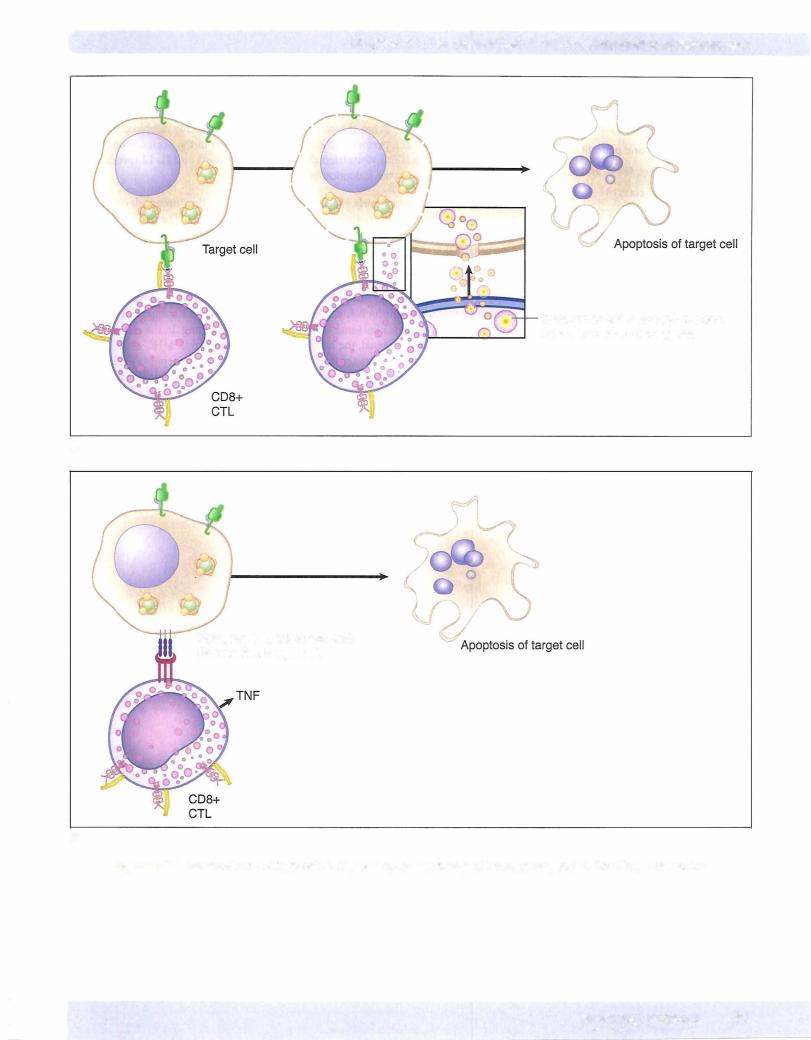
Chapter 8 • The Generation of Cell-Mediated Effector Mechanisms
Granzymes enter through perforin holes, activation of caspases
A
Fasl on CTL interacts with
Fas on the target cell
B
Figure 1-8-1 . Mechanisms of Cytotoxic T-Cell Killing. A: Perforin and Granzymes, and 8: Fas/Fasl Interaction
MEDICAL 91
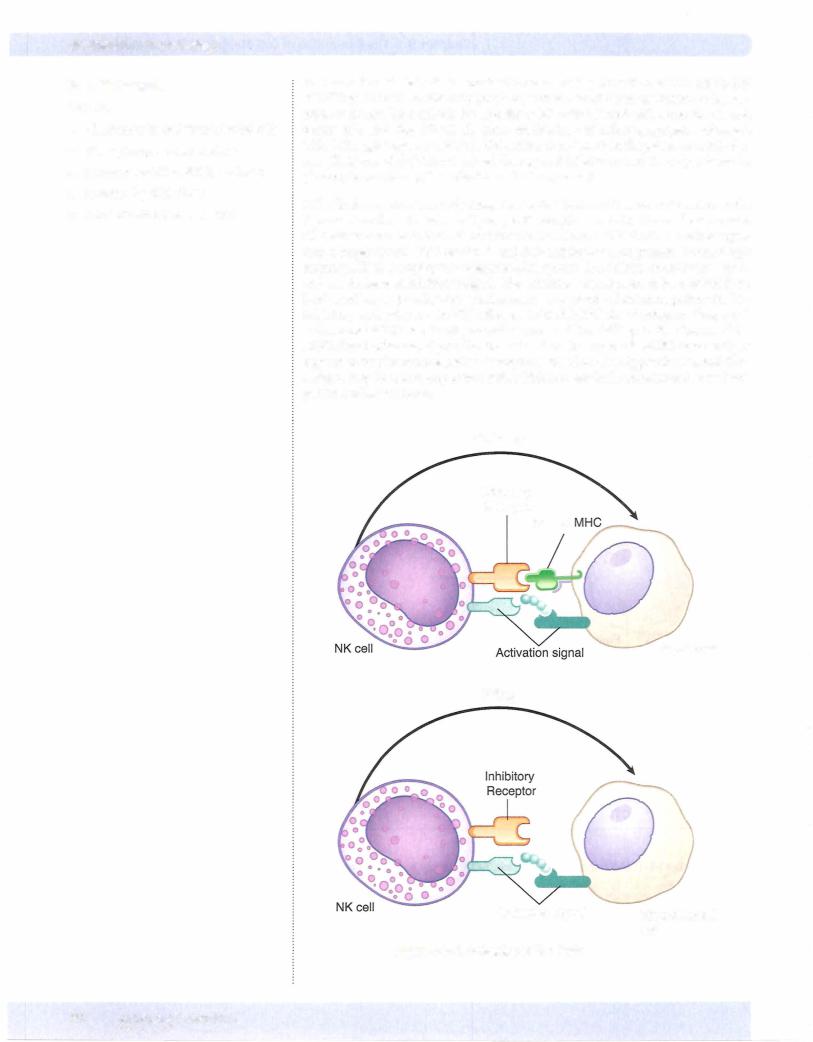
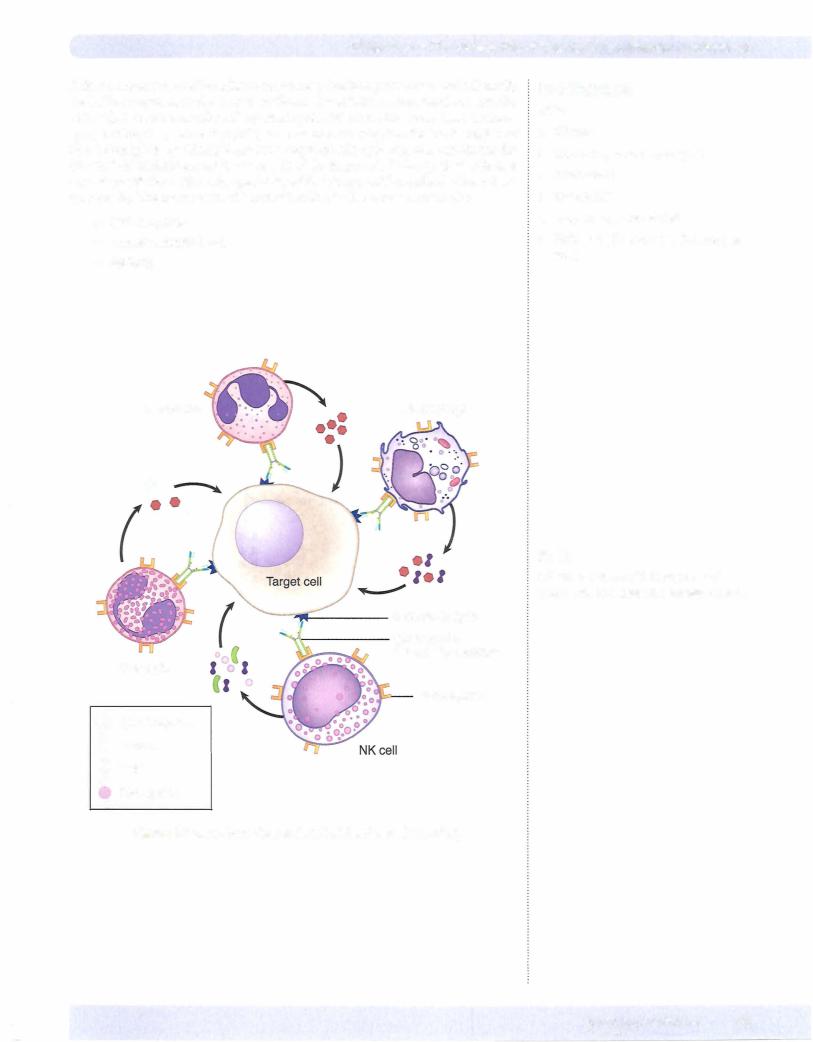
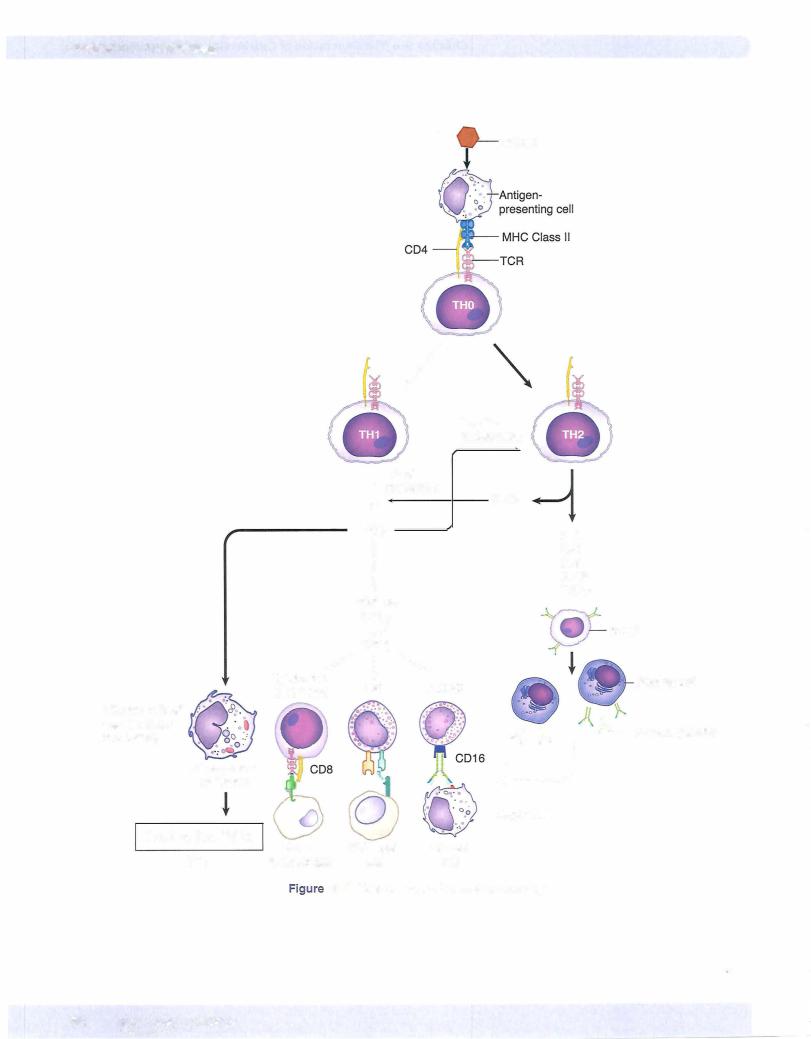
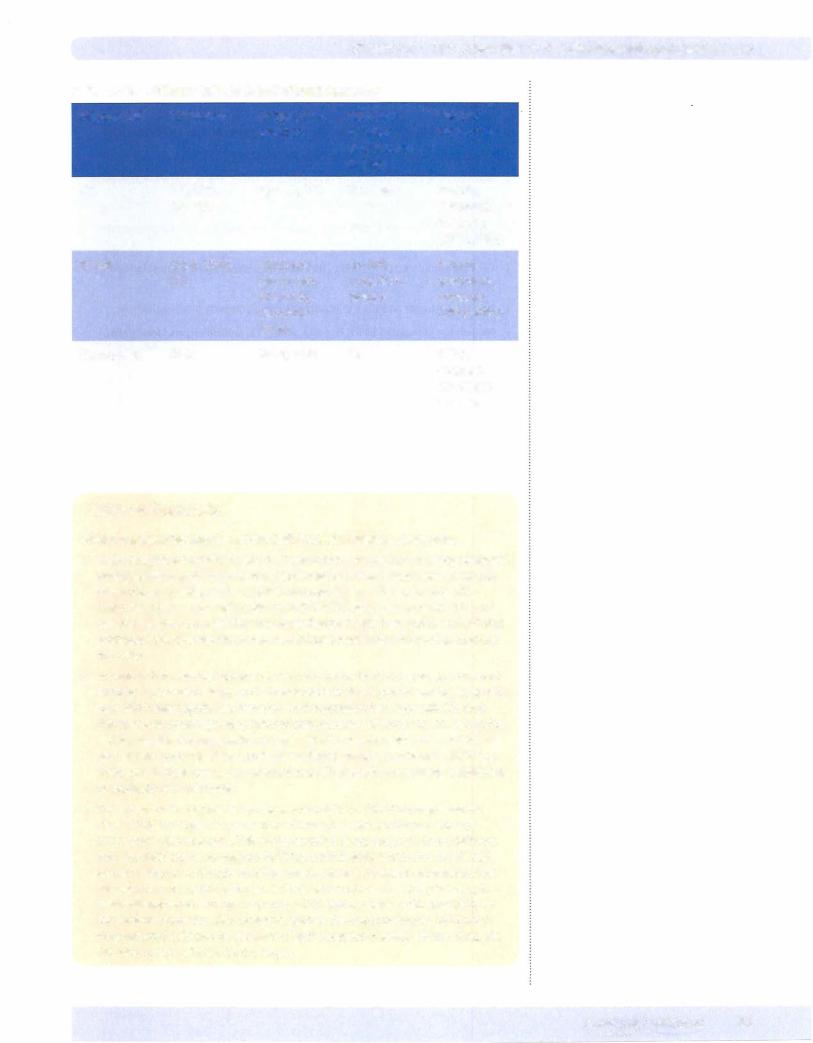
Chapter 8 • The Generation of Cell-Mediated Effector Mechanisms
Table l-8-1. Effector Cells in Cell-Mediated Immunity
Effector Cell |
CD Markers |
Antigen Rec- |
MHC Rec- |
Effector |
|
|
ognition |
ognition |
Molecules |
|
|
|
Required for |
|
|
|
|
Killing |
|
CTL |
TCR, CD3, |
Specific, TCR |
Yes, class I |
Perforin, |
|
CD8, CD2 |
|
|
granzymes, |
|
|
|
|
cytokines |
|
|
|
|
(TNF-13, IFN-y) |
NK cell |
CD16, CD56, |
ADCC: spe- |
No, MHC I |
Perforin, |
|
CD2 |
cific by lgG; |
recognition |
granzymes, |
|
|
otherwise, |
inhibits |
cytokines |
|
|
recognizes |
|
(TNF-13, IFN-y) |
|
|
lectins |
|
|
Macrophage |
CD14 |
Nonspecific |
No |
TNF-a, |
|
|
|
|
enzymes, |
|
|
|
|
NO, oxygen |
|
|
|
|
radicals |
Clinical Correlate
Viral Strategies for Evasion ofthe Cell-Mediated Immune Response
•In the struggle for survival inside the human host, viruses have developed several strategies for evasion of protective cell-mediated immune responses. In viruses that replicate quickly, as do most RNA viruses, CTLs are the major protective response. These viruses will replicate until the TH1 response turns on CTLs and destroys all infected cells. The virus is eradicated in this host, but the rate ofviral replication has ensured that a new nonimmune host is now infected to continue the cycle.
•In viruses that replicate slowly and cannot out-race the CTL response, a different strategy is necessary. Many such viruses block host cell protein synthesis, specifi cally MHC class I synthesis, transport, and expression (see Appendix IV). With this molecule downregulated, infected cells become "immune" to CTL recognition and killing. The downregulation of class I MHC, however, makes most ofthese viruses susceptible to the second cell-mediated immune mechanism, NK killing. Therefore, in most cases, the conjunction ofCTL and NK mechanisms is sufficient to eradicate viral infections.
•The exception to this rule is cytomegalovirus (CMV). CMV downregulates the class I MHC molecule like many otherviruses, but also produces a "decoy" MHC class Hike molecule. This virally encoded decoy molecule is too different from the host's to be recognized by CTLs, but it is sufficient to fool the NK cell, so CMV escapes both of these killing mechanisms. The reason humans are not all overwhelmed by this pathogen is that CMV can be successfully killed by the third cell-mediated immune response, ADCC. lgG molecules with specificity for the surface-expressed CMV antigens, such as the decoy molecule, will bind to virus-infected cells and be recognized by Fe receptor-bearing effector cells, like NK cells, which will then kill the target.
MEDICAL 95
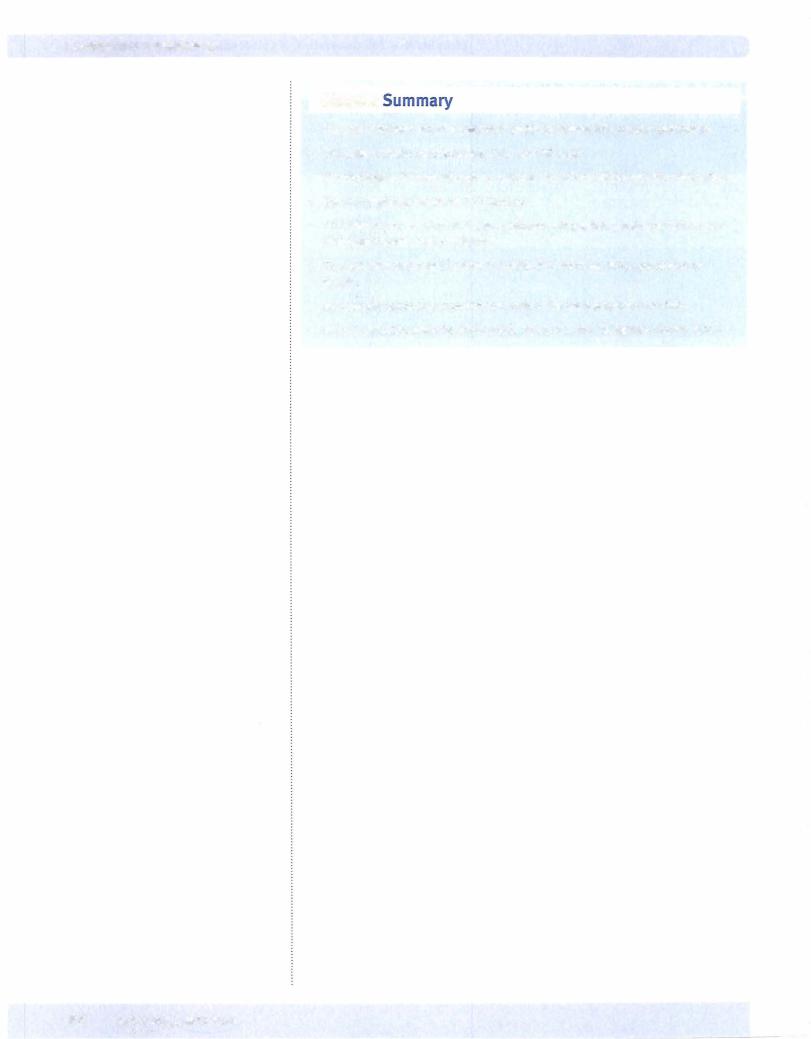
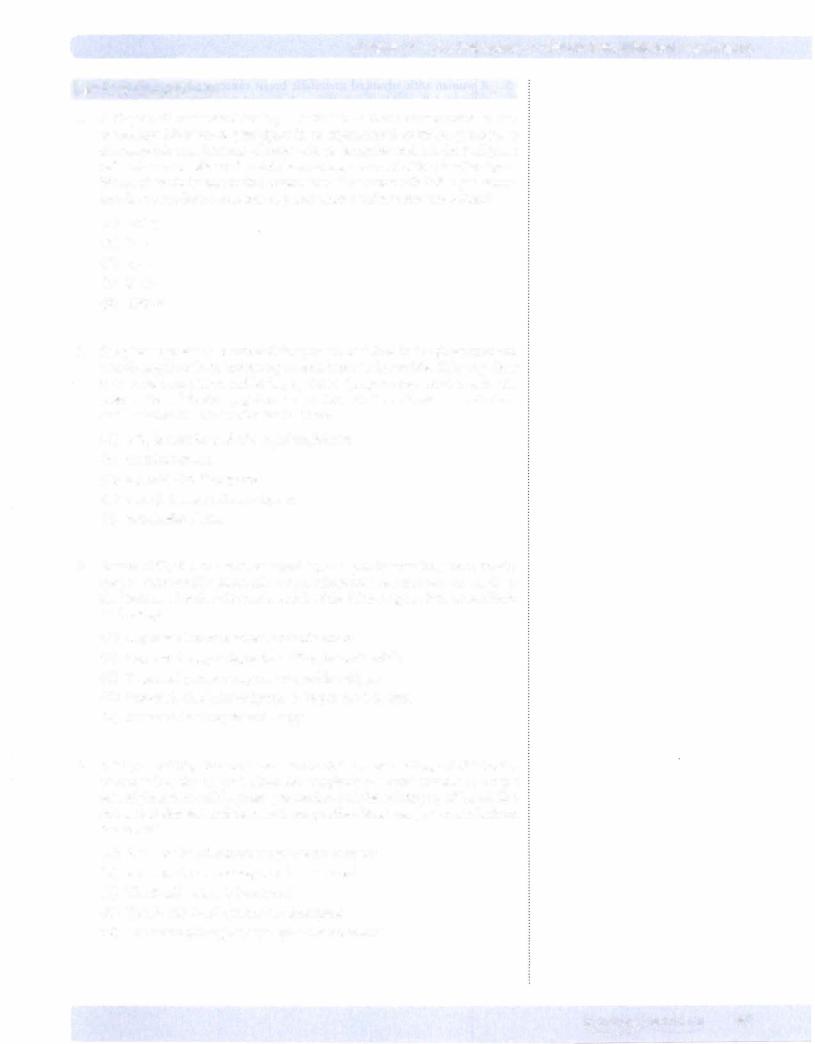
Chapter 8 • The Generation of Cell-Mediated Effector Mechanisms
Review Questions
1 . A 62-year-old accountant develops a solid tumor that is unresponsive to che motherapy. He elects to participate in an experimental treatment protocol to stimulate his own immune effector cells to recognize and killthe malignant cells. The tumor cells are found to have no expression of MHC class I antigens. Which ofthe following in vitro treatments ofhis tumor cells is likely to stimu late the most effective immune response when reinfused into the patient?
(A)IFN-y
(B)IL-2
(C)IL-8
(D)IL10
(E)TNF-
2.Toxoplasma gondii is an intracellular parasite that lives inside phagocytic and nonphagocytic cells by generating its own intracellular vesicle. This may allow it to avoid recognition and killing by CDS+ lymphocytes, which require the presentation of foreign peptides transported into the endoplasmic reticulum and loaded onto MHC molecules that have
(A)a 2 domain instead of a 2 microglobulin
(B)invariant chains
(C)a peptide-binding groove
(D)a single transmembrane domain
(E)two similar chains
3.Before 1960, children with enlarged thymus glands were frequently irradi ated to functionally ablate this organ, whose role was not yet known. Over the lifetime of such individuals, which of the following conditions was likely to develop?
(A)Depressed immune surveillance of tumors
(B)Depressed oxygen-dependent killing by neutrophils
(C) Depressed primary response to soluble antigens
(D)Increased cellularity of lymph node paracortical areas
(E)Increased tendency toward atopy
4.A 42-year-old Nigerian man who is in the United States visiting with his broth er comes into the hospital clinic. He complains of several months of weight loss, night sweats, mild sputum production, and the spitting up of blood. You run a PPD skin test and the results are positive. What can you conclude from this result?
(A)A cell-mediated immune response has occurred
(B)A humoral immune response has occurred
(C) The B-cell system is functional
(D)The B- and T-cell systems are functional
(E)The neutrophilic phagocyte system is functional
MEDICAL 97

Section I • Immunology
5.A woman with advanced metastatic breast cancer undergoes a radical mas tectomy, followed by irradiation and chemotherapy. After a 2-year remission, a metastatic focus appears, and she enrolls in an experimental treatment pro tocol. In it, a sample of her aspirated bone marrow is treated with GM-CSF, TNF-a, and IL-2, then pulsed with membrane fragments of her tumor cells and reinfused. Which of the following cell subpopulations is the most directly targeted by this treatment?
(A)B lymphocytes
(B)Cytotoxic T lymphocytes
(C)NK cells
(D)THI cells
(E)TH2 cells
Answers and Explanations
1.The correct answer is A. The killer cells cytotoxic to targets lacking MHC class I antigens are NK cells. These cells are members of the innate immune response, and as such their response is not enhanced over time. The most spe cific, inducible cytotoxic cells in the body are cytotoxic T lymphocytes (CTLs), which depend on MHC class I recognition oftheir target. Because this question asks how the tumor cells can be altered to make them better stimulators of an immune response, one approach would be to increase their expression of MHC class I molecules. This can be accomplished by treatment of the tumor cells with interferon (IFN)-y. IFN-yincreases expression of both class I and II MHC products on cells.
IL-2 (choice B) is a product of THI lymphocytes and induces proliferation of antigen-primed TH and cytotoxic T cells. It also supports their long-term growth. It would not have an effect on this patient's tumor cells.
IL-8 (choice C) is a product of macrophages and endothelial cells and acts on neutrophils to cause their chemotaxis and extravasation into tissues. It would not have an effect on this patient's tumor cells.
ILI0 (choiceD) is a product ofTH2 cells and acts on macrophages to suppress their cytokine production. It therefore indirectly reduces cytokine produc tion by THI cells and dampens the activation of the cell-mediated arm of the immune response. It would not have an effect on this patient's tumor cells.
TNF- (choice E) is a product of macrophages and NK cells and acts on tumor cells to cause direct cytotoxicity. It acts on inflammatory cells to induce cyto kine secretion and causes the cachexia associated with chronic inflammation. It would not cause the patient's tumor cells to stimulate better immunity.
2.The correct answer is D. CDS+ lymphocytes, or cytotoxic T lymphocytes recognize their target cells by binding to MHC class I molecules containing
altered-self peptides. The class I molecule is a two-chain structure, with one long a chain that passes through the cellular membrane and a shorter chain called 2 microglobulin that becomes associated with the a chain.
A 2 domain instead of a 2 microglobulin (choice A) describes the class II MHC molecule. It is loaded with peptides by the endosomal (exogenous) path way and is recognized by CD4+ T cells.
Invariant chains (choice B) are found blocking the peptide-binding groove of the class II MHC molecule immediately after synthesis. These chains are digested away when the class II MHC is exposed to the contents of the phago cytic vesicles of macrophages, and the groove is loaded with peptides from the ingested particle.
98 MEDICAL
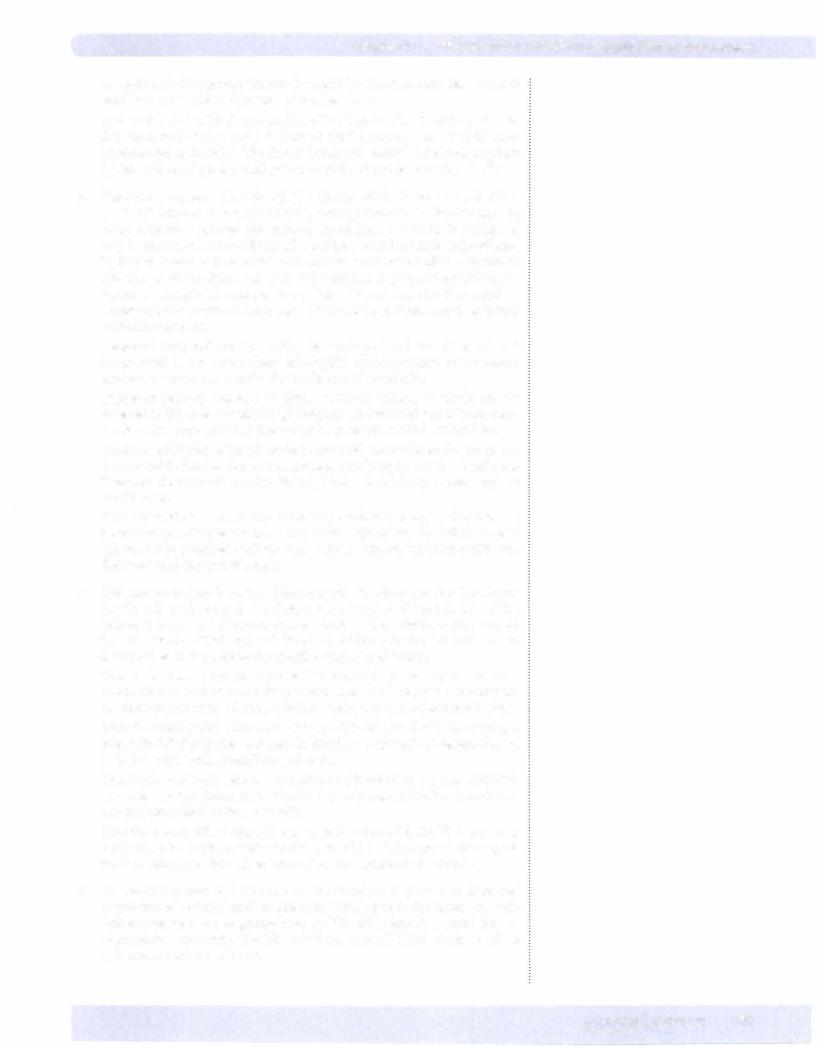
Chapter 8 • The Generation of Cell-Mediated Effector Mechanisms
A peptide-binding groove (choice C) would be found in both class I and II MHC molecules and is therefore notthebest answer.
Two similar chains (choice E) would be found in the class II MHC molecule. It is composed of an ex and a chain of similar lengths, both ofwhich have transmembrane domains. The class II MHC molecule is loaded with peptides by the endosomal (exogenous) pathway and is recognized by CD4+ T cells.
3.The correct answer is A. Although the ablation of the thymus in early child hood will ultimately have far-reaching consequences in the development of many immune responses, the immune surveillance of tumors is performed only by cytotoxic T cells and NK cells, and thus would be profoundly affected by this treatment. Although NK cell numbers would not be affected by loss of the thymus, in the absence of THI cell cytokines, they would not be able to increase in number in response to challenge. Other parameters that could be depressed include immune responses to intracellular pathogens and secondary antibody responses.
Depressed oxygen-dependent killingbyneutrophils (choice B) would not be expected in this case because neutrophils are components of the innate immune response and function in the absence ofT-cell help.
Depressed primary response to soluble antigens (choice C) would not be expected in this case because the IgM response to manyantigensis T-cell inde pendent. It is class switching that would be impossible without T-cell help.
Increased cellularity of lymph node paracortical areas (choice D) would not be expected in this case because the paracortex oflymph nodes is a T-cell area. Therefore, following thymic irradiation, decreased cellularity of these regions would occur.
Increased tendencytoward atopy (choice E) would not be expected in this case
because atopic allergies are those that involve IgE antibodies and mast cells. IgE cannot be produced without T-cell help, so athymic individuals willhave decreased tendency toward atopy.
4.The correct answer is A. The Mantoux test, or tuberculin test (or simply the TB skin test), is the classic clinical demonstration of the function of the delayed-type hypersensitivity response. This is a cell-mediated reaction caused by sensitization ofTH1 cells and demonstrated by the influx and activation of macrophages in response to the cytokines that they elaborate.
That a humoral immune response has occurred (choice B) is not true. Antibodies are not involved in theproductionofa DTH response, andtheyare not importantproducts during infections with most intracellular pathogens.
That the B-cell system is functional (choice C) is not true. B cells do not play a role in the DTH response, and they do not play a major role in defense during infections with most intracellular pathogens.
That the B- and T-cell systems are functional (choice D) is not true. The DTH response certainlydemonstrates thattheTHl response is functional,butitsays nothing about the function of B cells.
That the neutrophilic phagocyte system is functional (choice E) is not true. Neutrophils do notplayaroleintheelicitation oftheDTH response.Neutrophils are the important cells in abscess formation, not granuloma formation.
5.The correct answer is D. The goal of this therapy is to provide an increased population of activated antigen-presenting cells primed with tumor cell anti gens so that these can be presented to the TH cells involved in stimulation of cell-mediated immunity. The THI cell is the first cell listed which would be activatedby such a treatment.
MEDICAL 99

Section I • Immunology
B lymphocytes (choice A) would not be stimulated by such treatment. B lym phocytes bind to and are activated by unprocessed (not cell-bound) antigens.
Cytotoxic T lymphocytes (choice B) would be indirectly stimulated by this treatment. Cytokines secreted by the activated THl cells would have the effect ofincreasing the number and cytotoxicactivity ofkiller cells.
NK cells (choice C) would beindirectlystimulatedbythis treatment. Cytokines secreted bythe activated TH1 cellswouldhavethe effectofincreasing the num ber and cytotoxic activity ofkiller cells.
TH2 cells (choice E) would be stimulated by this treatment, but this is not the major goal of such therapy. TH2 cells stimulate humoral immunity, which is not the most important protective mechanism against tumor cells.
100 M EDICAL
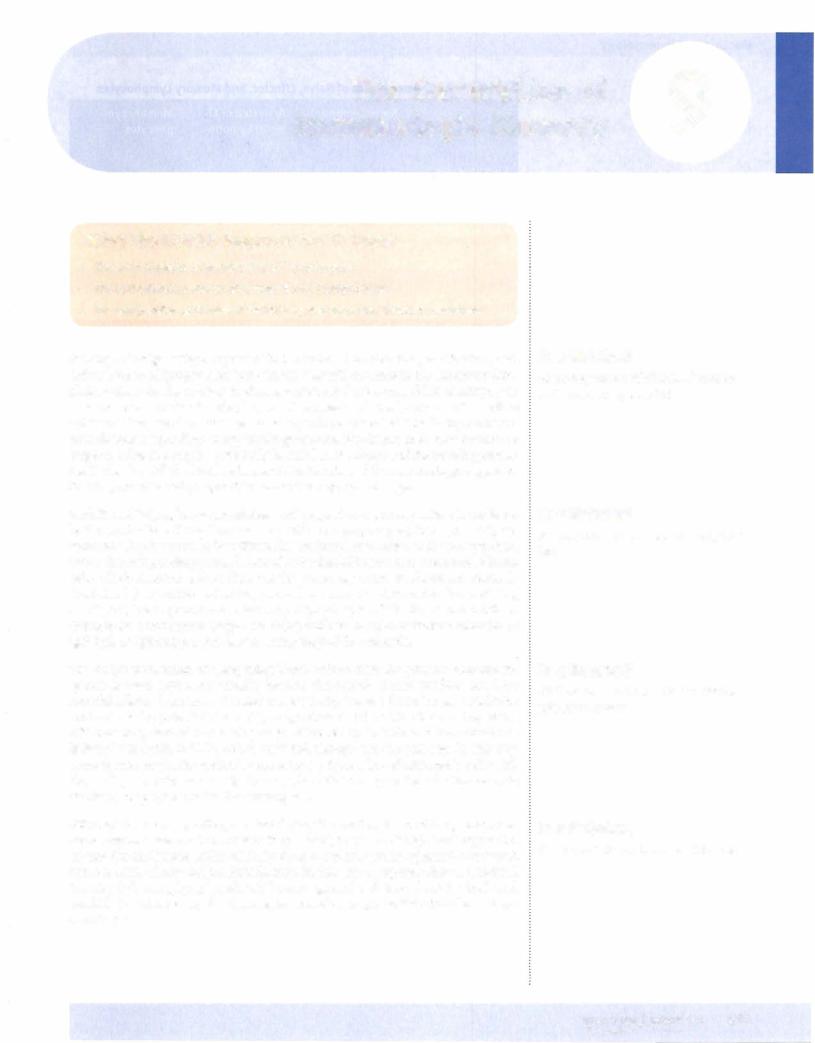
The Generation of |
9 |
Immunologic Memory |
What the USMLE Requires You To Know
•The characteristics of memory B and T lymphocytes
•The recirculation patterns of memory B and T lymphocytes
•The comparative attributes ofthe primary and secondary immune responses
As long as foreign antigen is present in the system, the activation, proliferation, and differentiation oflymphocytes into effector cells willcontinue in the secondary lym phoid organs. As the effector mechanisms generated are successful in destroying or causing clearance ofthe invader, however, the system willslowlyreturnto its baseline quiescent state, and immunologic memory willbe generated. This is important be cause it avoids expending energy on the generation ofcells and molecules that are no longer needed and maybe potentially harmful in the absence ofthe invading stimu lus. It also "resets" the baseline homeostatic function ofthe immunologic organs so thatthey can efficiently respond to new and emerging challenges.
Both B- and T-lymphocyte populations willrespond to a primaryantigenicchallenge by the production oflong-lived memory cells. In B lymphocytes, this is primarily ac complishedbythefactthattheirdifferentiationintoplasmacells is antigen-dependent, and as that antigen disappears, the stimulus forthatdifferentiation is removed. Plasma cells, which function only as factories for immunoglobulin synthesis, are relatively short-lived (two weeks) and as they die and are not replaced from the differentiating B-cell pool, the response wanes. Memory B lymphocytes differ from naive B cells in that they have undergone isotype switching; willbear membrane immunoglobulin of IgG, IgA, or IgE isotype; and enter a resting stage ofthe cell cycle.
The body's mechanism of dampening T-cell activity after the primary immune re sponse is more active, presumably because the cytokines they produce can have harmful effects if they are generated unnecessarily. These cells no longer benefit the host and can be potentially harmful, so apoptosis is induced in all but a few, which willbecome quiescent in a resting stage of the cell cycle. This is called activation induced cell death (AICD) and is mediated through the Fas pathway. In this way, trirnerization of the Fas molecule expressed on the surface of activated T cells with the Fas ligand molecule on neighboring cells initiates a signal-transduction cascade that leads to apoptosis ofthe Fas-bearing cell.
Although the memory cells generated during the waning stages of the primary im mune response are small and relatively quiescent, they exhibit high-level expression ofadhesion molecules, which willhelp them to recirculatethroughout the body and home to areas ofnew antigen introduction. In this way, a response that was initiated in a single draining lymph node will become generalized throughout the body and available to initiate a rapid and powerful secondary response if that challenge is re introduced.
In a Nutshell
As pathogens are eliminated, immuno logic memory is generated.
In a Nutshell
Memory B cells have surface lgG, lgA, or lgE.
In a Nutshell
AICD removes activated T cells after the primary response.
In a Nutshell
Memory cells home to inflamed tissues.
MEDICAL 101
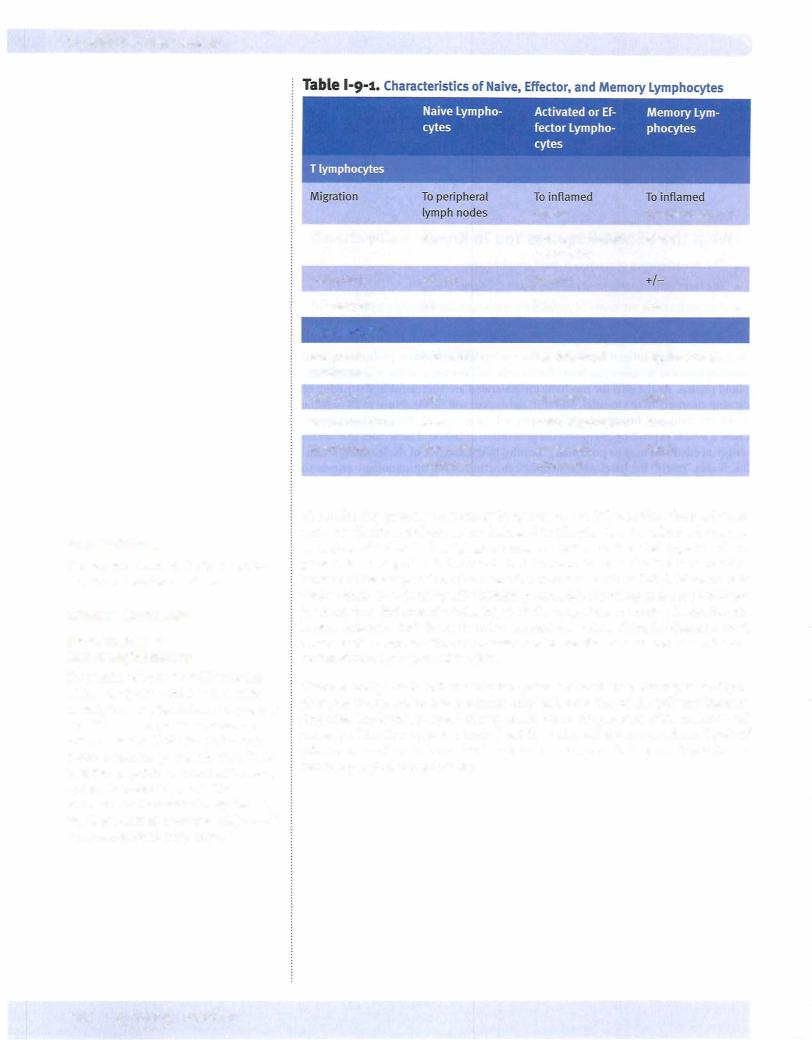
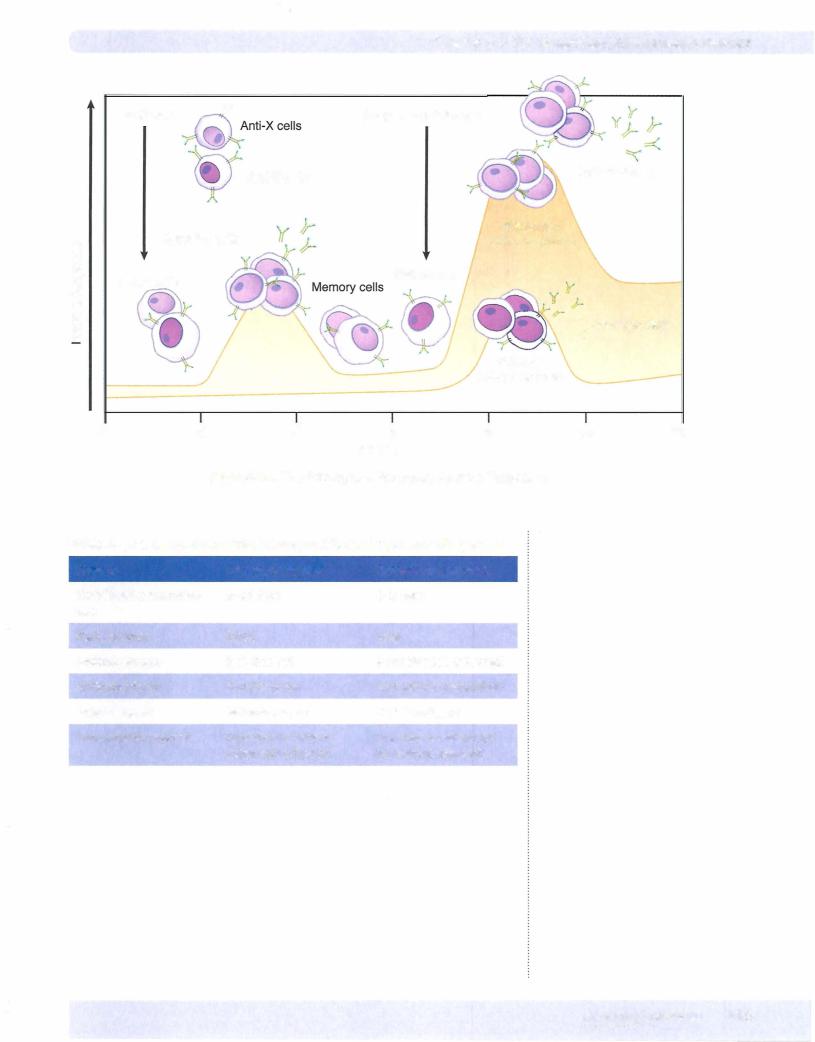
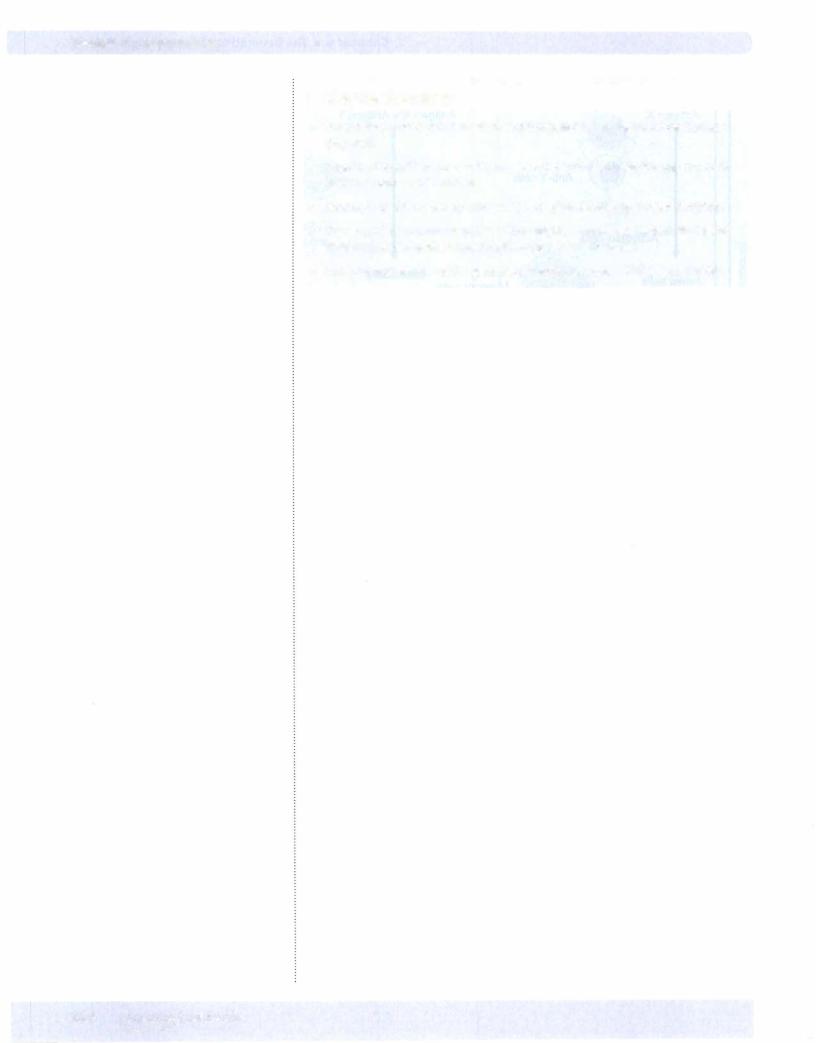
Section I • Immunology
ChapterSummary
•Immunologic memory is generated as pathogens are eliminated by the immune response.
•Long-lived B and T memory cells are generated and recirculate through the body in surveillance for the antigen.
•Memory B lymphocytes express lgG, lgA, or lgE molecules as antigen receptors.
•The secondary immune response is more rapid, is larger, has higher affinity, and requires less antigenic stimulation than the primary response.
•The immunoglobulins ofthe secondary immune response are lgG, lgA, and lgE.
104 MEDICAL
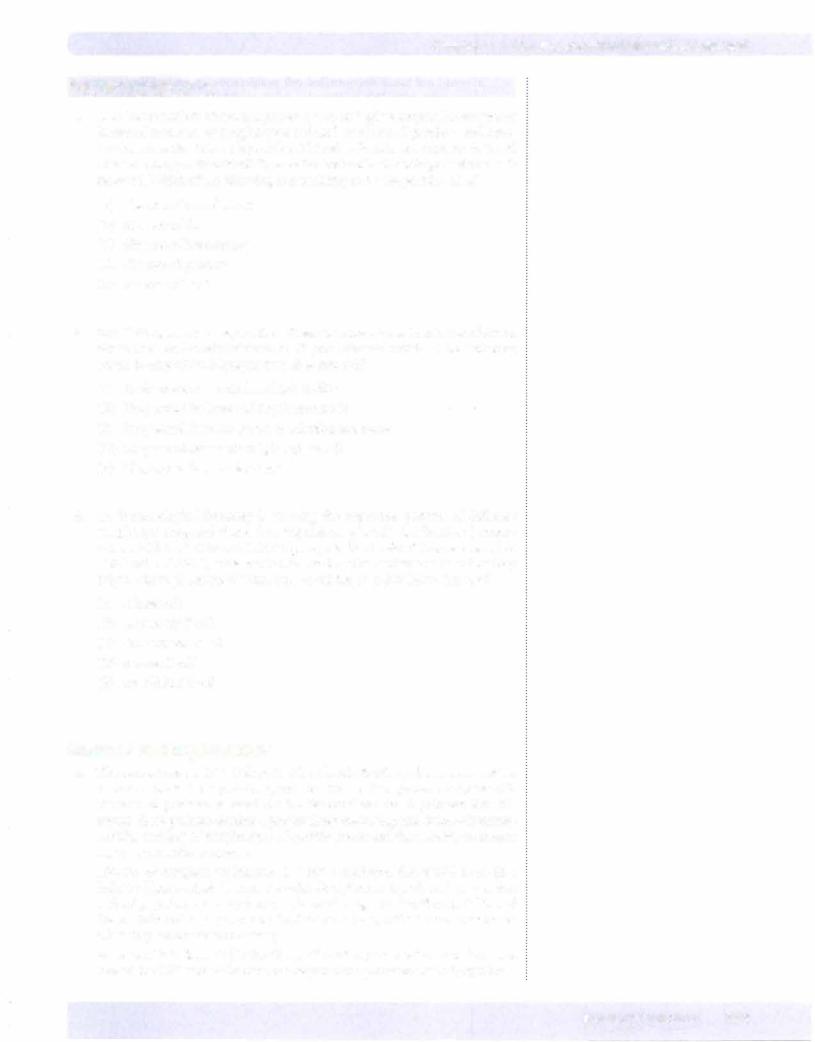
Chapter 9 • The Generation of Immunologic Memory
Review Questions
1. A patient is suffering from lymphadenopathyand splenomegaly. He has greatly increased numbers of lymphocytes, reduced numbers of platelets, and auto immune anemia. When his peripheral blood leukocytes are exposed to T-cell mitogens, theyproliferate wildly, even for weeks after the mitogenic stimulus is removed. Which ofthe following is most likelyto be the genetic defect?
(A)Absence ofcomplement
(B)Absence ofFas
(C)Absence of interferon-y
(D)Absence ofperforin
(E)Absence ofTNF
2.In a lifetime, a person mayreceive a dozen ormore tetanus toxoid inoculations. When boosters are administered at 10-year intervals, which of the following would be true ofthe B lymphocytes that respond?
(A)Their receptors wouldhave high avidity
(B)They would be large and highly metabolic
(C) They would havelow levels ofadhesion molecules
(D)They would have surface IgG, IgA, or IgE
(E)They would have surface IgM
3.An immunologic laboratory is studying the migration patterns of different lymphocyte subpopulations. One population of small, nondividing lympho cytes, which are CD3+ and CD4+ and express low levels ofIL-2 receptors but high levels of LFA-1, are labeled with a radioactive marker and traced as they migrate through the body. What type ofcell has been labeled in this case?
(A)A blast cell
(B)A memory T cell
(C)An activated T cell
(D)A naive T cell
(E)An effector T cell
Answers and Explanations
1.The correct answer is B. This patienthas Canale-Smith syndrome, a condition in which a mutant Fas protein is produced. This mutantprotein competeswith the normal proteins essential for the Fas-mediated death pathway. For this reason, these patients develop a progressively increasing and ultimately unsus tainable number of lymphocytes of specific clones and the inability to mount anynew protective response.
Absence of complement (choice A) is not a condition that would result in a failure of homeostasis in immune cells. Complement is activated by invasion of foreign pathogens or by the complexes of antigen and antibody. Neither of these is believed to play a role in the dampening ofspecific immune responses when they are no longer necessary.
Absence of interferon-y (choice C) would tend to promote immune deviation toward the TH2 arm ofthe immune response and promote antibodysynthesis.
MEDICAL 105
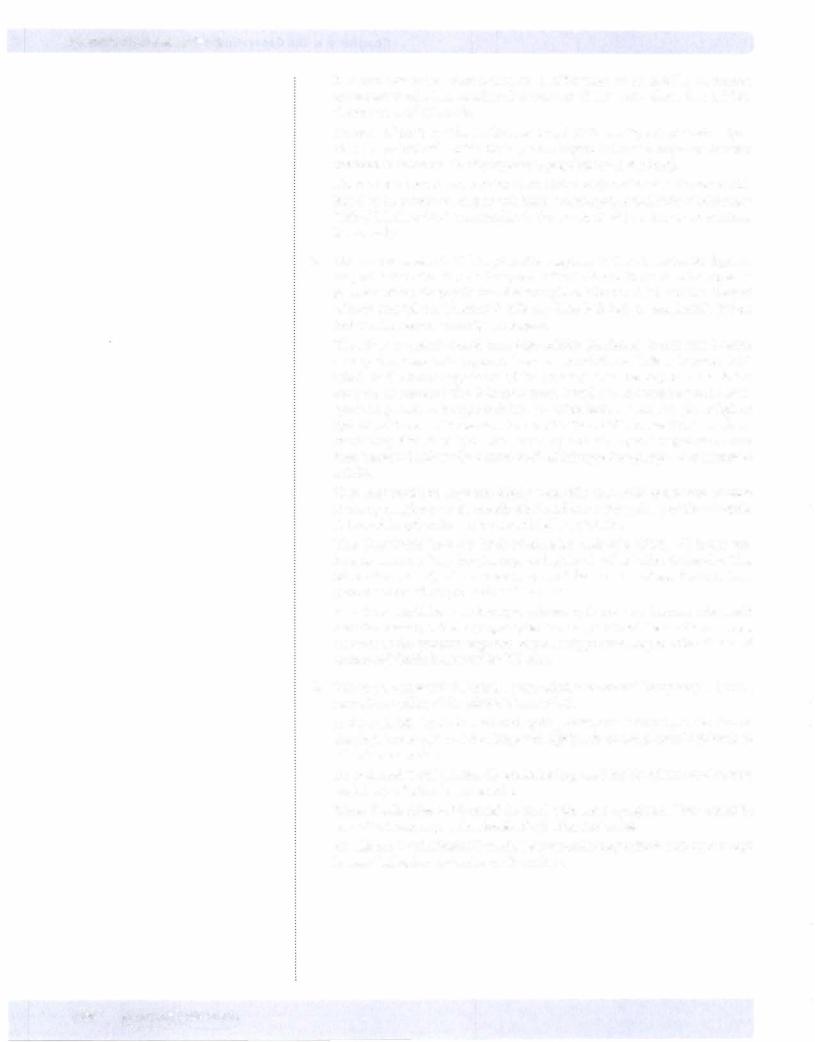
Section I • Immunology
It would not cause uncontrolled cell proliferation or an inability to remove unnecessary cells. This cytokine is a product of THI cells, which then inhibits the function of TH2 cells.
Absence of perforin (choice D) would inhibit the ability of cytotoxic T lym phocytes or NK cells to killtheir specific targets. It is not a major mechanism involved in homeostasis of lymphocyte populations in the body.
Absence of tumor necrosis factor (TNF) (choiceE) would cause decreased kill ing of some tumor cell targets and decreased phagocytosis. Neither TNF-a nor TNFis believed to be involved in the homeostasis of lymphocyte populations in the body.
2.The correct answer is D. The protective response to the tetanus toxoid depends on production of antibodies that prevent the binding of the toxin.After repeated immunizations, the population of memory B cells is stimulated, which is the goal of such prophylaxis. Memory B cells may have IgG, IgA, or occasionally IgE on their surfaces serving as antigen receptors.
That their receptors would have high avidity (choice A) is not true because avidity decreases with repeated booster inoculations. This is because IgM, which is the immunoglobulin of the primary immune response and is the receptor on mature naive B lymphocytes, is replaced in secondary and subse
quent responses by isotype switching to other isotypes such as IgG or IgA or IgE. Allof these molecules have less avidity than IgM because they have fewer combining sites than IgM. The secondary and subsequent responses should have increased affinity (goodness-of-fit of idiotype for epitope), but decreased avidity.
That they would be large and highly metabolic (choice B) is not true because memory lymphocytes are usually small and in a resting phase of the cell cycle. Activated lymphocytes are large and highly metabolic.
That they would have low levels of adhesion molecules (choice C) is not true because memory lymphocytes express high levels of adhesion molecules. This allows them to migrate to areas of active inflammation where they can have maximum benefit in protection of the host.
That they would have surface IgM (choice E) is not true because this would describe mature, naive B lymphocytes that have not met their antigen before. As soon as the primary response begins, isotype switching to other classes of immunoglobulin is directed by TH cells.
3.Thecorrectansweris B. This is a population of memory T lymphocytes (small, nonmitotic cells rich in adhesion molecules).
A blast cell (choiceA) is a cell undergoing blastogenesis (rapid proliferation or cloning). These cells would be large and highly mitotic and possess high levels of adhesion molecules.
An activated T cell (choice C) would be large and highly mitotic and possess high levels of adhesion molecules.
Naive T cells (choice D) would be small with scant cytoplasm. They would be nonmitotic and express low levels of adhesion molecules.
An effector T cell (choiceE) would be large and highly mitotic and express high levels of adhesion molecules on its surface.
106 MEDICAL
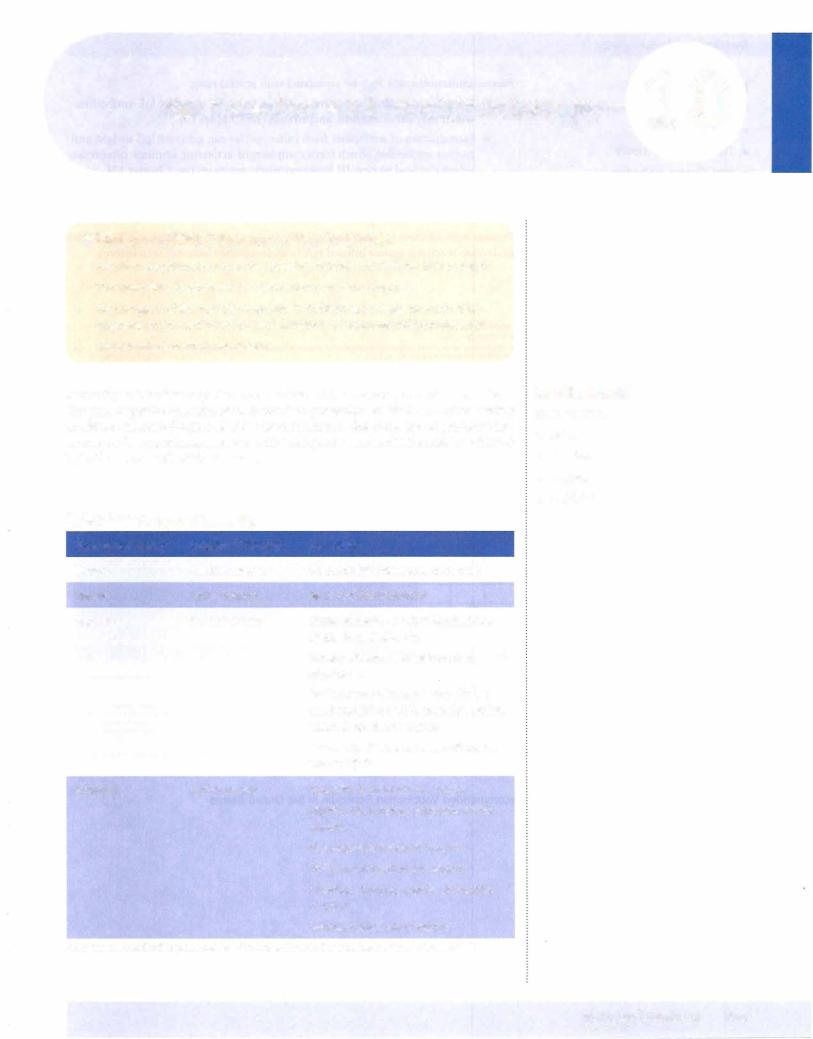
Vaccination and lmmunotherapy 1 0
What the USMLE Requires You To Know
•The clinical applications of active, passive, natural, and artificial immunization
•The immunologic rationales for standard vaccination protocols
•The ontogeny ofthe immune response in children as it relates to vaccination, diagnosis of prenatal infection, and detection of immunodeficiency diseases
•The role of adjuvants in vaccination
Immunityto infectious organisms can beachievedbyactive orpassive immunization. The goal ofpassive immunization is transient protection or alleviation of an existing condition, whereas the goal ofactive immunization is the elicitation ofprotective im munity and immunologic memory. Active and passive immunization can be achieved by both natural and artificial means.
Table l-10-1. Types of Immunity
Type of Immunity |
Acquired Through |
Examples |
Natural |
Passive means |
Placental lgG transport, colostrum |
Natural |
Active means |
Recoveryfrom infection |
Artificial |
Passive means |
Horse antivenin against black widow |
|
|
spider bite, snake bite |
|
|
Horse antitoxin against botulism, |
|
|
diphtheria |
|
|
Pooled human immune globulin ver |
|
|
sus hepatitis A and B, measles, rabies, |
|
|
varicella zoster or tetanus |
|
|
"Humanized" monoclonal antibodies |
|
|
versus RSV* |
Artificial |
Active means |
Hepatitis B component vaccine |
|
|
Diphtheria, tetanus, pertussis toxoid |
|
|
vaccine |
|
|
Haemophi/us capsularvaccine |
|
|
Polio live or inactivated vaccine |
|
|
Measles, mumps, rubella attenuated |
|
|
vaccine |
|
|
Varicella attenuated vaccine |
*Monoclonal antibodies prepared in mice but spliced to the constant regions of human lgG
In a Nutshell
Immunization
•Active
•Passive
•Natural
•Artificial
MEDICAL 107
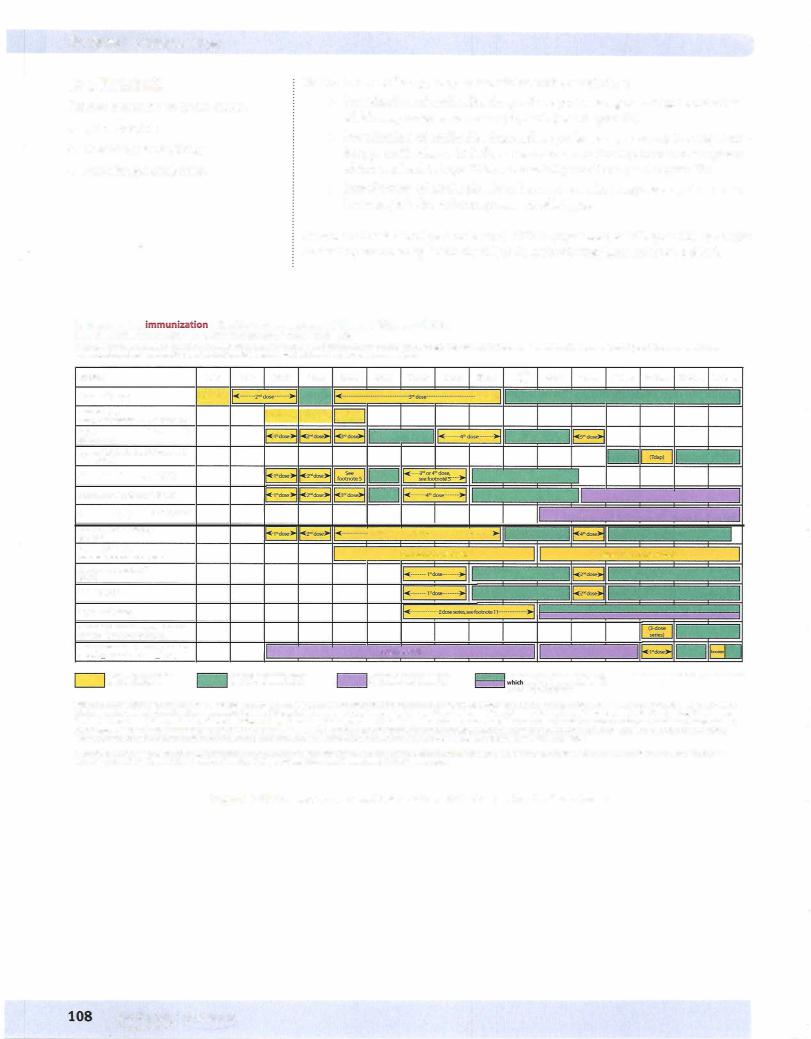
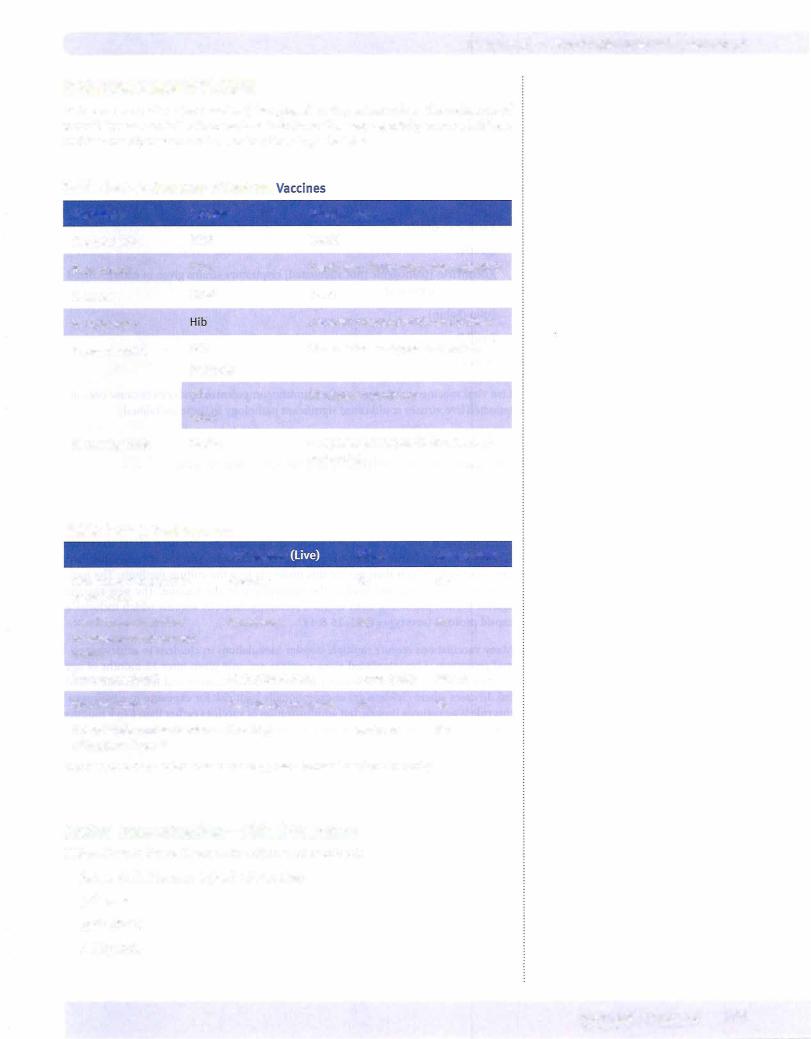
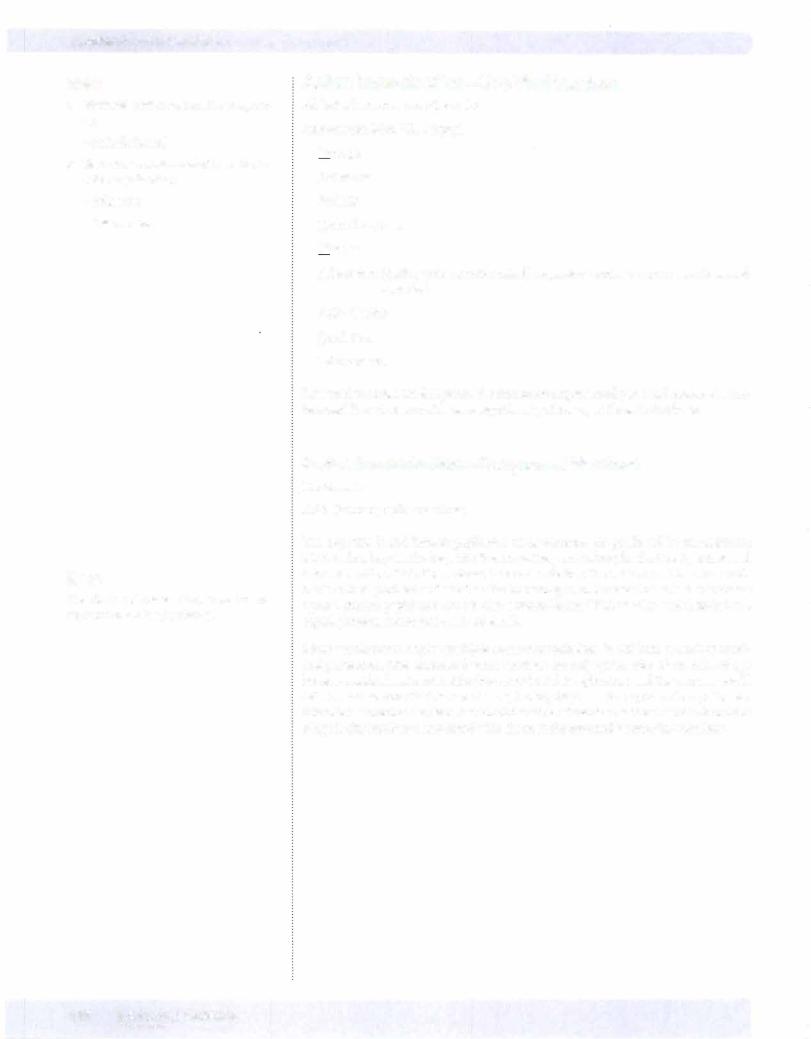
Section I • Immunology
Note
•Vaccines contraindicated in pregnan cy:
-Rubella [MMR]
•Vaccines contraindicated in patients with egg allergies:
-Influenza
-Yellow fever
Note
Live viral vaccines are dangerous for im munocompromised patients.
Active Immunization-Live Viral Vaccines
Allbut adenovirus are attenuated (mnemonic: Mrr. VZ. Mapsy)
Mumps
Rotavirus
Rubella Yaricella - Zoster Measles
Adenovirus (pathogenic [not attenuated] respiratorystrains given inenteric coated capsules)
Eolia (Sabin)
.Small Pox Yellow Fever
Liveviralvaccines are dangerous for immunocompromisedpatients because even at tenuatedlive viruses could causesignificantpathologyin these individuals.
Active Immunization-Component Vaccines
Hepatitis B
HPV (human papillomavirus)
The hepatitis B and human papilloma virus vaccines are produced by recombinant DNA technology. In the hepatitis B vaccine, the gene coding forthe HBsAg is inserted into yeast cells, which then release this molecule into the culture medium. The mol ecule is then purified and used as the immunogen in the vaccine. The new vaccine against human papilloma virus is also a recombinant DNA vaccine which includes 4 capsid proteins (serotypes 6, 11, 16 & 18).
Manyvaccinations require multiple booster inoculations in children to achieve maxi mal protection. Live attenuated virus vaccines are only given after 12 months of age because residual maternal antibodies would inhibit replication and the vaccine would fail. In cases where children are at exceptionally high risk for exposure to a pathogen, this rule is sometimes broken, butadministration ofvaccines earlierthan 6 to 9 months ofage is almostalwaysassociatedwiththe need for repeated booster inoculations.
110 MEDICAL
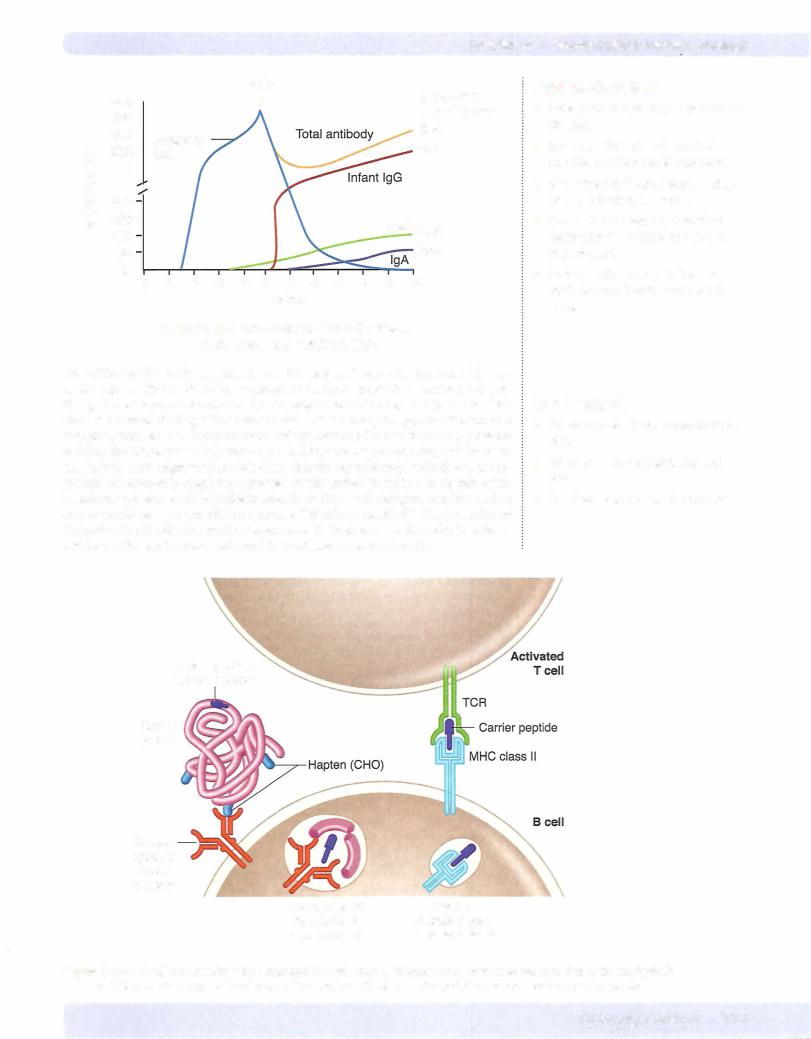
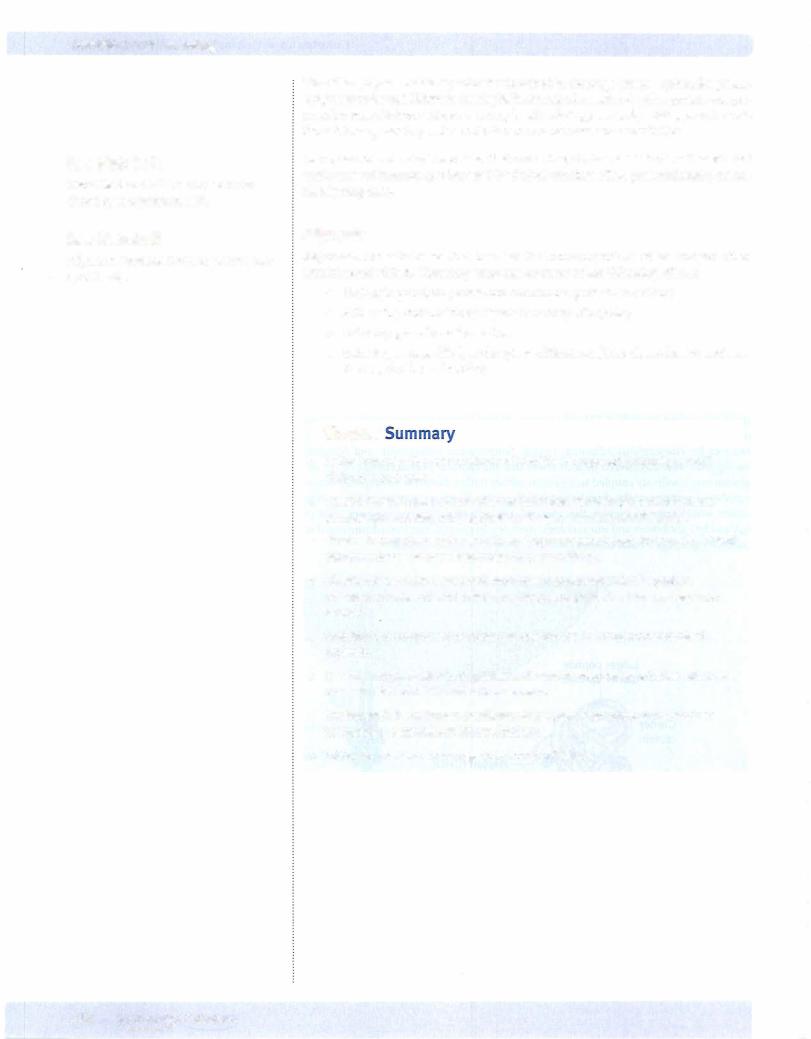

Chapter 10 • Vaccination and lmmunotherapy
Review Questions
1. A 10-year-old child was bitten by a stray dog. The child is started on a course ofanti-rabies post-exposure prophylaxis,beginningwith inoculation ofpooled human antirabies immunoglobulin. What would repeated inoculation of this antirabies immunoglobulin preparation be likely to induce?
(A)Anti-allotype antibodies
(B)Anti-epitope antibodies
(C)Anti-idiotype antibodies
(D)Anti-isotype antibodies
(E)Anti-rabies antibodies
2.All residents ofa Chicago nursing home areinoculated intramuscularlywith an H3N2 influenza A preparation. The goal ofthis protocol is to stimulate which ofthe following types of immunity?
(A)Adaptive
(B)Artificial active
(C)
Artificial passive
(D)Natural active
(E)Natural passive
3.A city sanitation worker is struck by a car and his leg is crushed against his sanitation truck. The extreme trauma to the leg necessitates amputation above the knee. Although the patient's health records reflect a tetanus booster 6 years ago, the man is revaccinated and human, pooled antitetanus immunoglobulin is injected around the macerated tissue. Administration ofimmunoglobulin is an example ofwhich ofthe following forms of immunization?
(A)Adaptive
(B)Artificial active
(C)Artificial passive
(D)Natural active
(E)Natural passive
4.A 28-year-oldmanwas brought into court for nonpayment ofchild support. A 20-year-old woman insists that he is the father ofher child. The court suggests before hearing the paternity casethat various genetic tests be performed on the man, woman, and child. One ofthe sets oftests was for genetic immunoglobu lin identification. Which immunoglobulin markerwouldbe useful in this case?
(A)Allotype
(B)Idiotype
(C)IgA2
(D)IgM
(E)Isotype
MEDICAL 113
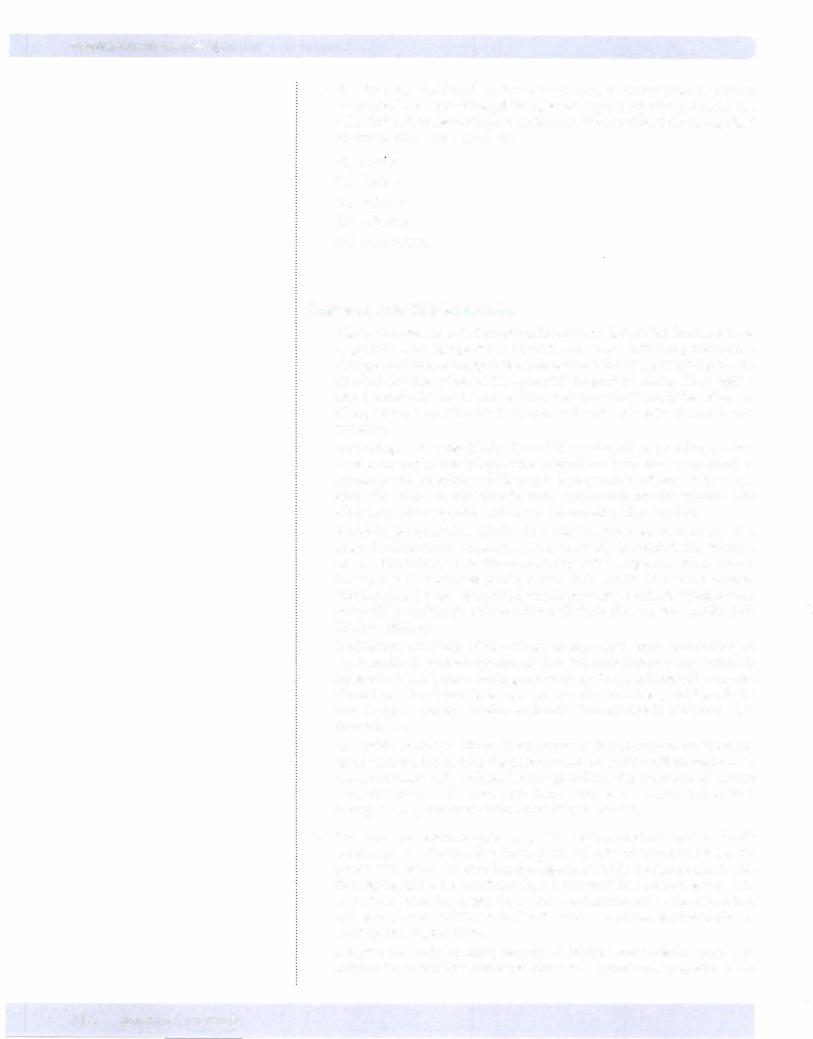
Section I • Immunology
5.In 1988 a new childhood vaccine was developed to protect against epidemic meningitis by mixing Haemophilus influenzae type B capsular polysaccharide with whole, killed Bordetellapertussis bacteria. The function of the whole, killed bacteria in this vaccine was as a(n)
(A)earner
(B)hapten
(A) mitogen
(D)
adjuvant
(E) immunogen
Answers and Explanations
1. The correct answer isA. Because rabies antitoxin is a pooled, human immu noglobulin product, repeated inoculation will cause a patient to produce anti allotype antibodies. Allotypes are minor amino-acid sequence variations in the constant domains of heavy and light irnmunoglobulin chains. Their expres sion is genetically determined, and repeated exposure to molecules of foreign allotype can cause antibodies to be produced which recognize these sequence variations.
Anti-epitope antibodies (choice B) would be produced byrepeated inoculation of an immunogen. The epitope of the antigen has a three-dimensional comple mentaritywith the idiotype of the antibody molecule. In this case, anti-epitope antibodies would be generated by rabies vaccination, but the question asks what the result of repeated exposure to immunoglobulins would be.
Anti-idiotype antibodies (choice C) would be generated in a human if a monoclonal antibody preparation were repeatedly inoculated. The idiotype of an antibody is the three-dimensional shape of its antigen-combining site. It is unique to the antibodies produced by a clone of cells. Because the material mentioned in this case is a pooled human immunoglobulin, it would contain many different idiotypes and would be unlikely to elicit any one specific anti idiotype antibody.
Anti-isotype antibodies (choice D) are usually raised across species barriers. For example, to produce anti-human IgG, IgG pooled from many humans is repeatedly injected into rabbits, goats, or sheep. These animals will recognize the human determinants in the constant domains of the heavy and light chains (the isotypes) and will produce antibodies that specifically recognize those determinants.
Anti-rabies antibodies (choice E) are generated during vaccination. When the killed virus is administered, the patient makes an active, artificial response to the irnmunogen and produces immunoglobulins, which willprotect against virus attachment. In this case, anti-rabies antibodies were inoculated, so there is no possibility that more of the same willbe generated.
2.The correctansweris B. In this case, high-risk individuals are vaccinated with the serotype of influenza virus that is predicted to be most common in this flu season. This elicits an active immunologic response in the patient and is arti ficial by definition because it is being administered in a medical setting. This sort of immunization causes the development of memory in the patient that will protect for the whole season, but it requires approximately two weeks for development of protection.
Adaptive (choiceA) immunity describes all immune responses that have speci ficity and memory. These immune responses are produced by specific B and
114 MEDICAL

Chapter i.o • Vaccination and lmmunotherapy
T lymphocytes. Although adaptive immunity will be elicited in these patients, this is not the best answer because it is imprecise.
Artificial passive (choice C) immunity is achieved when preformed immuno logic products (immune cells or antibodies) are given to a patient. These proce dures provide passive protection that is rapid but lacks immunologic memory. Because it is administered in a medical setting, it is, by definition, artificial.
Natural active (choice D) immunity would result following recovery from an infection.
Natural passive (choice E) immunity is acquired across the placenta and in the colostrum and breast milk, from mother to child. The child receives preformed antibodies (IgG across the placenta and IgA in milk) that protect the child until a natural active immune response can be mounted.
3.The correct answer is C. In this case, an attempt at postexposure prophylaxis against tetanus is made by inoculating antitetanus immunoglobulin into the patient. When preformed immunologic products (immune cells or antibodies) are given to a patient, the procedure provides passive protection that is rapid but lacks immunologic memory. Because it is being administered in a medical setting, it is by definition artificial.
Adaptive (choice A) immunity describes all immune responses that have specificity and memory. These immune responses are produced by specific B and T lymphocytes. Because this patient is being given a product of the adap tive immune response (antibodies), there will be no elicitation of an adaptive immune response in this individual.
Artificial active (choice B) immunity is produced during the process of vacci nation. The patient is exposed to a modified pathogen or product. As a result, an active immune response to that inoculation is made. This sort of immuniza tion causes the development of memory in the patient.
Natural active (choice D) immunity would result after a recovery from an infection.
Natural passive (choice E) immunity is acquired across the placenta and in the colostrum and breast milk, from mother to child. The child receives preformed antibodies (IgG across the placenta and IgA in milk), which serve to protect the child until a natural active immune response can be mounted.
4.The correct answer is A. Allotypes are minor amino-acid sequence variations
in the constant domains of heavy and light immunoglobulin chains. Their
.expression is genetically determined, and variations can be used as evidence in favor of paternity in some cases. Allotypic markers are most frequently used in studies ofpopulationgenetics, as certain ethnic groups are likely to have similar allotypic markers on their immunoglobulins. Allotypic markers do not affect the biologic function of the immunoglobulin molecule.
The term "idiotype" (choice B) describes the 3-dimensional shape of the anti gen-combining site of an antibody or I-cell receptor molecule. Because each human is capable of producing many millions of different idiotypic sequences, these would not be useful in paternity cases.
IgA2 (choice C) is an isotype of immunoglobulin. Because all normal human beings produce some amount of this immunoglobulin, it would not be useful in paternity cases.
IgM (choice D) is an isotype of immunoglobulin. Because all normal human beings produce some amount of this immunoglobulin, it would not be useful in paternity cases.
An isotype (choice E) is found in the heavyor light-chain constant domains of an immunoglobulin. Thus, there are 5 heavy-chain isotypes (A, E, G, M, and
MEDICAL 115
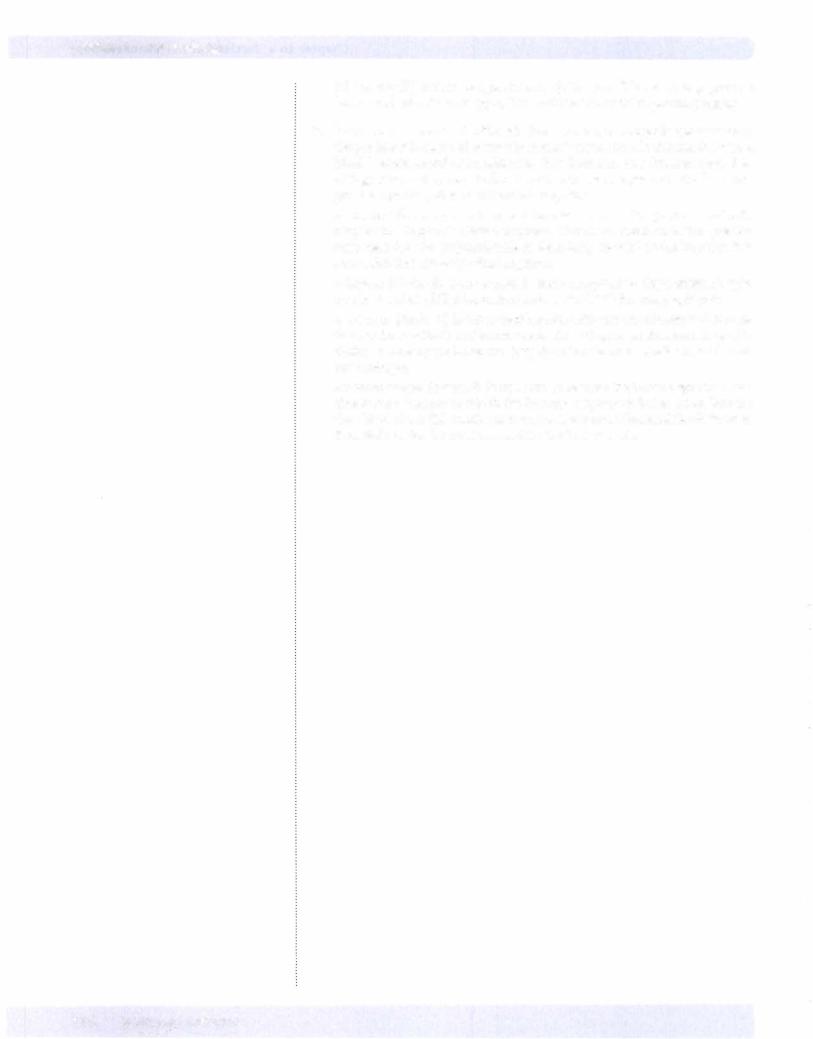
Section I • Immunology
D) and two light-chain isotypes (K and A.). Because allhuman beings produce heavyand light-chain isotypes, this would not be useful in paternity testing.
5.The correct answer is D. Although this vaccine is no longer in use because of the possible side effects ofBordetella pertussis inoculation, in this case the whole, killed bacteria served as an adjuvant. They increased local inflammation, thus calliinflgammatory cells to the site and prolonging exposure to the immuno gen, the capsular polysaccharide of Haemophilus.
A carrier (choice A) is not correct because a carrier is a protein covalently coupled to a hapten to elicit a response. There is no mention in the question stem here that the polysaccharide is chemically coupled to the bacteria; it is stated that they are only mixed together.
A hapten (choice B) is not correct because a hapten is a single antigenic epit ope, and a whole, killed bacterium such as Bordetella has many epitopes.
A mitogen (choice C) is not correct because mitogens are substances that cause the polyclonal activation of immune cells. The mitogens most commonly used in clinical laboratory medicine are lipopolysaccharide, concanavalin A, and poke weed mitogen.
An immunogen (choice E) is not correct because the immunogen in a vac cine is the substance to which the immune response is being made. Because the object of the Hib vaccine is to immunize against Haemophilus influenzae, Bordetella pertussis bacteria cannot be the immunogen.
116 MEDICAL
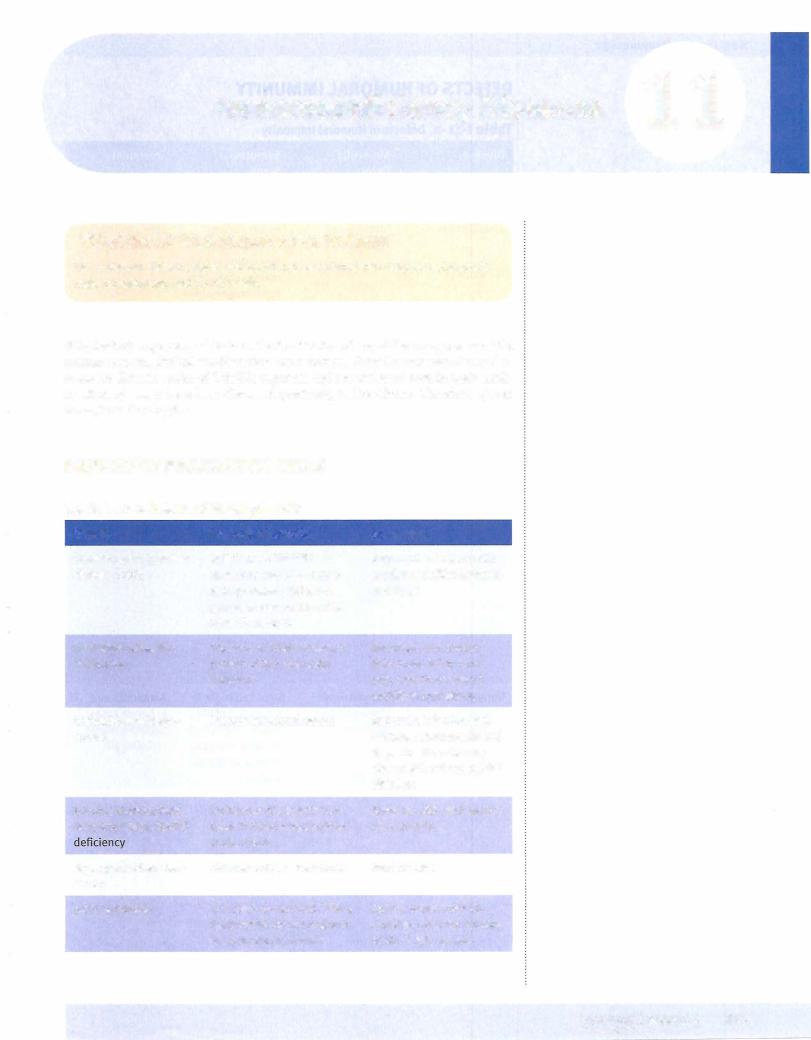
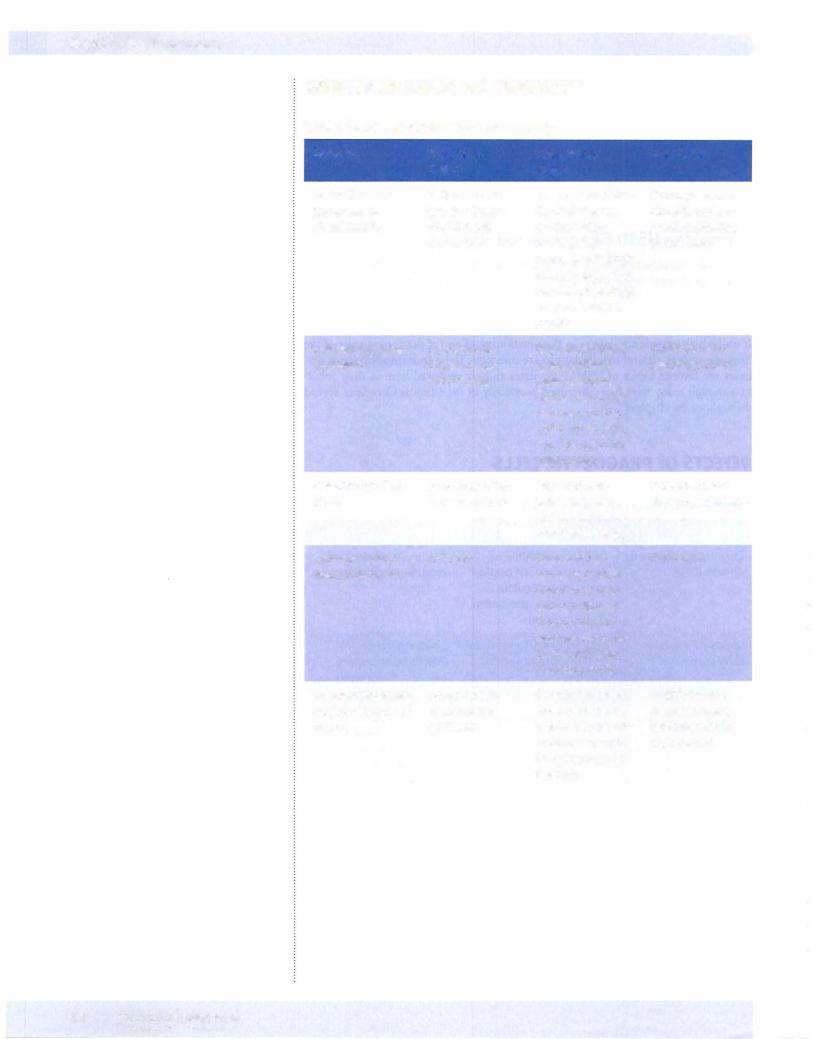
Section I • Immunology
DEFECTS OF HUMORAL IMMUNITY
Table l-11-2. Defects of Humoral Immunity
Disease |
Molecular |
Symptoms/ |
|
Defect |
Signs |
Bruton X-linked |
Deficiency of a |
Low immunoglobu- |
hypogamma- |
tyrosine kinase |
tin of all classes, |
globulinemia |
blocks B-cell |
no circulating |
|
maturation |
B cells, B-cell |
|
|
maturation in bone |
|
|
marrow stopped at |
|
|
pre-B stage normal |
|
|
cell-mediated im- |
|
|
munity |
Treatment
Monthly gamma- globulin replace- ment, antibiotics for infection
X-linked hyper-lgM |
Deficiency of |
High serum titers |
Antibiotics and |
syndrome |
CD40L on acti- |
of lgM without |
gammaglobulins |
|
vated T cells |
other isotypes, |
|
|
|
normal B and T-cell |
|
|
|
numbers, suscep- |
|
|
|
tibility to extracel- |
|
|
|
lular bacteria and |
|
|
|
opportunists |
|
Selective lgA defi- |
Deficiency of lgA |
Repeated sino- |
Antibiotics, not |
ciency |
(most common) |
pulmonary and |
immunoglobulins |
|
|
gastrointestinal |
|
|
|
infections, i atopy |
|
Common variable |
Unknown |
Onsets in late |
Antibiotics |
Immunodeficiency |
|
teens, early twen- |
|
|
|
ties; B cells pres- |
|
|
|
ent in peripheral |
|
|
|
blood, immuno- |
|
|
|
globulin levels de- |
|
|
|
crease with time; |
|
|
|
i autoimmunity |
|
Transient hypogam- |
Delayed onset |
Detected in 5th to |
Antibiotics and |
maglob-ulinemia of |
of normal lgG |
6th month of life, |
in severe cases, |
infancy |
synthesis |
resolves by 16-30 |
gamma-globulin |
|
|
months; suscepti- |
replacement |
|
|
bility to pyogenic |
|
|
|
bacteria |
|
118 MEDICAL
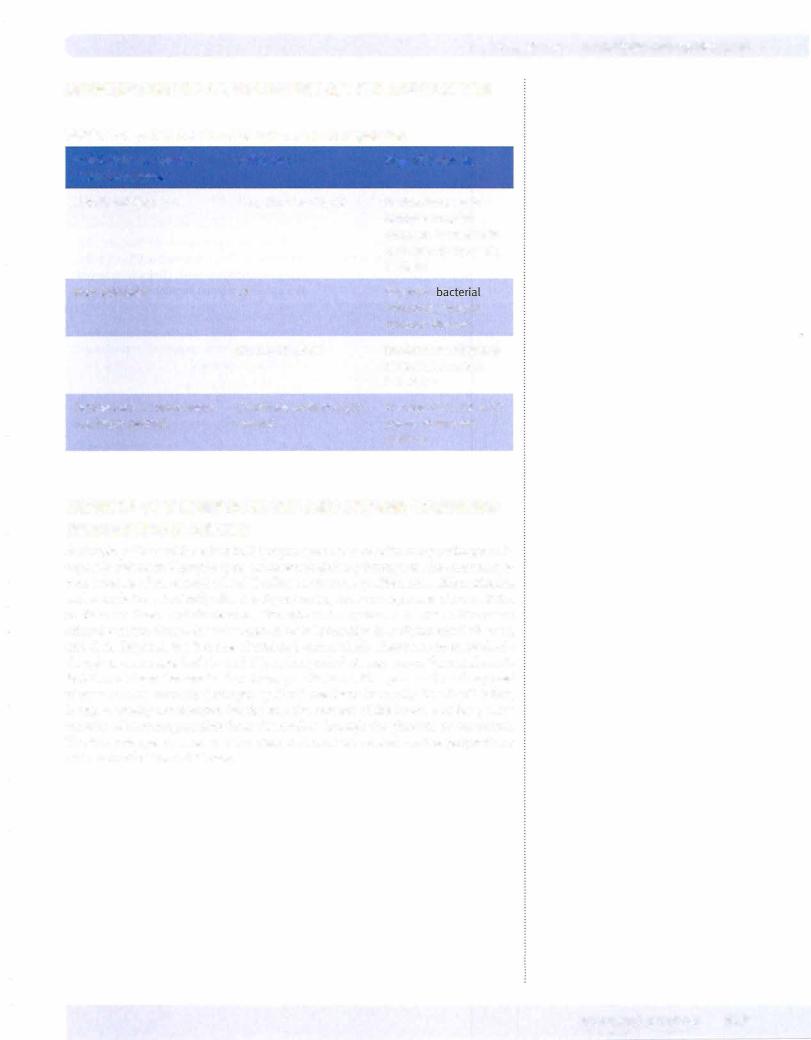
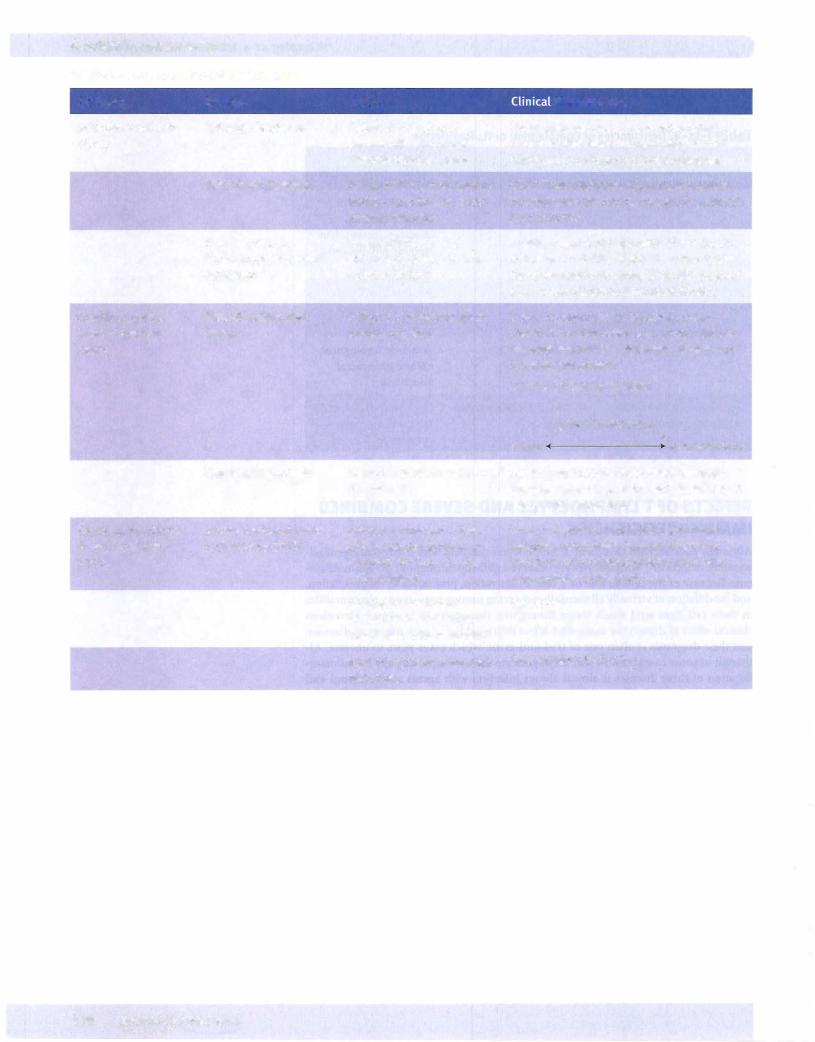
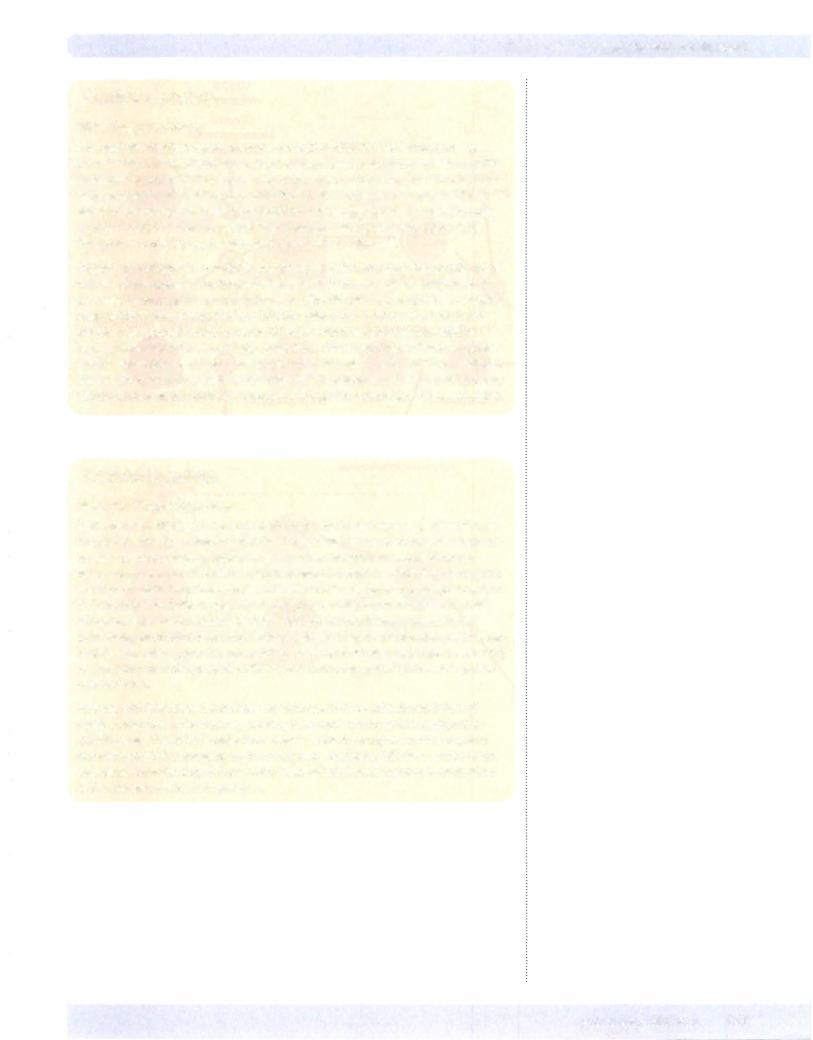
Chapter 11 • Immunodeficiency Diseases
Clinical Correlate
MHC Class I Deficiency
A recessively inherited deficiency in the production of MHC class I molecules has been described in rare individuals. Some ofthese cases result from the failure ofTAP molecules to transport MHC I molecules to the surface ofthe cell, and others are due to the production ofaberrant or nonfunctional MHC I molecules themselves. These patients, as anticipated, suffer from profound deficiencies ofCD8+ T cells, although numbers of CD4+ T cells are normal. This is because MHC class I expression in the thymus is essential to the development of committed CD8+ cells.
Patients are susceptible to multiple, recurrentviral infections, but interestingly, not all viral infections appear to be involved. It may be that they are able to compensate in the case ofsome specificviral infections, by using NK cells to control those infections, whereas otherviruses require killing by CDS+ cells alone. Patients with this defect will possess a normal ability to mount CD4+ cell responses such as delayed-type hypersensitivity (DTH) and antibody production, and indeed their antibody responses may be higherthan usual, presumably because ofthe absence of inhibitory feedback signals (IFN-y) from CD8+ cells directed toward TH2 responses. Thus, they are not very efficient at terminating antibody responses and tend to overproduce them as a result.
Clinical Correlate
Bare Lymphocyte Syndrome
Rare cases of MHC class II molecule deficiency (also known as bare lymphocyte syn drome) inherited in an autosomal-recessive fashion have been observed in humans. Immune problems tend to appear early in infancy and present as a mild form of severe combined immunodeficiency (SCIO) with increased susceptibility to pyogenic and opportunistic infections. However, these defects can be distinguished from true SCIO in that these patients will have T cells that can respond to nonspecific T-cell mitogens, such as phytohemagglutinin, and also to stimuli with allogeneic cells (cells from genetically nonidentical human beings). They do not develop graft-versus host disease when given HLA-mismatched bone marrow transplants (see Chapter 14) because they do not express the MHC class II molecules against which such grafted cells can react.
Patients with MHC class II deficiency are deficient in CD4+ cells due to failure of positive selection in the thymus, and they have moderate to severe hypogamma globulinemia. This defect results from defects in the transcription factors required to coordinate their expression on the cell surface. Because MHC class I antigens are expressed normally, they do have CD8+ cells, although their function is diminished by the absence ofTHl cell cytokines.
MEDICAL 121
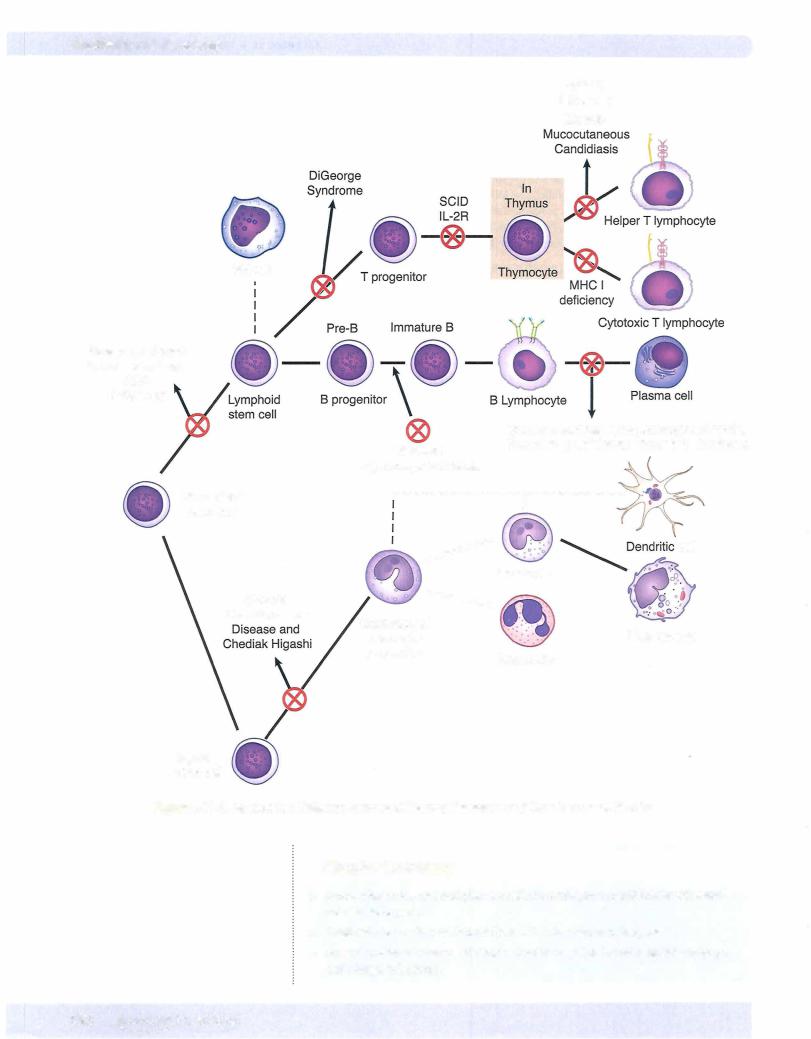
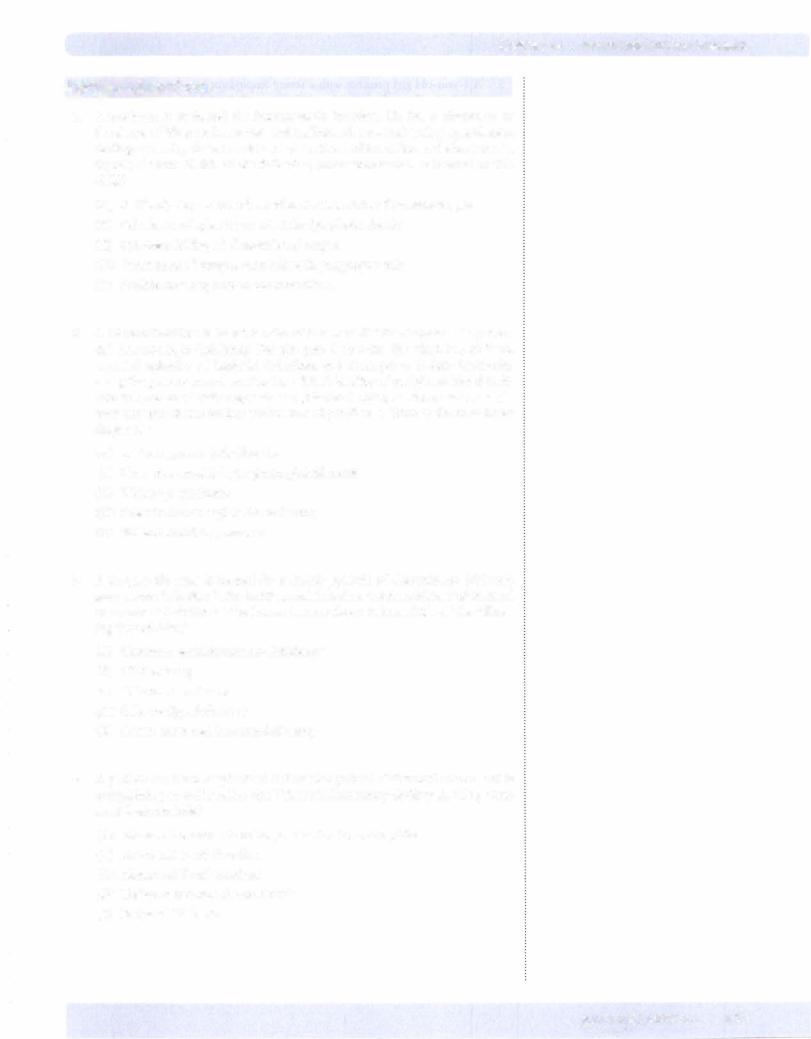
Chapter u • Immunodeficiency Diseases
Review Questions
1.
A newborn is evaluated f o r immunologic function. He has a distortion of the shape of his mouth, low-set and malformed ears, and widely spaced eyes. Radiographically, there is evidence of cardiac malformation and absence of a thymic shadow. Which of the following parameters would be normal in this child?
(A)Antibody-dependent cell-mediated cytotoxicity of parasite targets
(B)Cellularity of splenic periarteriolar lymphoid sheaths
(C) Cytotoxic killing of virus-infected targets
(D)Generation of oxygen metabolites in phagocytic cells
(E)Proliferative response to concanavalin A
2.A 14-month-old male infant is referred to a specialist for diagnosis of a poten tial immunologic deficiency. For the past 4 months, the child has suffered repeated episodes of bacterial infections and attempts to induce immunity using the pneumococcal vaccine have failed. Studies of peripheral blood indi cate an absence of cells responsive to pokeweed mitogen. Bone marrow aspi rates are remarkable for hypercellularity of pre-B cells. What is the most likely diagnosis?
(A)Bruton agammaglobulinemia
(B)Common variable hypogammaglobulinemia
(C)DiGeorge syndrome
(D)Selective immunoglobulin deficiency
(E)Wiskott-Aldrich syndrome
3. A 3 1-year-old man is treated for a fourth episode of disseminated Neisseria gonorrhoeae infection in the last 5 years. He had no previous history of unusual or recurrent infections. If he has an immunologic defect, which of the follow ing is most likely?
(A)Common variable immunodeficiency
(B)CS deficiency
(C)DiGeorge syndrome
(D)Selective IgA deficiency
(E)Severe combined immunodeficiency
4.A patient has been hospitalized 3 times for painful abdominal edema and is complaining now of swollen lips. What will laboratory findings in this patient most likely include?
(A)Abnormal superoxide anion production by neutrophils
(B)Abnormal T-cell function
(C)Abnormal T-cell numbers
(D)Defective neutrophil chemotaxis
(E)Reduced C4 levels
MEDICAL 123
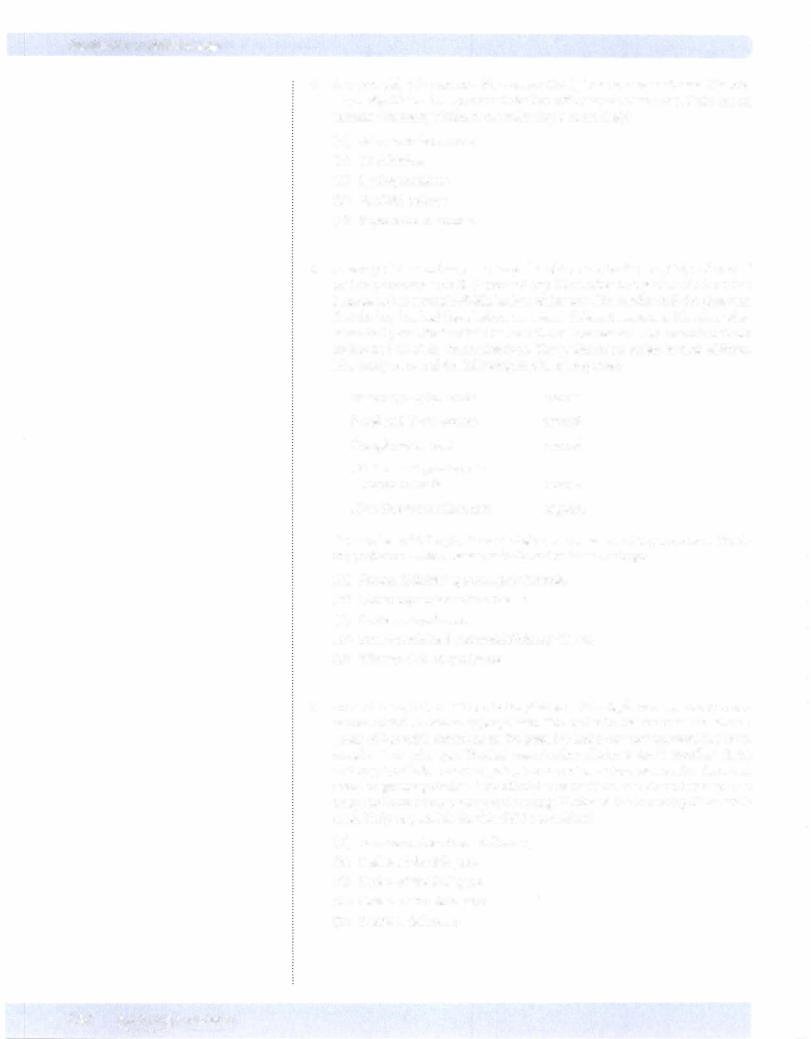
Section I • Immunology
5.A 4-year-old girl presents with a severe Staphylococcus aureus abscess. Her his tory is significant for a previous infection with Serratia marcescens. If she has an enzyme deficiency, which of the following is most likely?
(A)Adenosine deaminase
(B)Cl inhibitor
(C)Myeloperoxidase
(D)NADPH oxidase
(E)Superoxide dismutase
6.A new pediatrician has just opened his office next to the hospital, and one of his first patients is a small,4-year-old boy. His mother brings him into the office because he has several boil-like lesions on his arm. His mother told the physician that the boy has had these lesions on several different occasions. His other phy
sician had prescribed antibiotics, and the lesions resolved. His records indicate he has had allof his immunizations. The pediatrician orders several different laboratory tests, and the following results are reported:
Immunoglobulin levels |
normal |
B-cell and T-cell counts |
normal |
Complement levels |
normal |
Calcium and parathyroid |
|
hormone levels |
normal |
Nitroblue tetrazolium test |
negative |
The mother told the physician that she was not aware of any eczema or bleed ing problems. Which disease is indicated by these findings?
(A)Bruton X-linked agammaglobulinemia
(B)Chronic granulomatous disease
(C)DiGeorge syndrome
(D)Severe combined immunodeficiency disease
(E)Wiskott-Aldrich syndrome
7.An acutely ill,2-year-old boy is hospitalized with Staphylococcus aureus pneu monia, which is treated appropriately. The patient's history indicates similar bouts of bacterial infections in the past. He had recovered uneventfully from measles 6 months ago. Physical examination discloses scant tonsillar tissue and no palpable lymphadenopathy. Immunoelectrophoresis reveals subnormal levels of gammaglobulins. The nitroblue tetrazolium and chemiluminescence assays indicate normal phagocytic killing. Which of the following disorders is most likely responsible for this child's condition?
(A)Adenosine deaminase deficiency
(B)Defect of the Btk gene
(C) Defect of the SAP gene
(D)Defect of the WAS gene
(E)ICAM-1 deficiency
124 MEDICAL

Chapter u • Immunodeficiency Diseases
8.A 2-year-old boy suffering from repeated painful bouts of inflammation of mucosal surfaces, especially affecting the lips, is brought to the pediatrician's office. The mother remembers similar symptoms in previous generations of her family and fears a heritable tendency toward food allergy. What laboratory finding would best support the physician's suspicion?
(A)Depressed C3
(B)Depressed C4
(C)Depressed CS
(D)Elevated Cl
(E)Elevated Cl, C4, and C2
9.A 10-month-old infant girlis admittedto the hospital with signs ofPneumocystis jirovecii pneumonia. Studies of her peripheral blood demonstrate age-normal counts of CD19+ cells, but CD3+ and CD4+ cell numbers are depressed. Immunoelectrophoresis of her serum reveals a moderate hypogammaglobu linemia. Her peripheral blood lymphocytes proliferate normally in response to phytohemagglutinin and MHC class I mismatched allogeneic cells. In a one way mixed lymphocyte reaction using her cells as the stimulator cells, alloge neic T lymphocytes did not proliferate. Which of the following best describes the molecule most likely lacking from her lymphocytes?
(A)It is designed to bind endogenously produced peptides
(B)It is designed to bind exogenously processed peptides
(C)It possesses 2 microglobulin
(D)It possesses two chains of unequal length
(E)It should be present on all nucleated cells in the body
Answers and Explanations
1.The correct answer is D. This is a case of DiGeorge syndrome, which is a con genital failure in the formation of the third and fourth pharyngeal pouches. As a result, individuals with this defect have aplastic thymus and parathyroids and facial, esophageal, and cardiac malformations. Immunologically, the absence
of the thymus will ultimately have global effects on the development of all T-cell-mediated immune responses. At birth, the child willhave IgG antibodies
that have been transplacentally transferred from the mother, but by 9 months or so after birth, these willbe gone and lgM willbe the only isotype of irnrnu noglobulin present. Phagocytic killingwillbe normal until that point, although after all the maternal IgG is gone, opsonization of bacteria willno longer be possible.
Antibody-dependent cell-mediated cytotoxicity of parasite targets (choice A) will be depressed in this child because eosinophil-mediated ADCC requires IgE antibodies, and these cannot be produced without T-cell help.
Cellularity of splenic periarteriolar lymphoid sheaths (choice B) willbe
decreased in this child because these are T-cell-dependent areas of the spleen.
Cytotoxic killingofvirus-infected targets (choice C) willbe depressed in this child because cytotoxic T cells willbe absent, and only NK cells willbe available for antiviral protection.
The proliferative response to concanavalin A (choice E) willbe depressed in this child because concanavalin A is a T-cell mitogen. If there are no T cells, there will be no proliferation in response to this mitogen.
MEDICAL 125
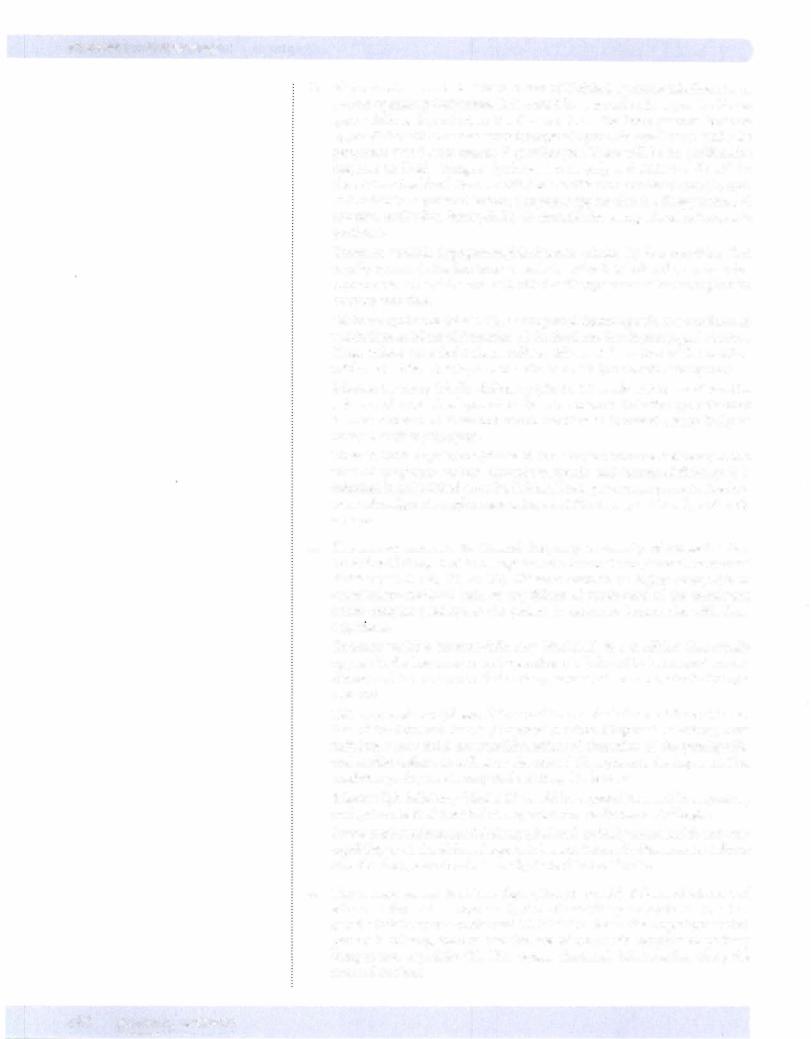
Section I • Immunology
2.The correct answer is A. This is a case of X-linked agammaglobulinemia, or Bruton agammaglobulinemia. It is caused by a mutation in a tyrosine kinase gene, which is important in B-cell maturation. The bone marrow becomes hypercellular with cells that cannot progress beyond the pre-B stage, while the peripheral blood lacks mature B lymphocytes. There will be no proliferative response to B-cell mitogens (pokeweed mitogen), and CD19+ cells will be absent from the blood. Persons with this condition are unable to mount a nor mal antibody response; therefore, symptoms appear after the disappearance of maternal antibodies. Susceptibility to extracellular, encapsulated pathogens is profound.
Common variable hypogammaglobulinemia (choice B) is a condition that usually appears in the late teens or early twenties. It is believed to be an auto immune disease and is associated with the disappearance of immunoglobulin isotypes over time.
DiGeorge syndrome (choice C), or congenital thymic aplasia, is a condition in which there is failure offormation ofthe third and fourth pharyngeal pouches. These infants have facial abnormalities, failure of formation of the parathy roids, and cardiac defects, as well as absence ofT-lymphocyte development.
Selective immunoglobulin deficiency (choice D) would not be manifested by a failure of B-cell development in the bone marrow. Selective IgA deficiency is most common of these and would manifest as increased susceptibility to mucosal-surface pathogens.
Wiskott-Aldrich syndrome (choice E) is a complex immune deficiency with a triad of symptoms: eczema, thrombocytopenia, and immunodeficiency. It is inherited in an X-linked recessive fashion. These patients are prone to develop ment ofmalignant lymphomas and have inability to respond to polysaccharide antigens.
3.The correct answer is B. Unusual frequency or severity of Neisseria infec tions should always lead to a suspicion of a terminal complement component deficiency (CS, C6, C7, or CS). Neisseria seem to be highly susceptible to complement-mediated lysis, so any failure of production of the membrane attack complex predisposes the patient to recurrent bacteremias with these orgamsms.
Common variable immunodeficiency (choice A) is a condition that usually appears in the late teens or early twenties. It is believed to be an autoimmune disease and is associated with the disappearance of immunoglobulin isotypes over time.
DiGeorge syndrome (choice C) is a condition in which there is failure offorma tion of the third and fourth pharyngeal pouches. Diagnosed in infancy, these individuals have facial abnormalities, failure of formation of the parathyroids, and cardiac defects, as well as an absence of T-lymphocyte development. This condition predisposes to early viral and fungal infections.
Selective IgA deficiency (choice D) would be expected to result in respiratory and gastrointestinal tract infections, autoimmune disease, and allergies. Severe combinedimmunodeficiency (choiceE) typicallypresentswith earlysus ceptibility to viral and fungal agents. It is most frequently diagnosed in infancy, after the disappearance of maternally derived IgG antibodies.
4.The correct answer is E. The description of painful abdominal edema and edema in the oral mucosa are typical of hereditary angioedema. This is a genetic deficiency of complement Cl inhibitor. When this important control protein is missing, there is excessive use of the classic complement pathway components, especially C4. This causes abnormal inflammation along the mucosal surfaces.
1 26 MEDICAL
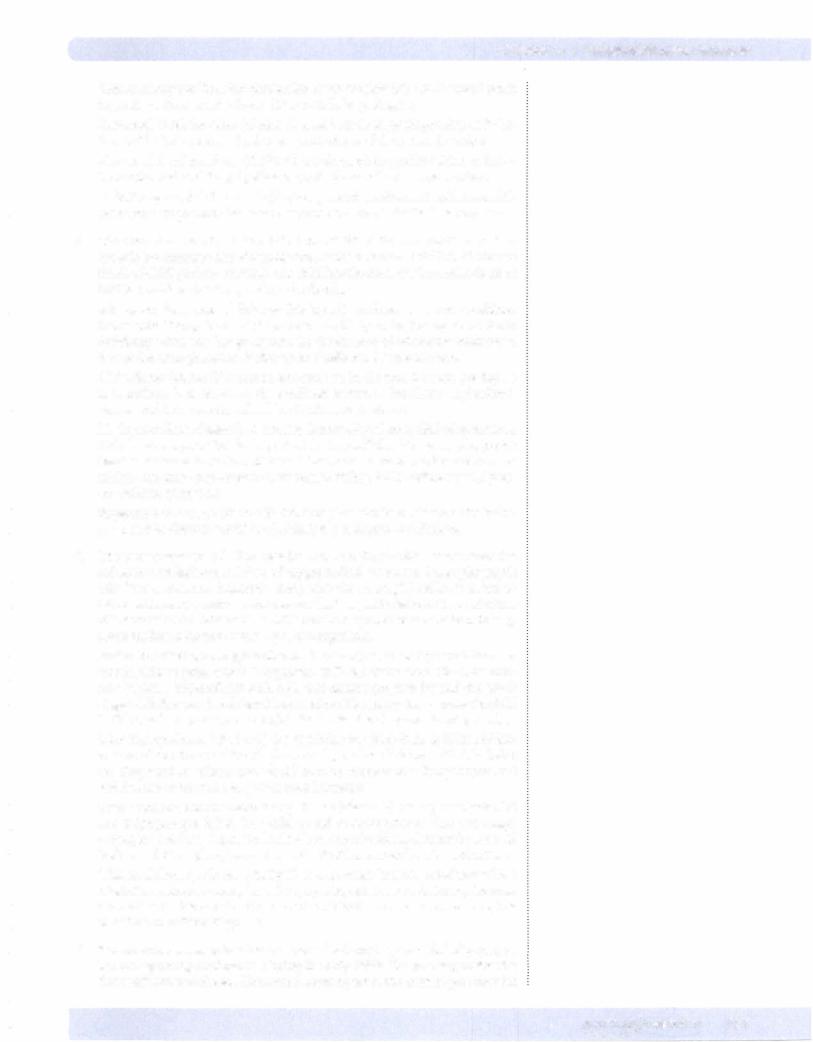
Chapter u • Immunodeficiency Diseases
Abnormal superoxide anion productionbyneutrophils (choiceA) wouldresult in predisposition to infections with extracellular pathogens.
Abnormal T-cell function (choice B) would result in predisposition to infec tions withviral and fungal pathogens, not edema ofthe mucosal surfaces.
Abnormal T-cell numbers (choice C) would result in predisposition to infec tions withviral and fungal pathogens, not edema of the mucosal surfaces.
Defective neutrophil chemotaxis (choiceD) wouldresult in neutrophilia and fail ure to produce pus and abscesses in response to extracellular bacterial invasion.
5.The correct answer is D. The infections of this child with catalase-positive
bacteria are characteristic of chronic granulomatous disease (CGD). While two thirds of CGD patients are male, one third has the autosomal recessive form of NADPH oxidase deficiency and can be female.
Adenosine deaminase deficiency (choice A) produces a severe combined immunodeficiency. The infections seen are likely to be the result of T-cell deficiency (viral and fungal agents). In the absence of adenosine deaminase, deoxyadenosine phosphate builds up in T cells and is toxic to them.
Cl inhibitor (choice B) is not an enzyme, and its absence does not predispose to infections. It is absent in the condition known as hereditary angioedema, representedby recurrent, painful bouts ofmucosal edema.
Myeloperoxidase (choice C) deficiency is normallywithout clinical symptoms. This is an enzyme that is important in intracellular killing in phagocytes because it causes formation of toxic halide radicals. However, because oxygen radicals are more important in intracellular killing, MPO deficiency willpres ent without symptoms.
Superoxide dismutase (choice E) deficiency has not been described in leuko cytes, and its absence would not be likely to predispose to infection.
6.The correct answer is B. The negative result on the nitroblue tetrazoliurn dye
reduction test indicates a failure of oxygen radical generation inside phagocytic cells. It is a common diagnostic, along with the neutrophil oxidative index, to diagnose chronic granulomatous disease. This is a geneticdefectin theproduction of a subunit of NADPH oxidase and is usually diagnosed when children develop recurrent infections with catalase-positive organisms.
Bruton X-linked agammaglobulinemia (choiceA) is caused by a mutation in a tyrosine kinase gene, which is important in B-cell maturation. The bone mar row becomes hypercellular with cells that cannot progress beyond the pre-B stage, while the peripheral blood lacksmature B lymphocytes. Because the child in this case has normal immunoglobulin levels, this diagnosis is not possible.
DiGeorge syndrome (choice C) is a condition in which there is failure of for mation of the third and fourth pharyngeal pouches. Children with this defect are diagnosed in infancy and would have an absence of T lymphocytes and deficiencies ofcalcium and parathyroid hormone.
Severe combined immunodeficiency disease (choice D) usually manifests first as a T-lymphocyte defect. The child would be susceptible to viral and fungal pathogens and have depressed levels ofimmunoglobulins, decreased counts of both B and T lymphocytes, and normal nitroblue tetrazolium dye reduction.
Wiskott-Aldrich syndrome (choice E) is a complex immune deficiency with a triad ofsymptoms: eczema, thrombocytopenia, and immunodeficiency. Because the mother in this case is not aware of any bleeding dyscrasias or eczema, this would be an unlikely diagnosis.
7.The correct answer is B. This is a case of X-linked agammaglobulinemia, or
Bruton agammaglobulinemia. During the early 1990s, the gene responsible for this conditionwas cloned. The normal counterpart ofthe mutant gene encodes
M EDICAL
127
_ __
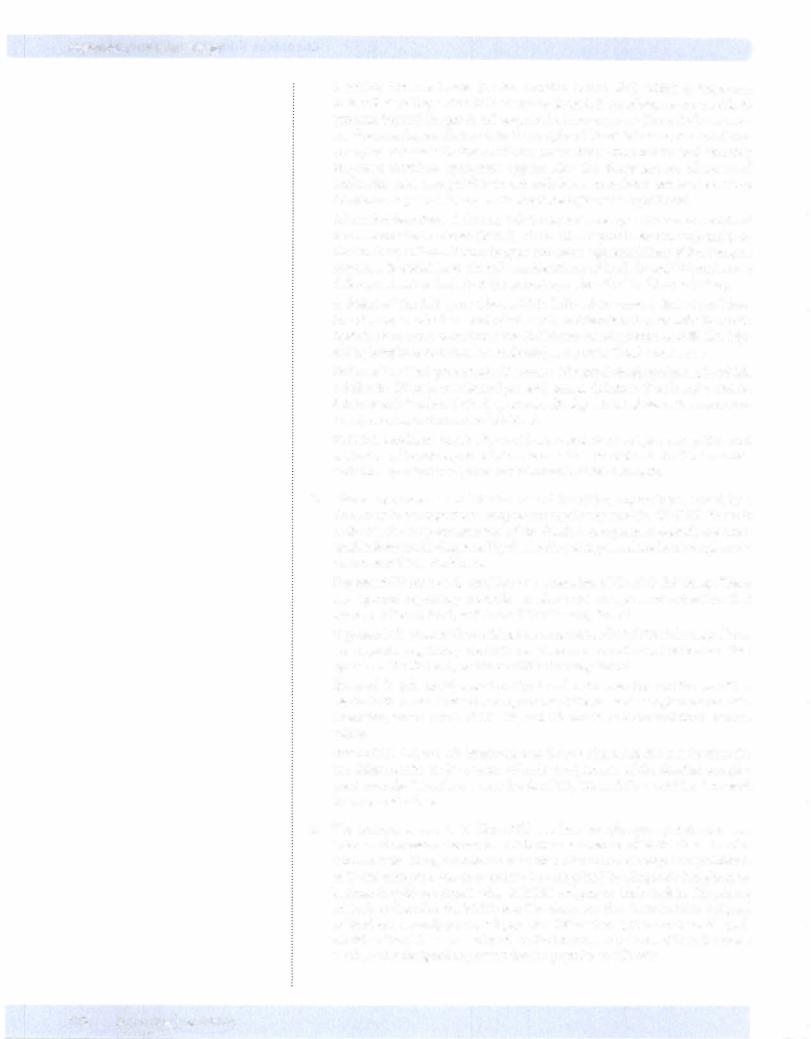
Section I • Immunology
a protein tyrosine kinase (Bruton tyrosine kinase, Btk), which is important in B-cell signaling. When it is absent or altered, B lymphocytes are unable to progress beyond the pre-B cell stage in the bone marrow. Thus, the bone mar row becomes hypercellular, while the peripheral blood is lacking mature B lym phocytes. Persons with this condition are unable to mount a normal antibody response; therefore, symptoms appear after the disappearance of maternal antibodies, and susceptibility to extracellular, encapsulated pathogens such as
Streptococcus pneumoniae and Haemophilus influenzae is profound.
Adenosine deaminase deficiency (choiceA) is an example of a severe combined immunodeficiency disease (SCID). When this enzyme is absent, toxic metabo lites build up in B and T lymphocytes and cause a general failure ofthe immune response. It would have clinical manifestations of both B- and T-lymphocyte defects, and not exclusively B lymphocytes, as described in this case history.
A defect of the SAP gene (choice C) is believed to cause X-linked prolifera tive disease, in which uncontrolled T-cell proliferation follows infection with Epstein-Barr virus. SAP stands for SLAM-associated protein, and SLAM (sig naling lymphocytic activation molecule) is a potent T-cell coactivator.
Defect of the WAS gene (choice D) causes Wiskott-Aldrich syndrome, in which a defect in CD43 (a cytoskeletal protein) causes defects in T cells and platelets. Patients withWiskott-Aldrich syndrome display a triad of signs: thrombocyto penia, eczema, and immunodeficiency.
ICAM-1 deficiency (choice E) would cause defects of antigen recognition and activation of lymphocytes. ICAM- 1 is an adhesion molecule in the immuno globulin superfamily of genes and is bound by LFA- 1 integrin.
8.The correct answer is B. This is a case of hereditary angioedema, caused by a deficiency in an important complement regulatory protein, Cl -INH. When it is absent, the early components of the classical complement cascade are over used. It is normally diagnosed by the finding of depressed levels of complement component C4 in the blood.
Depressed C3 (choiceA) would not be a correlate of C1 -INH deficiency. There are separate regulatory controls on abnormal complement activation that operate at the C3 level, so this condition is rarely found.
Depressed CS (choice C) would not be a correlate of C1-INH deficiency. There are separate regulatory controls on abnormal complement activation that operate at the CS level, so this condition is rarely found.
Elevated Cl (choice D) would not be found in this case because the condition results in the overuse of early components of the classical complement cascade. Therefore, serum levels of Cl, C4, and C2 would be decreased from normal values.
Elevated Cl, C4, and C2 (choiceE) would not be found in this case because the condition results in the overuse of early components of the classical comple ment cascade. Therefore, serum levels of Cl, C4, and C2 would be decreased from normal values.
9.The correct answer is B. This child has bare lymphocyte syndrome, a rare autosomal-recessive disease in which there is absence of MHC class II mole cules on cells. Thus, her cells can recognize other cells as foreign and proliferate to T-cell mitogens, but they cannot be recognized by allogeneic lymphocytes because they do not express class II MHC antigens on their surface. The phrase which best describes the MHC class II molecule on this list is that it is designed to bind exogenously processed peptides. Other descriptions that could apply would be that it has two chains of similar length, is produced with an invariant chain, and is designed to present foreign peptides to TH cells.
1 28 MEDICAL
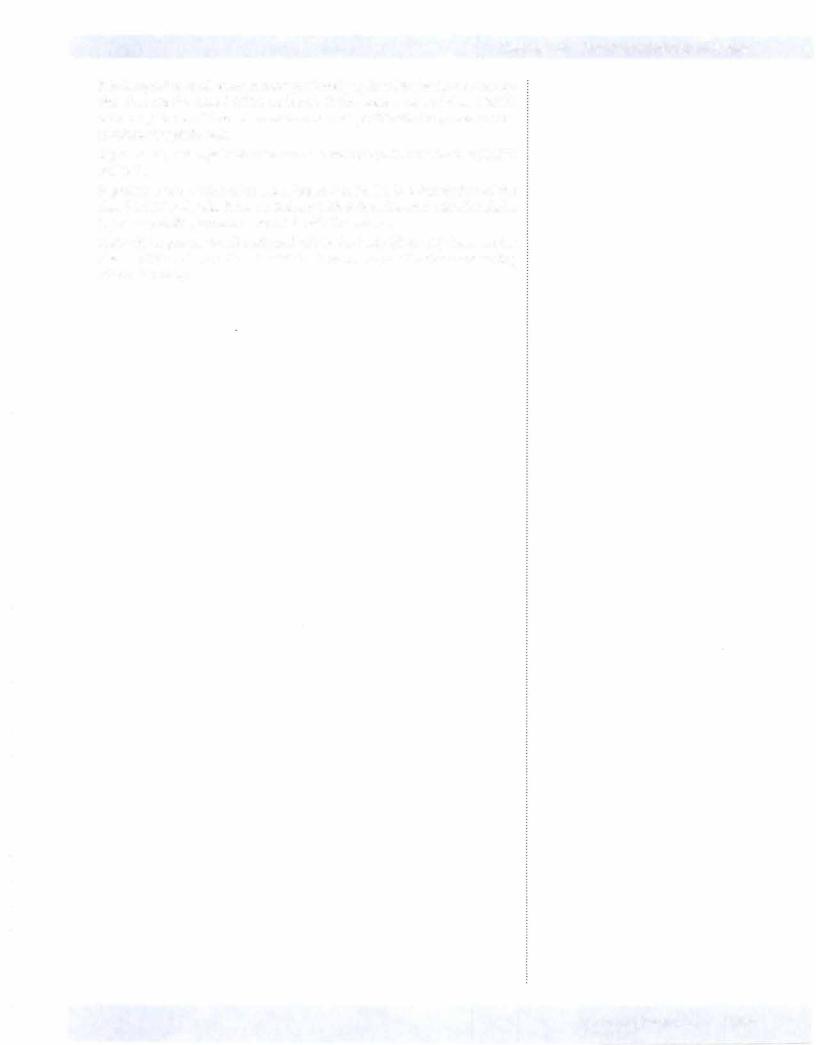
Chapter u • Immunodeficiency Diseases
It is designed to bind endogenously produced peptides (choiceA) is a descrip tion that fits the class I MHC molecule. If this were a case of class I MHC deficiency, she would not have made a normal proliferative response to mis matched allogeneic cells.
It possesses P2 microglobulin (choice C) is a description that fits the class I MHC molecule.
It possesses two chains of unequal length (choice D) is a description of the class I MHC molecule. It has an a chain with 3 domains, and a smaller chain, P2 microglobulin, becomes associated with the a chain.
It should be present on all nucleated cells in the body (choice E) describes the class I MHC molecule. Class II MHC will be found on all antigen-presenting cells in the body.
MEDICAL 129

